




























































































One of the biggest lessons that was concretized once again for me this year was how we are all so connected. The massacre on October 7 cemented the conviction that all Jews –regardless of affiliation or sect – are truly part of one unit. And when one person is hurting, we all feel their pain.
Unfortunately, we don’t always remember that. We sometimes forget when we look at each other and see just our outer trappings. Those outer trappings look different and are sometimes foreign to us. They can be shtreimels or hats or even tattoos. But when we look past that and peer beneath anything that can be dividing us, we see the soul, the neshama, within, and we connect with that divine spark that each of us carries close to our hearts.
That spark makes us whole. That spark reminds us that we all are part of one G-dly nation, a group that has been endowed with a holy mission and an elevated mandate.
That spark may be small, but it is substantial. And when we join together, when millions of sparks connect, we can create a fiery force, a strength that can knock down the Heavenly doors and bring about salvation and redemption.
As we approach the new year, most of us are coming into Rosh Hashana with trepidation. We remember davening last year, and we never could have antici-
pated what that year would bring. If we would have known, if we would have had a glimpse, if we would have had a hint, we would have stormed the Heavens, we would have davened so differently, we would have…we would have…. And yet, here we are again. Another year. So much is behind us. So much pain and hurt and tragedy.
But this year, when we come on Rosh Hashana, we will be storming the Heavens, begging, pleading, beseeching for a good year filled with all the blessings and rachamim. But when we daven, we won’t be davening alone. This year, we will be bringing with us a collective force, a fiery power to ask our King to remember us for a good year, to write us all in the Book of Life, to endow us with a future filled with copious, profound bracha and yeshuah.
That force can overpower any evil decrees. That force can help to remind our King that His children love each other and are there for each other. That force can propel us into a year filled with shalom and bracha and success in all areas of life for all of us. That force, that collective power that we have, will bring all of Klal Yisroel only closer to a time when we will all join together in our Homeland, may it be soon.
Wishing you a kesiva v’chasima tova, Shoshana

Yitzy Halpern, PUBLISHER publisher@fivetownsjewishhome.com
Yosef Feinerman, MANAGING EDITOR ads@fivetownsjewishhome.com
Shoshana Soroka, EDITOR editor@fivetownsjewishhome.com
Nate Davis
Editorial Assistant
Nechama Wein
Copy Editor
Rachel Bergida Shana Brecher
Lani White
Design & Production
Gabe Solomon Distribution & Logistics
P.O. BOX 266
Lawrence, NY 11559
Phone | 516-734-0858
Fax | 516-734-0857
Classified Deadline: Monday 5:00PM classifieds@fivetownsjewishhome.com text 443-929-4003
PAYMENT VIA CREDIT CARD MUST BE SUBMITTED ALONG WITH CLASSIFIED ADS
The Jewish Home is an independent weekly magazine. Opinions expressed by writers are not necessarily the opinions of the publisher or editor. The Jewish Home is not responsible for typographical errors, or for the kashrus of any product or business advertised within. The Jewish Home contains words of Torah. Please treat accordingly.















Dear Editor,
As a single myself, I appreciated the article where one gave tips on what to do on dates, although I’m not in full agreement with her.
However, she did make a mention about the neutral dates – if we don’t dislike each other, but don’t necessarily like each other (i.e., undecided), we keep on dating until one of us ultimately knows. This is realistic, and everyone advised me as such.
All that being said, I got an email this morning about the shidduch crisis –something that I’ve heard for years, but never understood what it was or what it was about.
Folks, I’m here to tell you to get real:
The real shidduch crisis we’re currently facing are shidduch resumes and, I’m sorry to say, shadchanim who claim they will help but do absolutely nothing and just make a bigger pile of ignored shidduch resumes of singles struggling to find their second half.
You just cannot judge a person by what you see on paper. After all, resumes all pretty much say the same thing: that they are a nice person, which shuls the daven at, schools attended, and more basic information. What point is there to mentioning what the siblings or the parents do or not do? You’re marrying the girl, not the parents, and certainly not the siblings.
I very rarely look at the shidduch resumes – at most, I quickly skim through

them. And I, for sure, rarely call the references, unless I’m suspecting a red flag. In all seriousness, I’ve had a bunch that either lied about the girl, or gave me too vague of information, as they’ll say (or not say) anything to get their friend or family member married.
I just simply meet just about anyone I’m recommended, automatically, for the most part. I rarely turn anyone down, unless there is a specific reason to. Especially if they are local, it’s not the biggest deal to take them out for a $25 coffee date, grab two lattes and maybe a Danish or two, and chat about our hobbies for an hour or so.
The world, sadly, is losing its common sense in the shidduch world.
And by the way, if every now and then, the girl can chip in for a date, even if it means paying for her meal, or chipping in for gas, even if it’s just $5 or $10, it’s greatly appreciated. It’s a lot for the man to go out of his way with his time and money. They should think about how he feels and what they are going through. Although, unfortunately rare, I did have a few dates who extended the courtesy of a ride in their car (rather than mine), or paying for their drink (even after I offered to cover it), or even explicitly telling me not to spend money on something. It was just the courteous thing to do.
L’Shana tova to all, Single looking for common sense
Continued on page 16


Continued from page 14
Dear Editor,
This week’s article, “Top 3 Changes To Make In Your Dating Life,” gave good advice, but sometimes when I read these articles, it makes me feel so frustrated. I have my “list” of non-negotiables. I feel that I am open to new suggestions. I don’t end things with someone just for something small. And yet, I haven’t yet met “the one.”
It is a herculean task for me to constantly remind myself that I have been put into this situation by Hashem for a reason; that I have value and worth even though I am not married. Sure, marriage is important and it’s a goal that I have. But I need to remind myself that I should not put my life on hold waiting around for a spouse. I need to enjoy the stage that I am in and look for growth in opportunities that are extended to me now.
That, I feel, is so important as I navigate this stage.
Dear Editor, I was recently at a program that hosted a few family members of hostages. One lady was discussing her cousin. She told over that it was confirmed by released hostages that her cousin has taken upon himself to now keep Shabbos. Because of this, he doesn’t use the flashlight that the Hamas captors gave him to use on Shabbos, instead remaining in the dark the whole time.
It’s quite extraordinary that our brother in captivity has taken on darkness to sacrifice for the Creator. This should awaken the great glory of G-d.
Rabbi Eytan Feiner had a wonderful thought relating to the word Melech, king. Spelled backwards, Melech is kulam, everything. G-d is everything, and we are all a part of Him. We encompass His success in this world through our personal and national victories. We know the well-known Gemara (Bava Kamma 92a), that those who daven for others will have their prayers answered first. Praying for the physical and spiritual release of the hostages can bring us physical and spiritual salvation as well.
Dovid HaMelech famously says, “Lulei he’emanti lir’ot b’tuv Hashem b’eretz chaim – Had I not the assurance that I would enjoy the goodness of the L-rd.”
The letters in the word lulei spell Elul. Dovid here is expressing his confidence and belief in G-d.
Elul and Rosh Hashanah are times of belief and optimism for the curses of Ki Tavo are behind us and the blessings of
the new year are upon us.
Steven Genack
Dear Editor,
As we close out this year, we all need to feel Hashem’s loving embrace, as He clearly brings victory to the Jewish nation at this time. In the past week alone, Israel has practically wiped out the top leaders of the Hezbollah terror group. And that, have no doubt, is all Hashem. It is He Who is leading us to this victory.
As we head towards Rosh Hashana, let us remember Who is King of Kings and to Whom we can rely to and direct our prayers for success.
Chaim Lieberman
Dear Editor,
Just a reminder for those Jews who think that they will vote for Kamala Harris over Donald Trump because he is not a nice person and a “threat to democracy.” As Joe Biden said, all of Biden’s decisions were made with Kamala Harris, and she is inexorably tied to his policy failures. She agreed with Biden on the horrendous Afghanistan withdrawal resulting in loss of American life and serving up both the air base near China’s nuclear development site as well as leaving billions in state- ofthe-art military equipment. Regardless of whether you call her a “Border Czar,” Kamala is responsible for the invasion of our country by 10 million+ illegal aliens, and also a unique government-sponsored phone app that allows hundreds of thousands of illegals to fly into our country without crossing the Rio Grande. She was the tie-breaking vote in the Senate on the “Inflation Reduction Act” that created inflation despite its title. Kamala did nothing to stop the invasion of Ukraine, and has not done anything but supply endless dollars to fighting a war that killed at least one million+ and could end up with World War III. She is also the individual who lifted sanctions on Iran, enabling them to garner 200+ billions of dollars that they distributed to Hamas, Hezbollah, and the Houthis making October 7, 2023 a living hell that continues to this day. Israel is alone fighting a war in which they have to provide humanitarian aid to the enemy. Kamala never mentions American hostages who were killed or remain in Hamas custody, but she continually asks the Israelis to agree to their own annihilation because of the two-state solution that she supports.
Jan Henock
Woodmere, NY


After five attempts, Shigeru Ishiba, a former defense minister, has finally become the leader of the Liberal Democratic Party and will become Japan’s new prime minister in October after the country’s parliament meets. Ishiba will succeed Prime Minister Fumio Kisidha, who said in August that he would not pursue a second term in office due to several party controversies.
Ishiba, 67, won his party’s contest,
competing against eight other candidates, including Sanae Takaichi, the economic security minister who could have been the first female premier of Japan, whom he defeated in a 215 to 194 vote runoff, and Shinjiro Koizumi, the son of Junichiro Koizumi, who was a popular former prime minister.
The conservative party that he now leads has been in control of Japan since the LDP’s founding in 1955, with a few brief breaks in between when a different party led the island nation. Ishiba is a relatively progressive outcast in his party and has previously had the courage to speak out and disobey the LDP.
After his victory, Ishiba said his party could be “reborn and regain the trust of the people,” following a series of scandals that wrecked the LDP’s reputation. Some party members have allegedly engaged in illegal economic activities.
“I will believe in the people, speak the truth with courage and sincerity, and I will do my utmost to make this country a safe and secure place where everyone can live with a smile on their faces once again,” Ishiba said.
Among the incoming prime minister’s many promises, Ishiba has vowed to end his country’s high inflation rates and cultivate “growth in real wages.” He has also

voiced his support for the establishment of a NATO-like organization composed of several Asian countries meant to protect each other from China and North Korea, and he supports Japanese independence from nuclear energy, promoting renewable sources instead.
Once the United States elects its next leader in November, Ishiba will be tasked with cultivating Japan’s relationship with the new U.S. president.

After three days of monsoon rains in Nepal, flooding and landslides across the country have led to the deaths of at least 104 people. At least 73 people have been injured, and 64 are still missing, the Nepal Police said. Most of the deaths were
reported on Saturday.
On Sunday, as the rains calmed down, rescuers were able to reach more remote locations via helicopter to pull people from their homes that had been destroyed by landslides. They were also able to retrieve the bodies of those who had perished in the natural disaster.
Binod Ghimire, a senior superintendent of police, said that more than 5,000 police personnel equipped with helicopters, rafts, ropes and vehicles had been deployed. More than 3,000 people were able to be rescued, but people are concerned that the rescues are taking too long.
Nepal’s prime minister, K. P. Sharma Oli, who was in the United States to attend the U.N. General Assembly, faced criticism at home for the rescue operations.
Many parts of the country were without power. “Several districts are disconnected from communication, so we are struggling to compile loss of lives and properties,” said Dan Bahadur Karki, a spokesman for the Nepal Police.
The disaster occurred just as Nepalis were preparing to celebrate the Hindu festival of Dashain, set to begin on Thursday. Hindu devotees travel for days to far-flung villages to obtain the blessings of their elders.


20 Nepal has a population of about 30 million. In recent years, it has been hit by many natural disasters, including the bursting of glacial lakes.

For 17 months Sudan’s army has been battling the Rapid Support Forces (RSF). On Thursday, the army launched airstrikes in the capital in a bid to regain ground there.
The push by the army, which lost control of most of the capital at the start of the conflict, came ahead of an address by its commander, General Abdel Fattah al-Burhan, at the United Nations General Assembly in New York later in the day.
Troops tried to cross bridges across the Nile connecting the three adjoining cities that make up the greater capital, Khartoum, Omdurman and Bahri.
“The army is carrying out heavy artillery strikes and air strikes on Halfaya and Shambat,” Ahmed Abdalla, a 48-year-old resident, related, referring to areas of Bahri close to the river. “The sounds of explosions are very loud.”
Army sources said their forces had crossed bridges in Khartoum and Bahri.
The RSF told Reuters it had thwarted the army’s attempt to cross two bridges to Khartoum.
Though the army retook some ground in Omdurman early this year, it depends mostly on artillery and airstrikes and has been unable to dislodge RSF ground forces embedded in other parts of the capital.
The RSF has also continued to make advances in other parts of Sudan in recent months. The conflict has displaced more than 10 million people, thrusting millions into extreme hunger or famine. Attempts to calm tensions have been rebuffed with the army refusing to attend talks last month in Switzerland.
This month, the battle for control of al-Fashir, the capital of North Darfur state in the west of Sudan, has also intensified as the RSF has tried to advance from po-

sitions surrounding the city against the army and allied former rebel groups.
Al-Fashir is the last army holdout across the Darfur region, where the U.N. and rights groups say the RSF and allies have led ethnically-targeted attacks and the humanitarian situation is particularly critical. The RSF has denied being behind the violence. The UN human rights office says that it has documented instances of executions, violence, assaults, and abductions of women and young men in al-Fashir.
The war began when tensions between the RSF and the army, who had been jostling for position ahead of an internationally-backed transition to civilian rule, erupted into open conflict. The army and the RSF had previously shared power after staging a coup in 2021, two years after veteran autocrat Omar al-Bashir was toppled in a popular uprising.

Zuckerberg is rolling in the dough. The Meta CEO has grown his personal fortune by a whopping $73.4 billion in 2024 to $201 billion. He is now the fourth richest person in the world, according to the Bloomberg Billionaire Index.
Tesla and X CEO Elon Musk ($272 billion); Jeff Bezos ($211 billion), the founder of Amazon; and Bernard Arnault ($207 billion), the CEO of luxury brand LVMH, are the only people ahead of Zuckerberg.
Zuckerberg, 40, launched Facebook in 2004. Shares of Meta have surged by nearly 64% in 2024. On Wednesday, Meta shares gained 0.9% to close at a record high of $568.31. Meta shares dipped to $567.36 on Friday.
Meta operates popular social media platforms Facebook, Instagram and Threads, as well as the instant messaging app WhatsApp.
Speaking on Wednesday at the Meta Connect 2024 event, Zuckerberg said Meta AI is on track to become the most used assistant in the world.
“We’re almost at 500 million monthly (active users), and we haven’t even launched in some of the bigger countries yet,” Zuckerberg said, referring to coun-
tries in the European Union.
Zuckerberg isn’t the only tech mogul to see a big jump in their fortune this year.
Jensen Huang, CEO of Nvidia, and Larry Ellison, co-founder of Oracle, have seen their net worths surge in 2024 by $62.2 billion and $58.6 billion, respectively.
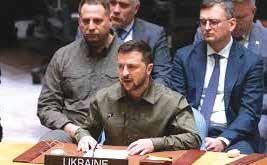
President Volodymyr Zelensky of Ukraine urged the United Nations on Wednesday to prevent Russia from freezing the war as it is now, saying that the Kremlin “still wants even more land — more land, which is insane, and is seizing it day by day while wanting to destroy its neighbor.”
Those nations pushing to end the conflict were ignoring the wishes of the Ukrainian people, he said in an address to the U.N. General Assembly, and were encouraging President Vladimir Putin’s expansionary aims.
With Zelensky also using meetings at the United Nations and in Washington on Thursday to seek approval to strike deeper into Russia with Western missiles, Putin issued his own riposte.
The Russian leader, who was not attending the U.N. meeting and often rattles the nuclear saber when he feels that Russia is facing setbacks in the war, suggested Wednesday that Russia should be able to respond with nuclear weapons if it were attacked by a state supported by a nuclear power. Ukraine falls into that category.
Issues of war and peace have dominated discussion at this year’s General Assembly. “The prospect of an all-out war between Israel and Hezbollah has heightened this sense of general fragility around the U.N.,” said Richard Gowan, the U.N. director for the International Crisis Group.
Yet a yawning gap between Western capitals and the rest of the world over the wars in Ukraine and elsewhere had been starkly evident throughout the annual U.N. gathering. Leaders from the Global South nations have taken little note of Ukraine, while devoting far more attention to the humanitarian crises in the Gaza Strip and Sudan.

Russia, which has vetoed every attempt by the Security Council to bring an end to the war in Ukraine, made clear that it would not stop the war until the country was free from what Vassily Nebenzia, the Russian ambassador, called nationalism, Nazism and other discrimination. Among other false claims that Russia habitually makes against Ukraine, one is that Nazis dominate its government. (© The New York Times)

To Americans, dogs are man’s best friend. But in South Korea, the animal has been, for hundreds of years, considered a delicacy. However, that is expected to change in 2027, when slaughtering, selling, and breeding dog meat will offi-
cially be a crime punishable by two to three years in jail, as per a bill passed in January by the parliament of South Korea.
According to the Agriculture Ministry, once the ban is put into effect, dog farmers will be compensated with 225,000 won ($170) for each dog they have to give up. And, if the farmers close down their dog farms early, they could receive up to 600,000 won ($450) for each dog –an incentive meant to promote an early phase-out.
However, a group of dog farmers recently declined to accept the government’s offer, pointing out that the compensation is too low. Previously, they urged the government to compensate them with 2 million won ($1,505) for each dog. The farmers have vowed to fight the ban, which they say will burden them economically and rob them of their ability to select their profession freely, and are currently advocating for the current three-year grace period, which ends in 2027, to be extended, and for the compensation package to be more generous.
Sangkyung Lee, Humane Society International’s Korean anti-animal cruelty group campaign manager, said South Korea’s move was “an important milestone in this historic ban that will see the ban
through to completion and end our country’s dog meat era for good.” He added that his office is “disappointed” that the government has proposed to compensate the farmers for each individual dog, as the farmers might start “potentially increasing dog breeding to get more money from the scheme and more puppies being born into suffering.”
The Seoul-based Korean Animal Welfare Association called on local governments to keep an eye on dog farms to ensure that farmers aren’t breeding the animals to expand their farm and, as a result, make more money from the compensation deal. The organization applauded the government’s efforts to quickly end dog farming through “reasonable” measures, and condemned the farmers association for demanding higher compensation.
The majority of people in South Korea do not consume dog meat, though the country has the only industrial-scale dog farms in the world. Dogs are also a delicacy in Indonesia, China, Vietnam, and a few countries in Africa. According to recent polls, two in three South Koreans support the ban. South Korea’s first lady, Kim Keon Hee, was very vocal about her stance against dog farming.
According to Park Beomsu, the Vice
Agriculture Minister, there are around 466,000 dogs in South Korea that are being raised to be slaughtered and consumed. Following the ban’s enactment, the dogs that are still alive will likely be put into the animal adoption system or brought to care facilities, Park added.

According to two U.S. defense officials, China’s newest nuclear-powered submarine sank pier-side in the spring. The Chinese Navy tried to conceal the loss.
The attack submarine was the first of its new Zhou-class line of vessels, the official said, under construction at a shipyard near the city of Wuhan. The Zhou-class submarines have a distinctive X-shaped



stern, designed to improve maneuverability underwater.
A satellite image from March 10, taken by Maxar Technologies, shows the Zhouclass sub, with its signature x-shape tail, docked at the port. But imagery from June shows that the sub did not return to the pier.
“It’s not surprising that the PLA Navy would try to conceal the fact that their new first-in-class nuclear-powered attack submarine sank pier-side,” said the se-
nior U.S. defense official.
Tom Shugart, an adjunct senior fellow at the Center for a New American Security who routinely studies satellite imagery of Chinese shipyards, was the first to notice that something was not right at the pier.
“I’ve never seen a bunch of cranes clustered around (one spot),” Shugart said. “If you go back and look at historical imagery, you can see one crane, but not a bunch clustered there.”
He also noticed that it was a subma-
latest China military power report from 2023, the PLA Navy operates six nuclearpowered ballistic missile submarines, six nuclear-powered attack submarines, and 48 diesel-powered attack submarines.
The U.S. Navy has 53 fast attack submarines, 14 ballistic-missile submarines and four guided-missile submarines. The entire U.S. submarine fleet is nuclear-powered.
China is also working on expanding its ability to produce new submarines. Even as the PLA Navy retires older submarines, China is expected to have 65 submarines in 2025 and 80 in 2035 because of the growth in its submarine construction capacity, according to the Congressional Research Service (CRS).
China has the world’s largest Navy by number of ships. The PLA Navy has 370 platforms, which includes 234 warships, according to CRS, while the U.S. has 219 warships. The U.S. has identified China as its long-term “pacing challenge.”

The “world’s koala capital” is Brisbane, the capital city of Queensland, Australia. But even there, the koala bear population remains in decline, as the species is having a challenging time adapting to an urban environment. Many have been attacked by dogs or hit by cars, while some have been plagued with infectious diseases such as chlamydia. Over 5,000 koalas have been treated at two veterinary hospitals in South East Queensland, although 66% were put to sleep due to poor survival chances.
rine of a larger size and had a distinctive tail, indicating a new class of submarine.
“Usually, those submarines, after they get launched, they’re there at the shipyard for several months in outfitting. And it wasn’t there anymore,” Shugart said.
Beijing has made the modernization of the People’s Liberation Army (PLA) Navy and its submarine force one of its highest priorities as it seeks to build a world-class military on par with the United States. According to the
In 2022, the species was classified as endangered, but the situation has yet to improve for the koalas, despite the 10year national recovery plan that Australia started that same year to end the decline and boost the population and quality-of-life of the cuddly animals. Although millions of dollars were invested into the effort, their chances of survival are still “poor,” as per an annual report published last May.
While the koala population decline has steadied in forests, in cities and partly-rural places, the population remains unstable because of “human activity and

domestic dogs,” explained a spokesperson for the Department of Environment, Science, and Innovation (DESI), adding that the government of Queensland has seen some positive results due to the state’s implementation of the “strongest koala habitat protections ever seen.”
Tim Portas, a veterinarian, believes that “within 20 or 30 years, if things don’t change, they’ll be gone in southeast Queensland.”
The Australian federal government pledged 76 million Australian dollars ($52 million) towards the Saving Koalas Fund over the span of four years in order to “support the recovery and the long-term conservation of the koala and its habitats.” The state government of Queensland included an additional 31 million Australian dollars ($21 million) in its newest budget for saving koalas. And in an effort to prevent human development on koala habitats, around half of the over 714,000 hectares of designated koala territory has been exempt from any sort of building. Additionally, Queensland, according to a spokesperson, is determined “to commence rehabilitation to restore 10,000 hectares of koala habitat in South East Queensland by 2025,” a goal that isn’t quite as ambitious as conservationists had hoped.
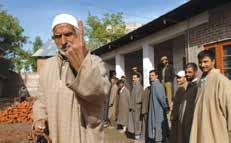
The former state of Jammu and Kashmir – now divided into two federally administered territories – is holding its first assembly election in a decade. The third and last phase of voting is on Tuesday and results will be declared on October 8.
Kashmir has been wracked by violence since the 1900s, as an armed separatist insurgency against Indian rule in the region has claimed thousands of lives, including those of civilians and security forces.
Now, people are lining up to vote, an indication that people want to be heard.
“The level of poverty in our area is severe,” said 52-year-old Mohammad Yusuf Ganai after casting his vote. He laments that the lack of jobs has forced educated young Kashmiris to “sit at home.”

The last elections a decade ago resulted in a coalition government that collapsed in 2018. Before new polls could be held, India’s Prime Minister Narendra Modi’s Bharatiya Janata Party (BJP) government revoked the region’s autonomy and statehood, sparking widespread discontent among Kashmiris.
For five years, Jammu and Kashmir has been under federal control with no local representation. This election offers people a long-awaited chance to voice their concerns.
Nearly 150km (93 miles) away in Uri, the last town near the Line of Control –the de facto border with Pakistan-administered Kashmir – newly elected MP from the Awami Ittehad Party (AIP) Engineer Rashid addressed a frenzied crowd. In jail since 2019 on terror funding charges that he denies, Rashid was granted interim bail to campaign for the election.
People flocked to his motorcade, one seeking a selfie, another offering a jacket, as Rashid’s personal struggles appear to resonate deeply with voters.
“I want development and a resolution to the Jammu and Kashmir issue,” Rashid says. Being part of the system now as a lawmaker, he said, will help him raise these issues in Delhi.
The BJP government insists that scrapping the region’s special status and placing it under direct rule has brought peace and development, with Prime Minister Modi announcing $700m in projects during a visit in March. It’s now up to BJP candidate Engineer Aijaz Hussain in Srinagar’s Lal Chowk to convince voters of this message.
The Hindu nationalist BJP has been trying to make inroads in the Muslim-majority Kashmir valley, where it has had little presence.
Before 2019, when Jammu and Kashmir was a state, the chief minister could enact laws with the consent of the governor, who was bound by the state cabinet’s recommendations.
Now, as a federal territory under a Lieutenant Governor (LG), the chief minister must get the LG’s approval, especially on sensitive issues like public order, appointments and prosecutions. Power has shifted, as the LG won’t act without clearance from the federal home ministry.
Despite the challenges, many in Kashmir hope these elections will give them a chance to finally have their own representatives to voice their concerns.

Mexico’s Senate on Wednesday approved a constitutional amendment that would put the country’s national guard, created to fight crime, under the military’s control, deepening the penetration of the armed forces into another corner of civilian life.
The measure easily passed in the Senate, where the governing party holds a large majority. Those voting in favor argued that the national guard would be more effective and less subject to corruption under military command, brushing aside arguments by opposition legislators that the move would make the military too powerful.
The Senate’s vote came less than two weeks after another major change was made to Mexico’s Constitution to remake the judiciary by having judges voted into office rather than appointed. Critics say both moves are examples of the government’s efforts to concentrate power in its hands.
For Mexico’s departing president, Andrés Manuel López Obrador, whose term ends next week, Wednesday’s vote represented a major victory. He has long pushed for the military to take over the national guard, something his successor, Claudia Sheinbaum, has also embraced.
“If it becomes, like the army and the air force, a branch of the Ministry of Defense, we have the guarantee that it will remain and will continue to act with rectitude,” López Obrador told reporters last week.
But the move was immediately met with criticism by human rights groups and security experts, who said it would cement in the constitution the military’s control over policing and other aspects of public security and civilian life.
The amendment was already passed by Mexico’s lower house of Congress last week. It will now need a majority of state legislatures to approve it to officially become law. By Wednesday afternoon, three states had already approved it and more were expected to do so.


The constitutional change also authorizes the military to officially take over an increasing number of civilian tasks that have been assigned to it in recent years. These duties include managing airports and customs, protecting nature reserves, and operating infrastructure projects.
(© The New York Times)

Hassan Nasrallah, the secretary-general of the Hezbollah terror group, was eliminated on Friday by an airstrike from Israel that targeted his underground quarters in Beirut, Lebanon. Nasrallah, the leader of the Lebanon-based Iranian proxy group, was the terrorist organization’s top-ranking leader since 1992. His death was announced by the Israel Defense Forces and Hezbollah on Saturday.
As part of the same strike, Ali Karaki, the commander of the terror group’s Southern Front, was also killed. Ibrahim Hussein Jazini, head of Nasrallah’s personal security unit; Samir Tawfiq Deeb, an advisor to Nasrallah; Abd al-Amir Muhammad Sablini, responsible for Hezbollah’s force build-up; and Ali Nayef Ayoub, responsible for Hezbollah’s firepower, were also killed in the blast.
In the past few weeks, Israel has killed most of Hezbollah’s top officials.
Friday’s strike left some areas of Beirut filled with smoke and dust. Nasrallah was hiding out in the Dahiyeh, Hezbollah’s main underground base located beneath residential buildings in southern Beirut, and was hit by many bunker-busting bombs delivered by Israeli Air Force fighter jets. His body was retrieved from the blast site on Sunday.
According to Lt. Col. Nadav Shoshani, a spokesman for the Israeli military, the Jewish state had been tracking the Hezbollah leader for a number of years, and was successful in pulling off the assassination thanks to “real-time intelligence.”
Meanwhile, Hezbollah eulogized
rallah and stated that it would continue fighting Israel “in support of Gaza and Palestine, and in defense of Lebanon and its steadfast and honorable people.” Saturday morning, Hezbollah continued firing rockets at Tel Aviv and the West Bank.
“This is not the end of the tools in the toolbox. The message is simple: to anyone who threatens the citizens of the State of Israel, we will know how to get to them,” vowed Lt. Gen. Herzi Halevi, the IDF Chief of State, following the successful operation which was titled, “New Order.”
Shoshani added that although the terror group has been hit hard, it’s still strong, that “this isn’t a threat that has gone away.” He added that it’s “safe to assume” that Hezbollah will try to take revenge. However, the spokesman said that the Jewish state would like Nasrallah’s assassination to “change Hezbollah’s actions.”
After hitting the terror headquarters on Friday, the Israeli military notified local civilians to evacuate 500 or more meters away from the building above the Dahiyeh, noting that anti-ship missiles are stored in the vicinity.
“In the coming hours we are going to strike strategic capability that Hezbollah placed underground, under three buildings in the heart of the Dahiyeh,” said IDF Spokesman Rear Adm. Daniel Hagari. “Over the years, Hezbollah built and developed an array of coast-to-sea [missiles], that originate in Iran… We will now reveal how [Hezbollah] places strategic weapons under civilian buildings in the heart of the Dahiyeh.”
“These missiles are a real threat to world shipping lanes and strategic facilities of the State of Israel. In a short while, we will attack the weapons under the buildings. The intensity of the explosion of the weapons under the buildings will lead to damage to the buildings and could lead to their collapse,” Hagari said.
Shortly after the warning was issued, six missile warehouses in the area were struck, eliminating dozens of anti-ship missiles. Other areas in Lebanon were also struck. A day later, Hezbollah fired several rockets at places in Israel and at West Bank settlements. Most rockets were intercepted, and, thankfully, no injuries or significant damage were reported.
Hagari also said that the IDF would be preventing any weapons coming into Lebanon for Hezbollah, including through the international airport of Beirut.


Prime Minister Benjamin Netanyahu began his Friday address to the United Nations by stating that he wasn’t planning to speak to the U.N. but elected to after he “heard the lies and slanders leveled at my
country by many of the speakers at this podium.” He added that the international organization, which was once-respected but is now disgraced, is the “home court” for the Palestinians.
“They [the Palestinians] know that in this swamp of antisemitic bile, there’s an automatic majority willing to demonize the Jewish state for anything. In this anti-Israel flat-earth society, any false charge, any outlandish allegation can muster a majority,” Netanyahu said.
in 1945” to be part of Germany’s reconstruction. Netanyahu added that Hamas is nearly defeated, as twenty-three out of twenty-four of its battalions have been destroyed, and said that Israel will continue to fight until the terror group is completely obliterated and will, in the meanwhile, ensure that Hamas can no longer steal its civilians’ humanitarian aid and sell it for very high prices.

Several family members of Israeli hostages, some alive and some not, came to New York along with Netanyahu and sat in the gallery during his speech. At one point, Netanyahu pointed out each of the families and asked them to briefly stand. The prime minister, wearing a yellow ribbon that represents the mission of bringing the hostages home, noted that Israel’s “sacred mission” is freeing the abductees from Hamas captivity.
“Let them go. Let them go. All of them. Those alive today must be returned alive, and the remains of those whom you brutally killed must be returned to their families,” Netanyahu said, in “a message” to Hamas. “This war can come to an end now. All that has to happen is for Hamas to surrender, lay down its arms, and release all the hostages. But if they don’t, we will fight until we achieve victory, total victory; there is no substitute for it. Israel will win this battle, because we don’t have a choice.”
During his speech, the premier spoke about the conflict with Hezbollah, saying that “we won’t rest until our citizens return safely to our homes” and that “we will continue degrading Hezbollah until all our objectives are attained.”
On the subject of the war in Gaza, he said Hamas “has got to go” and noted how “inconceivable” it would be for the terror group to play a role in the future rebuilding of Gaza – as “ridiculous” as it would have been to allow “the defeated Nazis
Netanyahu themed his speech around the difference between Iran and Israel –darkness and peace – and touted a potential peace deal between Saudi Arabia and the Jewish state, which would see Israel “continue the path we paved with the Abraham Accords four years ago” and “transform the Middle East into a global juggernaut,” thus ushering “in a historic reconciliation between the Arab world and Israel, between Islam and Judaism, between Mecca and Jerusalem.”
“That is the choice we face today: the curse of Iran’s unremitting aggression or the blessing of a historic reconciliation between Arab and Jew,” the premier said. “Israel has already made its choice. We’ve decided to advance the blessing. We’re building a partnership for peace with our Arab neighbors while fighting the forces of terror that threaten that peace.

Mohammed bin Salman, the Saudi Crown Prince, reiterated in a speech two weeks ago that Saudi Arabia would only recognize Israel if a Palestinian state, with a capital in East Jerusalem, is established.
Netanyahu condemned Tehran and its nuclear program, calling on the U.N. Security Council to “snap back” sanctions against Iran. He also criticized Karim Khan, the chief prosecutor of the International Criminal Court, for trying to secure arrest warrants against him and Defense Minister Yoav Gallant, and condemned Palestinian Authority President Mahmoud Abbas for refusing “to condemn the horrific massacre of October 7” and for “still paying hundreds of millions to terrorists who murdered Israelis and Americans.”
According to an assessment released on Friday by the Israel Defense Forces, the Hamas terror group has now been reduced to a guerrilla organization that should be fully destroyed given some time, with its military basically eliminated.
Compared to how Hamas was orga-
nized before October 7, the terrorist organization has changed significantly with regard to its command and control, rockets, weapons, and army. Half or more of the Hamas terrorists have died since the war broke out on October 7, when the terror group invaded southern Israel, murdering 1,200 Israelis and kidnapping 251 others. Before the war started, Hamas had around 30,000 operatives in Gaza, five regional brigades, 24 battalions, and around 140 companies, according to the IDF. Every brigade had its own anti-tank missile array, air defenses, rocket firing array, and sniping and engineering teams, along with many regional outposts and strongholds, the Israeli military added. But since the war began, Hamas has lost most of its army.

According to the IDF, 18,000 Hamas terrorists have been killed since October 7, 1,000 of whom were eliminated in Israel on the day of the unspeakable tragedy.

Meanwhile, Israel has lost 348 soldiers in Gaza and near the southern border since the start of the Jewish state’s ground campaign into the Strip.
While defeating Hamas is the IDF’s most important goal in the war, it has given priority to the more urgent goal of rescuing hostages.
“If we wait, it is not certain that there will be anyone to return,” the IDF said.

Last Wednesday, the House and Senate voted to prevent a government shutdown with a short spending bill that will remain in effect until December 20, when Congress will once again have to figure out how to fund the government in what is expected to be an intense post-election political battle.
As per Republican presidential nominee and former president Donald Trump’s request, House Speaker Mike Johnson originally proposed a bill that tied government funding with the SAVE Act, a GOP-led initiative meant to prevent illegal immigrants from voting in the upcoming election. However, the bill failed when Johnson proposed it to the House last week, and he thus moved on to “Plan B,” a bill that would fund the government but wouldn’t fulfill the demands of Trump and other conservative members of Congress. That bill was approved by the House in a 341 to 82 vote, which saw 209 Democrats and 132 Republicans voting in support of the law, while 82 Republicans voted against the bill. In the Senate, 78 voted in favor, while 18 voted against.
President Joe Biden praised the House and Senate for “avoiding a costly government shutdown,” adding that it gives Congress “more time to pass fullyear funding bills by the end of the year.”
Trump’s thoughts on the bill are unclear. Though the former president opposed any government spending bill
that wasn’t tied to anti-noncitizen voting measures, Johnson insists that Trump realizes that it’s currently impossible to pass the SAVE Act due to a lack of congressional support for the bill. Many Republicans have noted that a government shutdown just over a month before the election would make it more difficult for the House to retain its Republican majority and for Trump to win back the presidency.
“We have to make tough decisions in leadership. This is the last available option to us,” said Johnson of his decision to team up with Democrats to pass the bill.
“None of us like it, but we can’t shut the government down 39 days before an election. It would be political malpractice.”
Johnson’s bipartisan move may prompt condemnation from members of his party, but he is, as of now, unlikely to be ousted from his position like former Speaker Kevin McCarthy was.
The bill included a $231 million package to fund the U.S. Secret Service so that it could better defend the lives of Trump, who has been the target of two recent assassination attempts, and Democratic presidential candidate Vice President Kamala Harris.

Sima Sistani, the CEO of WeightWatchers, is out as chief executive. An announcement from the weight loss company was made on Friday, and the demotion was effective immediately. Tara Comonte, a WeightWatchers board member and former Shake Shack executive, was named interim chief executive.
WeightWatchers did not say why Sistani was asked to leave. It noted that Comonte would step into the role of CEO at a time when the company is “focused on improving its operational and financial performance.”
The company was founded 60 years ago but has been struggling with slipping profits and costs increasing from restructuring efforts. WW shares are down more than 90% over the last year; now trading as a penny stock, they closed at about 83 cents on Friday.
Sistani joined WeightWatchers as CEO more than two years ago. During


her tenure, she led the company’s recent moves into the prescription drug weight loss business — particularly with the $106 million acquisition of Sequence, now WeightWatchers Clinic, a telehealth service that helps users get prescriptions for drugs like Ozempic, Wegovy and Trulicity
Prior to joining WeightWatchers, Sistani co-founded Houseparty, a now-discontinued social networking app that offered group video chatting. In addition
to serving as CEO of Houseparty, Sistani was previously a senior leader at Epic Games.
Comonte joined WeightWatchers’ board back in June 2023. Beyond her current position at WeightWatchers, she also serves on the boards of Kindbody and Strava.
In a statement, Comonte said she looked forward to working with WeightWatcher leadership “as we advance the company’s strategy to expand access and
in December 2023. At the time of her
parture, the company said that Winfrey aimed to “eliminate any perceived conflict of interest.”

In June, two NASA astronauts, Suni Williams and Butch Wilmore, flew to the International Space Station in a test flight of Boeing’s Starliner vehicle. But as problems developed with the Starliner’s propulsion system, the aircraft returned home without the two astronauts on board. On Saturday, two astronauts left Earth in the Crew Dragon spacecraft, leaving two seats empty for Williams and Wilmore to return home.
Nick Hague of NASA and Aleksandr Gorbunov of Russia were able to leave Cape Canaveral Space Force Station in Florida as the weather cleared from Hurricane Helene.
“Thankfully, we had a nice clear window in there,” Dana Hutcherson, the deputy manager of NASA’s commercial crew program, said. “We threaded a needle just perfectly.”
The Crew Dragon is scheduled to dock with the space station at 5:30 p.m. on Sunday. It had been lifted from Earth with the SpaceX Falcon 9 rocket. Since 2020, SpaceX has been conducting regular flights taking astronauts to the space station for NASA.
care during this critical period of our transformation.”
With Sistani stepping down from her position on the board, WeightWatchers said it would reduce the size of its board from nine to eight members. It had reduced its board size from ten to nine earlier this year after Oprah Winfrey stepped down. The talk show host had been on the board since 2015. The move came after Winfrey told People magazine that she was using a weight-loss medication
Twice a year, a Falcon 9 rocket would launch from NASA’s Kennedy Space Center, placing into orbit a Crew Dragon spacecraft with four astronauts aboard, who would join the space station crew. About six months later, the same four astronauts would get back into the Crew Dragon and head home to Earth.
This mission, named Crew-9, would have done the same, but now this Crew Dragon will be the ride home for Williams and Wilmore. That meant that two NASA astronauts slated for Crew-9, Zena Cardman and Stephanie Wilson, were bumped off this flight.
Cardman, Wilson, Hague and Gorbunov trained together for this mission for about a year and a half. Cardman was


to serve as the Crew-9 commander, but this would have been her first spaceflight, while Hague made a trip to the space station in 2019.
“I can really relate to how they must be feeling, but we’ll fly them,” Ken Bowersox, the associate administrator of NASA’s space operations mission directorate, said. “We’ll find them slots in the future.”
“It was hard not to watch that rocket lift off without thinking, ‘That’s my rock-
et, and that’s my crew,’” Cardman said as the rocket lifted off on Saturday.
Eric Adams, the mayor of New York City, became the city’s first mayor to be federally indicted while in office on Thursday morning when the federal
free-of-charge rooms at “opulent hotels,” meals at luxury restaurants, and “luxurious entertainment” by foreign nationals in Turkey. In exchange, the mayor supposedly pressured the city’s fire department in September 2021 to allow a new building for the Turkish consulate to open without completely inspecting the structure to ensure it complies with fire safety laws. Adams did not disclose the travel benefits and instead tried hiding the incident through various means, including by erasing texts and changing the password to his phone, the indictment added.

“Mayor Adams took these contributions even though he knew they were illegal,” charged Damiam Williams, the Southern District of New York’s U.S. attorney. “He knew these contributions were attempts by a Turkish government official and Turkish businessmen to buy influence with him.”
According to the indictment, Adams also accepted illegal campaign contributions during his 2021 campaign for New York City mayor.
On the morning of the indictment’s unveiling, federal officials reportedly went to Adams’ residence in Gracie Mansion, searched through his home for over three hours, and served him a summons.
In response to the indictment, Adams said he wasn’t surprised, urged New Yorkers to “wait to hear our defense before making any judgements,” and said he wouldn’t be making any immediate changes to the way he runs the city based on the charges.
“I look forward to defending myself and defending the people of this city as I’ve done throughout my entire professional career,” the mayor said.
government introduced five charges, including bribery, wire fraud, conspiracy, and soliciting foreign campaign contributions, against him.
“For nearly a decade, Adams sought and accepted improper valuable benefits, such as luxury international travel, including from wealthy foreign businesspeople and at least one Turkish government official seeking to gain influence over him,” the indictment alleges, adding that Adams was purportedly given
“The travel, the expenses, the flight they talk about is in 2017 – seven years ago, five years before he is mayor,” said Adams’ attorney, Alex Spiro. “There is nothing illegal or improper about that, but they don’t want you to look at that too long.”
Spiro added that federal investigators’ search was done in “an effort to create a spectacle,” adding that they took Adams’ phone “when he would have happily turned it in.”
“He has not been arrested and looks forward to his day in court,” the lawyer added.
Although New York Gov. Kathy Hochul could choose to fire Adams from his position, she has reportedly said she


wouldn’t do that. The governor hasn’t called on Adams to resign but said she has “carefully reviewed” the indictment and suggested that the mayor take the “next few days to review the situation and find an appropriate path forward.”
“This is an extraordinarily difficult day for New York City,” Hochul said. “This indictment is the latest in a disturbing pattern of events that has, understandably, contributed to a sense of unease among many New Yorkers.”
An “inability committee,” composed of several top city officials, could also potentially oust Adams.
Some members of Adams’ party, including Rep. Alexandria Ocasio-Cortez (D-NY), have called on the mayor to step down. If Adams resigns, Jumaane Williams, the public advocate of New York City, would take his place and a special election would be called.
The indictment comes in the wake of a wave of resignations in the mayor’s administration, including NYPD commissioner Edward Caban and top City Hall lawyer Lisa Zornberg. Caban and several other officials were the subjects of federal investigations. David Banks, the Schools Chancellor, also announced that his retirement would come at the end of 2024 after his phones were seized during a federal search warrant was executed on his home.

In a unanimous vote, the House and Senate passed a Secret Service bill that would grant protection to presidential candidates former President Donald Trump and Vice President Kamala Harris that is equivalent to the protection given to the president. A few days after it passed in the House of Representatives in a 405-0 vote, the bill was brought to the Senate by Sen. Rick Scott (R-FL).
“Passing the act today with unanimous consent of the Senate sends an important message to the American public and the world that we will not ignore these threats, which are truly an attack on our democratic process and have rightly shocked the world,” Scott stated.
Sen. Chris Murphy (D-CT) shared that he was concerned that the bill wouldn’t
address the actual issues that the Secret Service faces but elected not to vote against the bill.
“Let’s move ahead with this bill,” suggested Murphy. “I don’t think it actually solves the problem; let’s pass the additional money so that they have everything they need, the Secret Service, in order to get the job done, and then let’s sit down and have a broader conversation about why we have seen this spike in political violence and what other ways Republicans and Democrats can come together.”
This measure comes following two attempts on Trump’s life in just two months, one on July 13 in Butler, Pennsylvania, when he was shot in the ear by a sniper stationed on a nearby building, and the other on September 15 when a gunman was found hidden in the bushes outside Trump’s Florida golf course.
After the first assassination attempt, acting Secret Service director Ronald Rowe Jr. said, “The Secret Service moved to increase assets to an already enhanced security posture for the former president.” He also said, “In the days that followed, President Biden made it clear that he wanted the highest levels of protection for former President Trump and for Vice President Harris.”
Congress also included another $231 million Secret Service package last Wednesday when the House and Senate voted for another government spending bill.

South Carolina, Georgia, Florida, North Carolina, Virginia, and other states were hit by the deadly Hurricane Helene over the weekend. At least 95 people were killed, including ten in North Carolina, twenty in South Carolina, seventeen in Georgia (two of whom were killed by a tornado in Alamo), eleven in Florida, and one in Virginia, according to the five states’ respective governors or fire officials.
The National Weather Service Greenville-Spartanburg, South Carolina, said the hurricane was “the worst event in our office’s history” and added that it is “devastated by the horrific flooding and widespread wind damage that was caused by Hurricane Helene” and has “no words”

The storm caused over 400 North Carolina roads to be shut down. Meanwhile over 3 million residents of Ohio, Florida, North Carolina, South Carolina, and Georgia were left without electricity.
In Buncombe County, North Carolina, there are over sixty missing persons, with the county deploying over 150 search and rescue operations. More than twenty air rescue missions “successfully extracted patients from isolated areas that remain inaccessible by ground” in McDowell County, according to the emergency management office of the county. According to the U.S. Defense Department, around 4,000 National Guardsmen were sent to twenty-one counties in Florida to engage in rescue missions, while some guardsmen have also gone to Georgia and Alabama. According to Vice President Kamala Harris, 1,500 federal personnel have been sent by the Biden administration to communities hit by Helene.
In North Carolina, over 200 people were rescued by floods. In the span of 48 hours, Busick saw 29.58 inches of rain, for example.
“You look at Keaton Beach … almost every home was destroyed, or the vast majority, and some totally obliterated. It’s because they had such a massive surge
that went in there,” said Florida Gov. Ron DeSantis, noting that the flooding may have been up to 20 feet tall.
Many people lost their homes or were trapped in their houses. Many buildings were destroyed, as well.
As of last Saturday, Helene was a post-tropical cyclone with wind speeds at 35 mph. According to several governors and officials, the hurricane was one of, if not the worst, that they’d ever seen, and most people didn’t expect the natural disaster to hit nearly as hard as it did.
If you thought that shtreimels could be high, consider Joshua Kiser’s hat.
The Pennsylvania man recently took a stroll wearing his record-breaking hat. The head covering measures a whopping 17 feet, 9.5 inches.
“I was browsing the records on the Guinness World Record website looking for some inspiration. Eventually, I stumbled upon a picture of an eccentric man posing with a gigantic top hat on his head – the world’s tallest hat,” Kiser recalled.

The “eccentric man,” Odilon Ozare, had set the record in 2018 with a 15-foot, 9-inch hat.

“For no one single reason, the image of a ridiculously tall hat stuck with me. I shut my laptop and went off to search for materials to make a tall hat. I was convinced I’d be able to set the record and have my name in the history books in no time,” Kiser said.
But it’s not so easy to create such a tall hat. His first attempt, involving cardboard blocks and Velcro, failed to surpass even 5 feet tall.
“The Velcro couldn’t hold the blocks together tight enough, and I had no way to keep it on my head,” he explained.
Kiser’s next idea, wooden dowels, was similarly unsuccessful.
“I had planned on attaching nuts and bolts to the tips of the dowels to attach them together the long way. It wasn’t
nearly sturdy enough to point over 15 feet straight up in the sky,” he said. “I needed something sturdy – I thought about rebar, or metal rods, but I knew those would be too heavy. This idea did not work. I still had no way to attach it to my head even if it did.”
His final design was inspired when he came across some lightweight gutters at Home Depot, as well as a Philadelphia Eagles trash can that he said “looked about the circumference of my noggin.”
The hat was reinforced with expanding foam and covered it with red fabric to give it the appearance of a hat.
Finally, Kiser successfully walked the required distance of 32.8 feet while wearing the 26.4-pound hat, nabbing the tall title.
Anyone want a cap for sale?
Who knew that cow gallbladders are in such demand in Hong Kong?
Recently, two siblings from Uruguay were sentenced to prison for trafficking more than $3 million in bovine gallstones to Hong Kong for use in Chinese medicine. A 50-year-old man was sentenced to


two years and one month in prison for smuggling and money laundering, while his sister, aged 48, received an 18-month jail sentence for money laundering but was released on probation.
The two got the gallstones from Uruguayan slaughterhouses. There are so many cows in Uruguay – more than 3 cows for each person who lives there – and most of those cows and meat are exported.

The defendant paid between $198,000 and $200,000 a kilo – more than the price of gold currently at around $83,000 a kilo – for the gallstones, which were acquired from slaughterhouse owners or staff in five different Uruguayan departments. He used the shipping company DHL to mail them to Hong Kong, earning him around $8,000 per kilo.
Gallstones found in the bladders of cattle during meat processing are highly prized in Asia, where they are used in alternative medicine for their purported anti-in-
flammatory properties and to fight fever. Hasn’t anyone heard of Motrin?

According to data released by the Japanese government last week, the number of people in Japan aged 100 or older has hit a record high of more than 95,000. Almost 90 percent of those are women.
As of September 1, Japan had 95,119 centenarians, up 2,980 year-on-year, with 83,958 of them women and 11,161 men, the health ministry said in a statement. People hitting the big 65 are also going up in number, with a record high of 36.25 million – 29.3 percent of Japan’s population.
Japan is currently home to the world’s oldest living person, Tomiko Itooka, who was born on May 23, 1908, and is 116

years old, according to the U.S.-based Gerontology Research Group.
Itooka lives in a nursing home in Ashiya, Hyogo prefecture in western Japan, the ministry said.
Japan’s oldest man, Kiyotaka Mizuno, is 100 years old. “I have no idea at all about what’s the secret of my long life,” he told local media.
Mizuno, who lives in Iwata, Shizuoka prefecture in central Japan with his family, gets up at 6:30 a.m. every morning and eats three meals a day – without being picky about his food. He likes to listen to live sports.
At least his hearing is still strong.
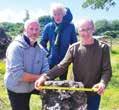
Better check your bogs. You might find butter.
Most people living in the tristate area have never encountered a bog, which is a wetland that is spongy and poorly
drained. But in Ireland, there are lot of bogs, and Micheal Boyle has one in his backyard.
The Irish gentleman smelled something funny and uncovered a huge slab of “bog butter.”
Years ago, people living in Ireland and Scotland would bury dairy or animal fat in bogs for preservation.
The slab of bog butter on Boyle’s farm had a small piece of wood on the bottom, which likely indicates that the bog butter once lay in a wooden container that has since decomposed.
This find was especially unique in its large size, and it could very well be “one of the biggest chunks of bog butter found in Ireland to date,” according to Paula Harvey, an archaeologist who visited the site.
Bog butter chunks are usually around the size of a mixing bowl, Harvey explained, but this one was between around 48 and 55 lbs. in weight, according to The Irish Examiner.
“It was just by pure luck that we came across it,” Boyle said.
Boyle had seen something about a foot in the ground and then sniffed a “cheesy smell.”
“It does taste like butter, an unsalted butter at that. I had a sliver, and I’m still here to tell the tale,” Harvey said of the find.
You butter believe it.



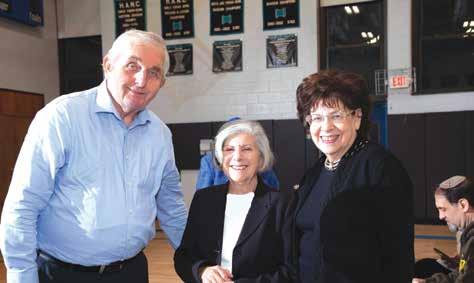
On Tuesday, September 24, HANC Middle School held its Names, Not Numbers program. Names, Not Numbers is a registered oral history film project and curriculum which Mrs. Tova Fish-Rosenberg created that takes the teaching of the Holocaust and its lessons well beyond many previous efforts. Through the Names, Not Number program, HANC’s eighth grade students had the opportunity to document the teachings of the Holocaust and address questions about an individual’s responsibility to humanity. The night
began with a dessert reception for the students, their families and the survivors and their families. This allowed everyone to mingle and enjoy the company. In fact, the inter-generational component is a key aspect of the program.
After dessert, Rabbi Elliot Hecht, Middle School Principal, introduced the program followed by the anthems. Next, Mrs. Tova Rosenberg, creator of Names, Not Numbers, introduced the program. Next, the lights were turned off, and it was time for the feature presentation. The movie presented the students’ inter-

view of Mrs. Lisa Baer, Mrs. Pearl Field, Mrs. Hannah Holsten, Mrs. Annie Leiser-Kleinhaus, Professor Asher J. Matathias and Mr. Alfred Schoenfeld.
At the end of the movie, there was loud applause, and when the survivors were asked to come to the front for a final time, the crowd of people erupted. Afterward, parents and students were effusive in their praise of this most powerful evening. May the parents and students always pass down the testimony from generation to generation.
Names, Not Numbers is generously
supported by a prominent national foundation. The following families sponsored as well: the Alper family, the Brand family (together with Mrs. Brand’s parents), the Maryles family, the Nudelman family, the Traum Family, the Yizhaky family and the Deutsch Fund. A special thank you to Tova and Dov Rosenberg for their efforts with this program. The Names, Not Numbers® at HANC 2023-24 documentary will be included in the archives of The National Library of Israel in Jerusalem, Yad Hashem, and Yeshiva University’s Gottesman Library.

October 7, 2023, served as the beginning of another painful chapter in the history of the Jewish people. It is a chapter that has not yet ended and whose pages remain stained with the blood of our brothers and sisters. Throughout the ages, the Jewish response to crisis and challenge has been constant: prayer, Torah study and turning to rabbinic leaders for guidance. This year, Jews across the globe have activated those strategies as they focused on the unfolding drama in Israel and around the world since the devastating attacks on October 7. The tragedies of the war, the hostages in Gaza, the international condemnations and the marches on college campuses have all been personal, communal, national and global.
As the Jewish community marks a year since this tragedy began, Touro’s Lander Beis Medrash and Colleges are planning events filled with prayer, inspiration and insight from the Rosh HaYeshiva, rebbeim and rabbonim.
Faith in Times of Crisis
Faith in Times of Crisis is a program for college students and the greater community, to be held at Lander College for Men on October 7th at 7 pm. The event will be led by Rabbi Yonason Sacks, the Lander College for Men Beis Medrash

L’Talmud Rosh HaYeshiva, who will share a message of faith and encouragement based upon the timeless words of the Torah. Rabbi Yosef Sonnenschein, Beis Medrash L’Talmud Menahel, as well as noted Jewish historian and Lander College for Men Dean, Dr. Henry Abramson will also share their perspectives.
“The Rosh HaYeshiva, HaRav Sacks, has been a source of support and guidance for the entire Yeshiva since that tragic Simchas Torah a year ago,” said Rabbi Moshe Krupka, Touro Executive Vice President. “Through his leadership, the talmidim understood that the war in Gaza was not merely ‘the news,’ but rather a call to action and a personal responsibility for every Jew.”
At the commemoration event, Rabbi Sacks will share the Torah perspective on how to relate to and process tragic events. He will discuss how we can all discover the inner fortitude to strengthen ourselves and to meet the challenges of dark times. Importantly, he will clarify the interplay between time of great sadness and times of great joy in the experience of the Jewish people.
Rabbi Sonnenschein will discuss the impact of October 7 on the individual in a talk titled October 7th Are We Becoming Numb? He will examine the way our
minds attempt to minimize and normalize tragedies. Drawing from the works of Torah leaders, Rabbi Sonnenschein will discuss a spiritually and emotionally healthy way to remain connected to the pulse of Klal Yisrael’s pain, without suffering emotional burnout.
Dr. Henry Abramson will address The Significance of October 7 in Jewish History. Dr. Abramson will discuss ageold Jewish resilience and lessons we can learn from past tragedies. “Jewish history provides guidance and inspiration. We will find historical analogues to our times and innovative ways to translate earlier solutions to our own challenges. We will not be paralyzed, we will not remain frozen in place: we will look to our elders and sages, who will tell us of eras long past, and we will use those teachings as inspiration for our collective future.”
24 Hours of Tefillah, Tehillim and Torah Touro’s Lander College for Women is teaming up with Touro College Israel for 24 hours of Tefillah, Tehilim and Torah study. “We always offer shiurim during Elul and Aseres Yemei Teshuva to help our students prepare for the New Year,” said Dr. Marian Stoltz-Loike, dean of Touro’s Lander College for Women. “This year is – and feels – different to everyone.
We are having a day—literally 24 hours –of Tehilim/Torah to pray for the safe return of the hostages and for the safety of Israel and the entire Jewish community during this difficult time. The Rambam lists no fewer than eight mitzvot involved in Pidyon Shevuyim, redemption of captives or hostages. Our 24 hours of tefillah and learning will be accompanied by a shiur given by Rabbi Zev Leff to provide chizuk in reflecting on the past year and hadracha as we look toward the future.”
Menucha Novak is one of hundreds of students who will be participating in the 24 hours of Tefillah, Tehilim and Torah. “As time passes, it is very easy for people to believe that the current world is our new reality. It’s really important that we do our best to keep the tefillos flowing and sure we know the end is not out of reach. With the help of Hashem, this will push the tefillos of the entire Jewish community over the top and bring an end to this war and ultimately, the coming of Moshiach,” said Novack.
For more information on Faith in Times of Crisis, contact Rabbi Ariel Kopitnikoff at ariel.kopitnikoff@touro.edu.

Yeshiva of South Shore has entered its fourth year of our now wellknown Tech-in-Check program. With hundreds of children rejoining and many new members this year, the talmidim are continuing to learn the trait of
self-control and self-discipline. So many families have been positively affected by this life-altering program. Children are finding healthy outlets and discovering talents and interests they never knew they had. The Elementary Division
kicked this year’s program off with an amazing ice cream party with toppings galore! Celebrating their commitment and determination is one of the ways YOSS is succeeding in creating healthy boundaries and happy children.
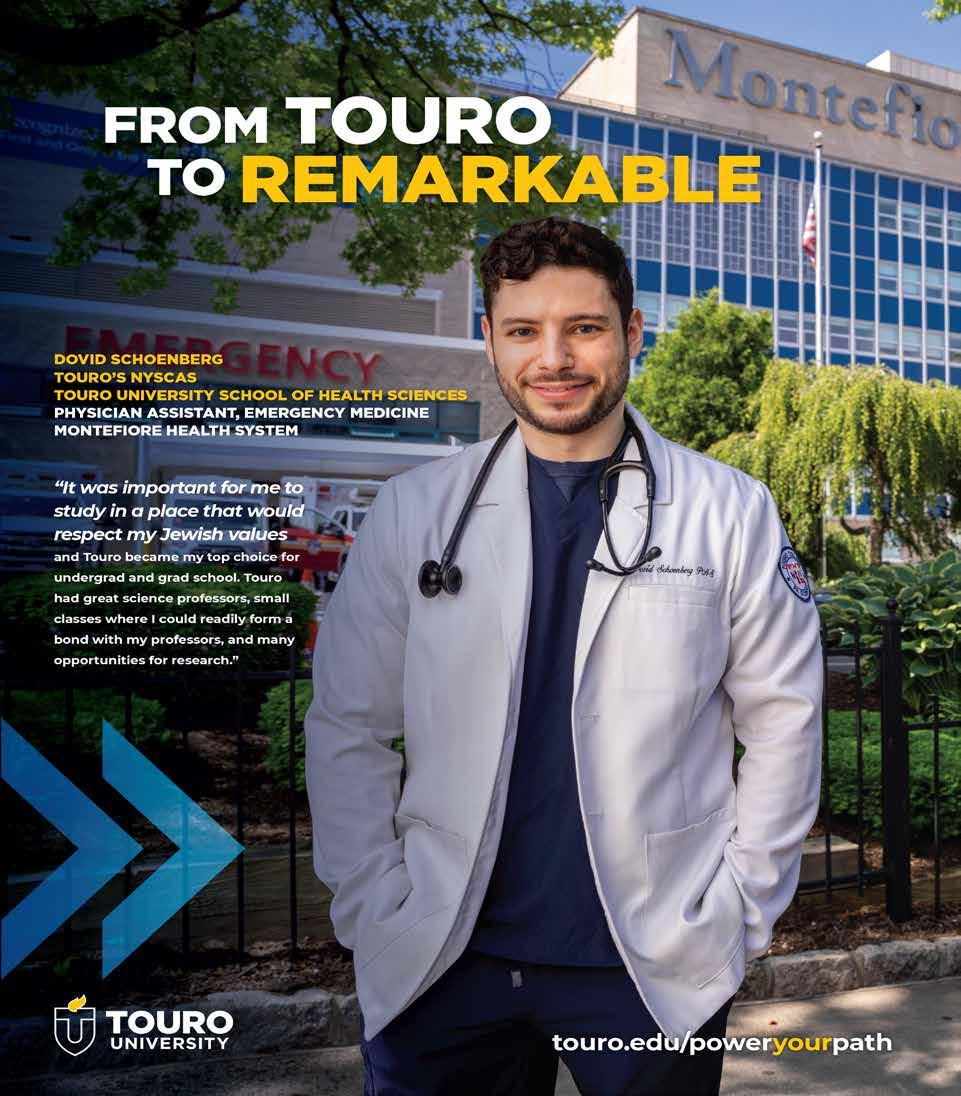

At DRS Yeshiva, bringing in guest speakers to inspire and uplift the talmidim is a central part of the school’s mission. These guests provide not only stories but also life lessons that resonate deeply with the talmidim, motivating them to lead lives rooted in Torah values, kindness, and purpose.
Most recently, Mrs. Hadas Loewenstern visited DRS to share her extraordinary story of resilience, faith, and love. Hadas’s husband, Elisha, was tragically

Rabbi Doniel Kalish, Menahel of Water bury Mesivta, addressed the talmidim before Rosh Hashana. Rabbi Kalish fo cused on the importance of caring for one another, highlighting how each per son in the yeshiva can make a difference






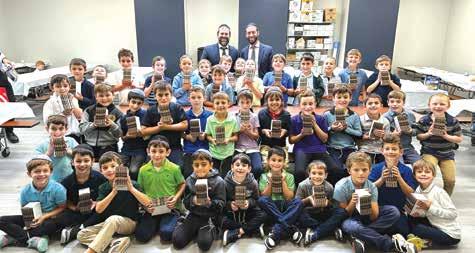
Thirty-nine boys from first grade in Yeshiva of South Shore perfected their kriah over the summer. They each earned a brand-new set of
Chumashim as a gift for diligently practicing kriah every single day of vacation, making sure that they are all ready for second grade!


Students of Mrs. Engelson’s science class at the Abraham and Sara Silber Middle School at Yeshiva of South Shore were very enthused to put into action the concept of transferring potential energy into kinetic energy. The boys diligently built rollercoasters out of



DRS yeshiva continues to expand its learning initiatives aimed at deepening students’ engagement with Torah and fostering independent study skills. At the heart of these innovations is the Junior and Senior Afternoon Seder, where students dedicate two periods each day to completing a masechta over the course of the year. Guided by Rabbi Jordan Ginsberg, the focus isn’t just on covering ground but on developing the critical skills necessary for independent Gemara learning.
ing from Ahavas Hashem to Mesillas Yesharim and Tefilla. These intimate, engaging shiurim offer a chance to explore practical, spiritual, and philosophical ideas in a more interactive setting. Thursday nights take on a more relaxed tone with a freeform beis medrash atmosphere. Students learn with chavrusas, often older bochurim from the community, while enjoying traditional “Leil Shishi” fare like chulent and kugel.
cardstock paper by cutting, taping, and assembling their paper roller coasters.
The biggest challenge was creating loops that the marble would spin through. The creativity in this project was of the charts, and we cannot wait to see what the boys will build next!
For freshmen, the newly launched Masmidim Track offers an elective that adds an extra period of Gemara study. This initiative helps build strong foundations early on, with regular tests ensuring students are actively progressing and mastering the material.
Night Seder has also been transformed, bringing a vibrant learning environment to weekday evenings. On Tuesday nights, students can join chaburas led by DRS alumni on topics rang-
Extending beyond the DRS campus, the twice-weekly West Hempstead Night Seder ensures that students from the local area can continue their learning even when they’re away from school. Together, these initiatives highlight DRS’s commitment to Torah learning and to fostering the growth of each student, empowering them to take ownership of their learning while connecting to their peers, mentors, and alumni in meaningful ways. The future of learning at DRS is brighter than ever.

By Rabbi Dov Silver
As we draw an end to this year, we conclude the reading of the Torah and anticipate starting anew with Parshas Bereishis. One of the final mitzvos that the Torah teaches us is the mitzvah of hakel. The Jewish People would gather on Har Habayis once in seven years on the year after the shmitta year during the holiday of Sukkos.
Millions of Jewish men, women, infants, the elderly, working people, and scholars gathered together to hear the King (Melech Yisroel) recite certain brachos and read from Sefer Devarim. An incomparable display of unity invigorated the Jewish people with a sense of mission that revitalized their connection to Hashem and Torah.
The Gemara in Chagiga 3a teaches that the men came to learn and the women came to hear. But why did the infants come? The Sfas Emes explains the Talmud’s question in the following manner. Generally, children make noise and
disturb adults from learning and hearing the Torah reading. Therefore, since this is a most auspicious time and gathering of splendor, why did they bring small children? Would it not have been better to leave the children at home? The Gemara answers, “In order to give reward to those who bring them.” In other words, it is better for parents to be disturbed a little by the presence of their children if the result will be that their children will absorb the sounds and messages of the Torah and be inspired later on in life to the service of Hashem. Therefore, from the mitzvah of hakel we learn a very important lesson. Parents at times must sacrifice some of their own spiritual service and connection in order to educate their children to be faithful and G-d fearing.
If it is indeed the case that parents must compromise their spiritual growth in order to effectively educate their children to stay on the proper path, it is the same focus when parents are preoccupied with materialistic pursuits. Acquiring wealth and being involved with earthly

pleasures must take a back seat in order to inspire and educate children to love Hashem and His Torah. These distractions prevent us from getting close and staying close to our children. Allowing ourselves to be very busy with material interests at the sacrifice of parenting our children is one of the biggest mistakes a parent can make. Many times, we hear parents confess that while their children were growing up they did not make their children a priority in their lives. What is more precious to us than our sweet, adorable children who desperately need their parents’ love and encouragement? We must never lose sight of what is really our first and biggest concern. Our children!
The fact of the matter is that deep down we all know that our children come first. It may be hard and take discipline, but we must actually make them the primary focus in our lives.
The stories are endless of how our Torah leaders built their relationship with their children. One story that comes to mind is when someone asked the Brisker Rav, zt”l, how he merited to have such wonderful, G-d fearing children. He responded, “You have no idea how many tears I shed every day for my children’s success.” Nobody said that parenting our children is easy, but it is definitely rewarding and beneficial.
As we prepare for Rosh Hashana, we elevate ourselves to reconnect with our Creator. In addition, we need to remember that we have to work with our children to help them create a positive and healthy relationship with Hakadosh Baruch Hu. Seeking ways to help them develop a healthy self-esteem and gain confidence gives our children the ability to strengthen themselves emotionally and spiritually. If we find ourselves at a crossroads and unable to guide them appropriately, I recommend reaching out to rebbeim and mentors for advice and learn better insights to help us guide our chil-
dren. It is our crucial mission.
Clearly, we see with our own eyes how Hashem is communicating to us as the war in Eretz Yisroel ravages on. Our enemies will stop at nothing to remove us from the map. And even here in the USA, with the ever-increasing antisemitism wherever we turn, we must try to listen to the messages sent to us; to come back to Him with a deeper and stronger connection than ever before. We must try to influence our children that our loving Father in heaven is waiting for us to return and recognize Who is really the Master of the Universe Who wants what is best for us.
May these Yomim Noraim be a time for ourselves, our families, and klal Yisroel to join Hakadosh Baruch Hu as His loving children and His holy nation. We must always remember what is happening in the world now is for klal Yisroel’s benefit.
I would like to take this opportunity to bless each and every one of you with much bracha and hatzlacha in all your endeavors. May you always care for and love your children and may your children always love you, their parents.
Kesiva v’chasima tova.
To learn more about Madraigos’ programs and services, please call our office at (516) 371-3250.
Madraigos, a 501c-3 not-for-profit organization, offers a wide array of innovative services and programs geared towards helping teens and young adults overcome life’s everyday challenges one step at a time. Our goal is to provide all of our members with the necessary tools and skills to empower them to live a healthy lifestyle and become the leaders of tomorrow. Rabbi Dov Silver is the founder and Executive V.P. of Madraigos.



GrowTorah is excited to announce the release of Tiferet HaTorah: An educational coloring book for the weekly parsha, exploring the beauty of Torah and nature. Tiferet Hatorah provides an engaging, hands-on experience for both children and adults alike as they explore the weekly parsha.
“We wanted to create something that captures the depth of our Jewish relationship with the natural world in the weekly parsha, through a creative dimension,” said Yosef Gillers, Founder & Co-Executive Director of GrowTorah. “This coloring book is not just for kids—it’s a tool for all ages to explore and reflect on the lessons of the Torah in a hands-on way.”
The original illustrations were inked by graphic artist Abby Glass. Abby first worked for GrowTorah as a summer intern through the “Inchwormship” program in 2022. When the team saw her beautiful parsha sketches, the idea for this project was born, and the process began of creating this engaging, beautiful, and educational tool. GrowTorah is
proud ot feature Abby’s incredible work through this publication.
Key Features of Tiferet HaTorah:
Beautiful Artwork: Each page is filled with intricately designed illustrations that bring the weekly parsha to life, providing a calming and artistic outlet.
Thought-Provoking Questions: Every parsha includes questions to guide personal reflection or group discussion, encouraging deeper engagement with the text.
Interactive Learning: By combining art with Torah study, learners of all ages can explore the parsha through a new, interactive lens.
Order Yours Now!
Tiferet HaTorah is now available for preorder. Order your copy today and begin exploring the parsha in a fun, engaging way.
For more information or to purchase the book, visit www.growtorah.org/tiferet.

In a move that combines creativity, technology, and academic exploration, DRS Yeshiva has introduced a brand-new initiative for its ninth grade students: the Pathways Program. This innovative curriculum is designed to allow the students to engage in a diverse range of subjects before diving deeper in later years.
The Pathways Program spans the entire freshman year, with students rotating through four distinct quarters, each focusing on a different area of study: Graphic Design, Business and Entrepreneurship, Engineering and Hebrew Lan-
guage. The goal is to expose students to a variety of fields, giving them a taste of the many pathways they can pursue as they advance in high school.
“The Pathways Program is crafted to give our ninth graders a broad introduction to these subjects while laying the groundwork for more specialized study in the coming years,” said Dr. Ethan Zadoff, Principal of General Studies “We want our students to discover new interests, cultivate their passions, and have the opportunity to build skills that will serve them both in and out of the classroom.”



Mercaz Academy students have been busily preparing for Rosh Hashana in many different ways. Students in sixth and fourth grade have adapted the Hochman Technique (Writing Revolution) to create short essays in Hebrew about Rosh Hashana topics; fifth graders have been analyzing the structure of Rosh Hashana tefillah and studying the original Torah sources for the sounding of the shofar; third graders have created creative and fact-filled “lap books” for Rosh Hashana that they can consult along with their machzorim; while second graders have identified the simanim traditionally eaten on Rosh Hashana and their symbolic meaning. In the younger grades, students have incorporated Rosh Hashana into their project-based learning and have made their own cards, shofarot, honey dishes, and apple-themed crafts as vehicles to learn the laws and customs of Rosh Hashana.
But it was the two-day schoolwide challah bake that brought the whole school together in a joint celebration of the New Year. Students from toddlers through sixth grade learned the symbolism behind the custom of eating round challah on Rosh Hashana and enjoyed

making their own, with older grades learning the technique to create an intricate round braid and younger students making a knotted or coiled challah with the aid of the “big kids.” Mercaz Academy expanded their circle even more by joining with two special-needs adults from the Adler Center Academy at the Mid-Island Y-JCC to join the challah bake. Director of Programming Morah Phyllis Tessler invited one of these participants to recite the bracha and separate the challah, noting how fortunate it was to have a challah baker over bat mitzvah age at Mercaz to perform this mitzvah.
While all this was happening on the first floor, boys in grades four through six welcomed back Mercaz Academy grandparent Rabbi Dr. Elliot Grossman, who taught them how to tie their very own tzitzit. Each student received a four-cornered garment, and Rabbi Grossman demonstrated how to tie tzitzit according to both the Ashkenazi and Sephardi traditions – an even more intricate knotting protocol than the four-strand basket-weave round challot crafted by their friends downstairs.
Mercaz Academy wishes everyone a sweet and peaceful new year!


The faculty at the Yeshiva University High School for Girls (Central) is constantly looking for ways to enhance the curriculum offered to students. The 2024-25 school year is no exception, with several exciting new classes available to Wildcats across several subject areas. Digital Photography is one of the newest additions to Central’s art curriculum.
“Digital photography is a really fun class,” senior Perri Bausk said of the new elective. “We learn how to take clear pictures and how to make them not blurry.”
A popular selection from the roster of senior courses is Business and Entrepreneurship: Swimming with the Sharks. The course is offered in conjunction with the Sy Syms School of Business and Entrepreneurship at Central’s parent school, Yeshiva University. The collaboration further cements Central’s special relationship with YU, giving budding businesswomen a chance to deepen their financial and commercial acumen.
“At Central, we aim to give our stu-
dents the skills to be curious, independent learners and to expose them to many different areas of study,” said Central’s Head of School, Ms. Bracha Rutner. “Our college-level courses enable our students to learn about different topics, creating excitement about possible future careers and providing them with early exposure to the rich offerings of Yeshiva University.”
The class is also a rigorous part of the student schedule that, along with courses like Psychology and Torah, American Government and Politics, and Economics, offers college credit.
“I really love that we have Business and Entrepreneurship, because it teaches you about different strategic economic skills,” senior Shirel Shivamehr said. “It teaches you how business operates and what really goes on backstage.”
Senior Michaela Meerbaum agrees: “The class delves into the economics surrounding our country, which lays the foundation for our discussions. It’s given me a better understanding of the

mechanics of businesses, and how entrepreneurs grow their networks and make them thrive.”
And new exciting options from Central’s Judaic Studies department – the junior-level courses Zionism, taught by Ms. Sydney Daitch, and Jewish Philosophy, taught by Rabbi Zvi Lew, and the new junior-level electives Pirkei Avot, taught by Associate Principal, Ms. Leah Moskovich, and Parsha, taught by Central’s Mashgiach Ruchani, Rabbi Joshua Goller – promise to deepen student commitment to spiritual learning.
“In this Pirkei Avot elective, students will engage in an in-depth textual study of Pirkei Avot, exploring its wisdom through discussion and analysis,” Ms. Moskovich said. “Together, we will connect the timeless teachings of our Avot to our everyday lives, fostering personal growth and insight. My hope is that this class is a weekly gem, offering students a chance to learn, reflect, and connect to their Avodat Hashem.”
A senior-level course on the Megillot

is offered in the same vein. It is fitting that, in a year that YUHSG will explore courage as its theme, students are seizing the opportunity to courageously try newer courses, or more challenging subject matter. YUHSG will be sharing their constantly-evolving curriculum, as well as their special program offerings, extracurricular life, and community spirit, at their Open House on Sunday, November 3.


In the heart of the Five Towns community, a vibrant scene unfolds every spring and fall, as young athletes from diverse backgrounds unite on the football field to participate in the highly acclaimed 5 Towns Flag Football League. This league is not just about competition; it’s a celebration of teamwork, sportsmanship, and the joyous spirit of youth. With its focus on inclusivity and fun, the 5 Towns Flag Football League has become a cornerstone of the community, fostering friendships and life skills that extend far beyond the gridiron.
Games are filled with laughter and excitement, as players don their jerseys and rally together as teams. The camaraderie that develops among teammates fosters friendships that often last long after the season ends. Parents often share in the joy, cheering on their young athletes from the sidelines and forming strong bonds with other families in the community. The atmosphere during games is electric—filled with cheers, high-fives, and the shared thrill of playing together.
While the primary goal of the 5 Towns Flag Football League is to promote physical activity and skill development, the league is equally devoted to instilling important life skills in its players. Through games, children learn the values of teamwork, discipline, and perseverance. They discover the importance of communication and strategizing with

teammates, laying a foundation not only for athletic success but also for personal development.
The league also emphasizes respect— for coaches, officials, and fellow players. Such lessons in sportsmanship help shape well-rounded individuals who appreciate the essence of fair play, both on and off the field.
The 5 Towns Flag Football League is more than just a recreational league; it is a nurturing ground for character, resilience, and community spirit. With each season, it proves that when kids come together in the name of sport, the possibilities for growth and fun are endless.
Whether you’re a player, a coach, or a proud parent, the excitement of flag football is alive and well in the 5 Towns—and it’s an experience worth being a part of!

Ezra Academy recently hosted its annual Back to School Night, welcoming parents into the heart of their children’s educational experience. This event allowed the school’s dedicated teachers, rabbis, and morahs to introduce the curriculum for the upcoming year, but more importantly, it set the tone for the school’s core belief: education is a partnership between school and home.
Throughout the evening, educators highlighted Ezra Academy’s commitment to academic excellence, ensuring students receive a well-rounded education grounded in both Jewish and secular studies. Teachers took the time to explain their unique approach to integrating rigorous academics with Torah values, showing how these elements work in harmony to develop critical thinking, creativity, and moral character.
Rabbis and Judaic studies instructors emphasized the role of Jewish tradition and ethics, encouraging a strong spiritu-

As we prepare for Rosh Hashana, talmidim at Yeshiva Ateres Eitz Chaim had the wonderful and uplifting opportunity to visit with the Krula Rebbe, hear words of inspiration, and receive brachos for a shana tova u’mesuka. The talmidim also went to Monsey to daven at kivrei tzaddikim, learn about the nifloas ha’borei as they went on a tour at the Honey Bee Farm and continued to an
al connection while fostering intellectual curiosity. They stressed the importance of cultivating not only knowledge but also a deep-rooted sense of identity and community responsibility.
A key message of the night was Ezra Academy’s warm and nurturing environment, where every student is valued. Teachers and rabbis spoke of creating a space where students feel safe, supported, and excited to learn. Parents were reassured that the school views them as essential partners in their child’s journey. The school believes that strong relationships with families help reinforce learning at home and build a strong, supportive community.
Ezra Academy’s Back to School Night was more than a curriculum overview— it was the start of a meaningful collaboration between parents, teachers, and the school to ensure students thrive academically, spiritually, and emotionally throughout the year.

apple picking experience, where we discussed the way we pick apples from the many varieties, making sure that they are ripe and enjoyable to eat. So, too, when making decisions in life, such as who we
choose to surround ourselves with, we should be considered and processed. May we all have a kesiva v’chasima tova and a sweet new year!

HAFTR students embraced the spirit of Rosh Hashana with a series of creative and meaningful activities designed to help them connect with this special time. From Early Childhood through High School, students participated in hands-on projects, classroom learning, and unique experiences that highlighted the themes of reflection, renewal, and growth.
Students of all ages engaged in festive projects that captured the essence of Rosh Hashana. In our Early Childhood, students crafted honey jars and made vibrant pom-pom bees, while others used bubble wrap to create imaginative beehives. Fun and educational games focused on sweetness and renewal, giving students a chance to connect with the holiday in a joyful way. One of the standout experiences was the Shofar Factory, where students had the opportunity to learn about the shofar’s significance. Students witnessed a live shofar-making demonstration and explored the powerful meaning behind this mitzvah. This

hands-on experience allowed them to feel a personal connection to the chag, deepening their understanding of the holiday’s importance. The interactive
“Rosh Hashana Around the World” display in the Lower School added another layer of excitement, showcasing the diversity of customs and traditions from Jewish communities across the globe.
HAFTR’s Middle School students also put a personal touch on the holiday by


creating beautiful Rosh Hashanah cards for their grandparents, bringing joy to their families as they shared their creativity and well-wishes for the new year. High school students had the privilege of hearing from Mrs. Jennifer Airley (who made aliyah from Cedarhurst), mother
of IDF soldier Binyamin Airley (Hy”d) who was killed in Gaza this past year. She shared her son’s inspiring legacy and encouraged students to set meaningful goals and aspirations, reflecting on how each year can lead to a life of fulfillment and purpose. In the classroom, rebbeim and morot led thought-provoking discussions about the deeper messages of Rosh Hashana, including teshuvah, growth, and the opportunity for renewal.
These activities served as a reminder of the importance of connection, reflection, and growth as we enter the new year. HAFTR is proud of its students for embracing the lessons and joy of Rosh Hashana and for bringing such positive energy to the school.
May this year bring health, happiness, and success to all of our families. Together, we look forward to continuing to strengthen our bonds with one another and our connection to the land of Israel in all that we do.
Wishing everyone a shana tova u’metuka!


By Debbie Goldfischer
During a recent road trip through the UK and the U.S., I met many people at different stages of the home-buying journey. I noticed that while life in Jewish communities is vibrant, there’s a looming sense of uncertainty on the horizon, as antisemitism rises, political instability grows, and economic challenges increase. Some see these risks clearly, while others prefer to stay in their comfort zones.
Here are nine tips for navigating these uncertain times and embracing opportunities in Israel.
1. Consider the Future of Jews Outside of Israel
Life in Jewish communities like Teaneck, Five Towns and Boca Raton feels secure now, but antisemitism is rising, and our safety isn’t guaranteed forever. The security of future generations in these communities is uncertain. History has shown that Jewish life can change
quickly, and we must be prepared for this possibility.
2. Plan Your Future in a Comfortable Place
With the challenges Jewish communities face abroad, consider moving to Israel, where Jews have a safe and supportive home. As Rabbi Moshe Sebbag of Paris said, “There is no future for Jews in France.” Israel offers a sense of belonging that may be difficult to find elsewhere.
Moving to Israel is a decision best made by choice, not fear, so it’s crucial to plan for your family’s security and peace of mind.
3. Encourage Youth to Stay in Israel Post-Gap Year
For many, a gap year in Israel is a transformative experience. Parents should encourage their children to stay in Israel after their yeshiva or seminary year. Staying allows young adults to integrate into society, learn the language, and build a future in Israel through education, military service, or social opportunities.

4. Consider Your Livelihood
When planning a move to Israel, it’s important to think about your livelihood. Can you work remotely, or do you have transferable skills for the Israeli market? Explore job opportunities early to ensure a smooth transition.
5. Learn About the Real Estate Market
Understanding the Israeli real estate market is essential. Home prices vary greatly and navigating the purchasing process can be complex. Listen to our podcast “On The House” and explore Buyitinisrael.com to get informed about neighborhood specifics, legal considerations, and key players.
6. Adjust Your Expectations for Housing
One of the biggest adjustments for new arrivals to Israel is understanding the differences in housing. Most people live in smaller apartments, which may be a surprise for those used to larger homes. But the Israeli lifestyle and climate encourage spending a lot of time outdoors, making smaller homes feel more manageable. Embracing this change can help you focus on what truly matters—family, community, and personal growth.
7. Start Decluttering and Preparing to Downsize
Many in the diaspora accumulate more possessions than they need. If you’re planning a move to Israel, start decluttering early by clearing out items you no longer use. This will not only ease the move but also help you mentally prepare
for a smaller living space. A minimalist lifestyle can lead to a more intimate and manageable home environment.
8. Act Quickly on Real Estate
The Israeli real estate market is competitive, with rising prices driven by high demand. If you’re considering buying a home, act quickly. Secure your place in the market before prices rise further. Even if your ideal home is out of reach, purchasing within your budget is a smart way to get started.
9. Contact Nefesh B’Nefesh and Start the Aliyah Process
Israel is not just a destination—it’s a home and a community. For many, making Aliyah is a life-changing decision. Organizations like Nefesh B’Nefesh provide invaluable support, helping you navigate the process of relocating and settling into Israeli society.
The challenges ahead are significant, but they also represent opportunities. Now is the time for the Jewish diaspora to take proactive steps toward their future in Israel. As my son Yossi, who serves in the IDF, reminded me, “We’re sacrificing our lives so that the Jewish people have a homeland—a safe place where every Jew can live in peace and security.”
Debbie Goldfischer is the founder and CEO of Buyitinisrael.com, the leading English-language platform for Israeli real estate. She also hosts “On the House: The Israel Real Estate Podcast.” For inquiries, contact Debbie at debbie@ buyitinisrael.com.
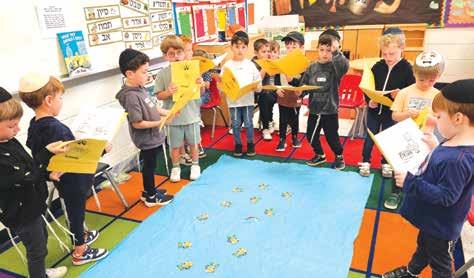

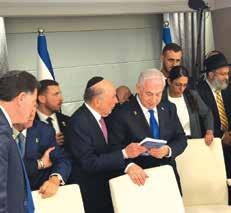

Amid skyrocketing costs for basic groceries, and specifically a dramatic rise in egg prices, Met Council, America’s largest Jewish charity dedicated to serving the needy, assisted over 181,000 food-insecure members of the Jewish community for Rosh Hashanah.
Met Council distributed robust food packages including holiday essentials such as fresh produce, canned fruits and vegetables, pasta, rice, flour, challah, matzo ball mix, soup mix, tuna, cholent mix, chickpeas, and tea biscuits. Special holiday items like honey, apples, grape juice, and round challah bread were also included, alongside proteins such as chicken, fish, and dairy products. Despite the dramatic rise in costs, Met Council had procured and distributed more than 432,000 eggs.
The total value of the food distributed was $4,781,000 at more than 143 sites in New York, New Jersey and Connecticut. Met Council’s staff, supported by over


600 volunteers including community leaders and elected officials, handled the packaging and distribution. The first distribution began just after Labor Day.
“In the past year alone, egg prices have surged by over 250 percent, a stark increase for a staple item compared to last Rosh Hashana,” said Met Council CEO David G. Greenfield. “Anyone who shops knows that everything is more expensive. This rise in costs for basic food necessities means more families

are facing food insecurity and are forced to choose between nutritional food or paying for basic living expenses. Our mission is clear: to ensure that families can celebrate this Yom Tov season with dignity, coming together to enjoy the holidays and start the new year on a positive note.”
For more information, please visit rh24. metcouncil.org.




By Avi Lax
This past week was a major week for the Rambam Masmidim program. Masmidim had its opening week, holding multiple different learning sessions. The program opened with an in-person Monday night open learning session run by Assistant Principal Rabbi Avi Haar. There was a great show of guys with Principal Hillel Goldman and Reb’ Yitz Milworn learning alongside the students. There was pizza, snacks, and soda. The Masmidim opening night was a success with a number of students learning with Rabbi Haar to prep for the NCSY Bekius Challenge. The talmidim
are learning Maseches Taanis with a goal of finishing the Maschechta while taking exams provided by the NCSY program that qualifies the talmidim to earn seforim and other prizes.
Following the Monday Night Masmidim launch, there was a lunch learning shiur from Rabbi Yossi Ziskind which set the table for a Tuesday Night Masmidim Zoom Shiur led by Rabbi Ariel Rosensweig. Additionally, the Masmidim met for more learning during Wednesday lunch with a rotation of Rambam rebbeim including Rabbi Ephraim Meth, Rabbi Ariel Rosensweig, Rabbi Ilan Schimmel, and Rabbi Yossi Ziskind. The talmidim of Rambam Mesivta
By Chaya Feldstein
Keren Minchas Shlomo held its biannual Far Rockaway/Five Towns clothing drive last week. This event was in memory of our com-
munity’s beloved Dr. Nathan Schorr, Nachman Ben Moshe Halevi, z”l. His wife, Mrs. Shaindee Schorr, TLBCT, has been at the forefront of sending clothes to Eretz Yisrael for more than 20 years. She started as a special added zechus for

Sarit Marton, a”h, in whose memory the famous Amen Group runs. She began by calling people she knew who would have beautiful like-new clothes, filled up a van of clothes and dropped it off in Boro Park. That became very cumbersome as word around town grew and people left things at her doorstep, she switched to a different gemach; and when their warehouse was filled, she discovered Keren Minchas Shlomo. Mrs. Schorr been orchestrating their clothes drive for the last 19 years. They started out in the Agudah on Sage Street, spare headed by Mendy Jaraslowitz, but they outgrew it and wasn’t kavod Beis Medrash. Yossi Seif from Precision Auto offered his warehouse and closed his shop for a full weekend to give the space. This year, it was held in a former shul on Beach 30th Street and Seagirt Blvd.
The clothing drive’s general success is due to the many volunteers as its dependent on the volume of donations and volunteers. The boxes were donated, and the security by RNSP Shomrim was enforced. There were about 60 TAG High School girls and TMM girls who came to help sort the clothes. Each bag that is donated is sorted through carefully and boxed to ship in accordance with the community’s taste and style. It is sent to ALL Jews!

We all thank Rabbi Haar and Mr. Goldman for running this great program and inspiring the students to learn extra Torah!
are excited for all the upcoming Masmidim shiurim both at night and during lunch. The Masmidim Program is the centerpiece of the Rambam Mesivta extracurricular learning programs which also feature Sugya Yomi, Halacha Yomi, Parsha Yomi (a new initiative started this year by Rabbi Dr. Andrew Sicklick), The Meet The Rabbi Club and more! Students who participate in this program are always treated to exciting and inspiring shiurim as well as to great food and chevra! Also, students who achieve Masmidim status earn Rambam Masmidim Swag and go on an annual trip. In the past, the Masmidim have been rewarded with trips from fishing, to escape the room, to paintball, to air trampoline, and more!
Maier Solomon, the director of Keren Minchas Shlomo, said that he is blown away by the kindness of our community. Rabbi Paysach Krohn has publicized the amazing story that money was found in an envelope pinned inside a dress. That dress was traced back to the donation from our neighborhood and it helped a widow pay for two months’ rent.
The clothes from this drive are earmarked for refugees from the north and south of Israel who are in hotels in Yerushalaym since October 7, close to one year!!
Keren Minchas Shlomo’s foundation is based off the request of Yaakov Avinu, “Beged lilbosh v’lechem l’echol.” Their focus is to help clothes families and additional food drives before Yom Tov.
Doing a one-time major event such as clothing drive is incredible and monumental. The author would like to suggest that just as important as doing the big things, the little things that oftentimes are necessary for prolonged repeated time and don’t receive as much attention are just as valuable chessed... Such as this author’s passion of spreading the ideas of crown jewel of chesed, hachnosos orchim.

On May 7, RNSP Shomrim received a call about a burglary that had occurred in Siach Yitzchak early that morning, in which a safe containing a Sefer Torah was stolen. The RNSP immediately dispatched units to the scene who retrieved video footage of the burglary and began canvassing the area, looking for the perpetrators, the car that was used in the theft, and any other evidence that could help with the case.
Throughout that day and the following night, Shomrim members canvassed every street in the Rockaways, trying to locate the vehicle wanted in connection with the burglary. The biggest priority at that point was to try and retrieve the safe and the Torah before the perpetrators would realize what was inside and possibly discard it.
Finally, at midnight, a vehicle was spotted that matched the vehicle seen in the video of the burglary. After many hours of gathering video footage, the RNSP units were able to find the license plate that was on the burglar’s vehicle, which matched the front plate of this vehicle that was just found. That entire night, Shomrim members surveilled the vehicle from a distance. Early the next morning, the vehicle left its location and went to Brooklyn, where the driver parked and went to work. RNSP units kept eyes on the vehicle, while sharing all their information with the NYPD’s Major Case Squad detectives. The detectives came to Brooklyn as well and watched the car along with the RNSP units.
After a few hours, right when the RNSP thought they were onto something, the owner of the vehicle that they were watching called 911 to report that one of their license plates had been stolen from their car. The perpetrators of the burglary, who drove a black Ford Taurus, stole the license plate off this person’s black Ford Taurus and put it on to their car prior to committing the burglary, successfully throwing off their trail. With all the time and effort that had already gone into finding this car, it was a crushing blow to all of the involved parties – but they knew they needed to forge ahead.
Over the next few days, the RNSP worked with the NYPD’s Major Case Squad to gather surveillance footage from dozens of locations to track the car’s movements after the burglary was com-


mitted. The Major Case Squad ordinarily takes on cases that involve losses at or in excess of $100,000, and this particular loss was valued at slightly less than that. However, after Shomrim leadership had extensive discussions with them to explain the missing Torah scroll’s sentimental value to the community, they decided to take on the case. This proved to be a pivotal move.
After days of gathering and reviewing security camera footage, the investigating parties finally found the location where the burglars had switched back to their original license plate. That enabled Shomrim to use their new LPR (license plate reader) camera system, which they have been installing throughout the Rockaways and Five Towns over the last few months. This system sends notifications when it detects specific license plates connected to auto thefts or other crimes.
In this particular case, the LPR system enabled the police to identify the wanted vehicle as being registered to a particular address. Detectives were then able to identify a suspect, but because his face was covered by a mask in the burglary video, there wasn’t much more they could do. The District Attorney’s office would not prosecute a case without being able to clearly identify someone by their face, which is one of the driving factors of Nassau County’s new public mask ban.
In the meantime, there was a tremendous amount of ongoing investigative work trying to figure out who might know anything about the crime and/or the perpetrators. Then, in mid-July, this wanted vehicle hit an LPR for the first time since the burglary. The RNSP, in constant contact with the NYPD’s Major Case Squad, discussed the different options as how to proceed. Even though there was a risk involved, the police decided that the best chance was to put out an APB (all points bulletin) – an alarm that would make the plate come up as stolen if it ever drove

past another LPR. Sure enough, on the morning of Friday, August 2, the vehicle hit an LPR mounted on an NYPD Highway patrol vehicle. The officer pulled over the vehicle and alerted the Major Case Squad detectives. The detectives immediately took the driver, who was also the main suspect in the Sefer Torah case, into custody. After more than 3 hours of interrogation, the suspect admitted to the whole theft and gave the approximate location where he and his accomplice had dumped the safe – a heavily wooded area in Queens.
After thoroughly searching the location specified by the perpetrator, multiple discarded safes were found. Among them was the safe with the Sefer Torah still inside. The safe had been damaged by the perpetrators’ attempts to pry it open.
Apparently, they did manage to open the safe at some point and were highly disappointed to realize that there was no cash or other recognizable valuables inside. Confused, they opened the Sefer Torah and viewed approximately ten parshiyos before deciding to shove it back into the safe. Deciding it had no value to them, they discarded the safe with the Torah inside.
Because the safe doors had been slightly damaged, some rainwater got inside and damaged roughly ten parshiyos that were written on the exposed, loose parchment. Fortunately, the loose parchment helped keep the rest of the Sefer Torah away from the sitting water, which protected the rest of the Torah from being fully destroyed.
Baruch Hashem, it was not a very wet summer until that point, so the damage was limited. Interestingly, the week after the Sefer Torah was recovered, it poured every single day for a week straight. If the Torah had not been found right when it was, the Torah would most likely have been completely submerged in water and lost forever.
Aware of the holiness of the Sefer Torah scroll, the NYPD’s Crime Scene Unit worked delicately and with great reverence. They brought it to a safe location where they gathered the evidence they needed and completed their investigation. The Torah was then transferred to the RNSP, who immediately brought it to Rabbi Akiva Oppen of Oppen Scrolls to see what could be done to save the Torah. The ten ruined parshiyos had to be removed and are in the process of being rewritten, while the rest of the Torah remains intact.
On August 8, members of the RNSP, Assemblywoman Stacey Pheffer Amato, Councilwoman Selvena Brooks Powers, NYPD Deputy Chief Richie Taylor, the owner of the Sefer Torah, and Rabbi Akiva Oppen joined together to express thanks and appreciation to the detectives of the Major Case Squad who had led the investigation. Assemblywoman Stacey Pheffer Amato awarded citations in honor of this important arrest and the Torah’s recovery. Rabbi Oppen explained to the guests in great detail about the importance of a Torah scroll, how the letters are written, the time it takes to write each column, and other relevant topics. The detectives were fascinated and asked many questions. Representatives of the Far Rockaway and Five Towns Jewish community explained how incredibly meaningful and important this case was to them and expressed their profound appreciation for the efforts of the detectives and RNSP.
The RNSP and the entire community are truly thankful for everyone’s involvement and incredible efforts. They eagerly await the opportunity to invite the detective squad back to the Far Rockaway/5 Towns community to dance with the Torah upon its complete restoration.

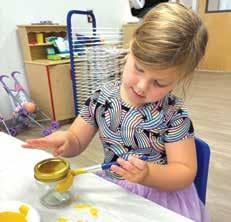

On Wednesday, September 25, the entire senior grade at MTA was privileged to visit the Museum of Jewish Heritage as part of an extension of the Names Not Numbers Holocaust Oral History Documentary program.
In groups, students explored the main exhibit, “The Holocaust: What Hate Can Do,” showcasing the experiences of European Jewry from the 1930s through the end of the war. Afterwards, students reported both learning things they had never known before about the Holocaust as well as being moved by the images and artifacts contained in the gallery.
“I didn’t know how hard it was for survivors to integrate back into society…” - Yitzie L. (Monsey).
“I didn’t know that they made the Jews play instruments for other Jews in the camps…” Noah L. (Queens).
Chaim S. (Bergenfield) reflected how inspired he was by seeing the resilience and hope the Jews displayed in the ghettos by creating theaters and music despite the terrible situations they were in.
Students also participated in a work-

shop on photo analysis, led by Museum director Dr. Paul Radensky. Students examined scenes from across the span of the Holocaust, including before it began and after it was over. A Jewish wedding photo of the Bamburger family from 1921 Germany, the building of the Warsaw Ghetto wall, the public humiliation of an elderly Jew having his beard cut off, a scene from a convent where a Jewish girl was in hiding, and a photo of a man in a DP camp – surrounded by friends who are looking on as he holds his infant son.
As a side note, the young married couple

did make it out of Germany in time, and the groom actually went on to teach at Yeshiva University in the 1940s… Overall, despite road closures and heavier than usual traffic as a result of the UN being in session, the museum trip was successful and meaningfully received by all of the students. Students left feeling a deepened sense of connection to the mesorah as well as a renewed feeling of reassurance that the enemies of Yisrael will never win—certainly a needed message of comfort in light of the difficult situation in Eretz Yisrael today.

Renowned media personalities Sid Rosenberg and Michael Rapaport will join Scott M. Feltman, Executive Vice President of One Israel Fund, for a high-profile visit to Israel the week of October 7. The trip, which includes visits to the southern region and Judea and Samaria, holds special significance as the group will tour key historical sites while reflecting on Israel’s enduring challenges. Sid Rosenberg, the popular host of the Sid & Friends in the Morning show on 77 WABC Radio, is a long-time advocate for Israel and a leading voice in pro-Israel media. Throughout the trip, Rosenberg will be broadcasting live from Israel, allowing listeners worldwide to tune in and experi-
ence this momentous journey in real-time.
“To be in Israel on a date marked by so much pain and loss will be deeply moving. It’s a reminder of the constant challenges this nation faces,” said Rosenberg. “I feel a deep responsibility to stand with the Jewish people, especially on this day, and I deeply appreciate the critical work One Israel Fund does to secure the Biblical Heartland, particularly in times like these.”
The itinerary includes visits to historic and culturally significant sites such as Shiloh, Samaria, and the Jordan Valley, where Rosenberg and Rapaport will explore the foundational roots of the Jewish people. The trip will provide them with a deeper
understanding of Israel’s culture, history, and the modern-day challenges it faces.
Michael Rapaport, the renowned actor and comedian, has been a passionate voice for Israel since October 7, using his platform on social media to express his solidarity. “I’ve always been proud of my Jewish roots, and this trip will allow me to connect with them on a more profound level,” said Rapaport. “Walking through the Biblical Heartland, where the story of the Jewish people began, will be an unforgettable experience. I’m incredibly grateful to Scott and One Israel Fund for the opportunity to witness firsthand the vital work being done to support these communities and meet the residents.”
The trip will also serve as a prelude to One Israel Fund’s upcoming 30th Anniversary Gala Dinner, where both Rosenberg and Rapaport will play key roles. Rapaport will serve as Master of Ceremonies, while Sid and his wife, Danielle, will be honored with the Maginei Yisrael (Shields of Israel) Award.
“This trip is just the beginning,” Rapaport added. “The Gala will be an incredible opportunity to reflect on all we’ve experienced and help ensure that One Israel Fund continues its vital work for many years to come. I am truly honored to be a part of such an amazing organization.”

The Lashon Tov Club at Rambam Mesivta held its kickoff event last Wednesday. The whole school heard from Queens Assemblyman Sam Berger who discussed the importance of watching one’s words in both the political and personal arenas. Following the assembly, the boys then enjoyed a breakfast of bagels and cream cheese.
The Lashon Tov club makes people more aware of the benefits of positive speech. Its members keep track of multiple things they are working on during the course of a day. At the end of each week, they add up how many of these objectives they achieved each day, and thereby gain entry to raffles for great prizes. Every few weeks, they also enjoy an exclusive breakfast.
This is the Lashon Tov Club’s fourth year. The breakfast honored 45 students who participated in the club last year. Assemblyman Berger gave out Certificates of Recognition from the New York State Assembly, congratulating the students and lauding their accomplishment. Af-
ter being introduced by Rabbi Zev Meir Friedman, Rosh Yeshiva of Rambam, Assemblyman Berger focused on how people succeed more when they speak positively, whether in school, the workplace, or politics. He noted, “As a politician, I have to watch every word I say. Also, as a Jew, each word is an opportunity for a Kiddush Hashem.”
Rabbi Avi Herschman, Rosh Mesivta of Rambam, shared, “Over the years, more than a hundred students’ lives have been enhanced by the Lashon Tov Club. When people speak positively, they think positively. When we use davening to deepen our relationship with Hashem, our life fills with blessing. Positive speech is a habit that benefits ourselves and our families, since people who speak positively are more pleasant to be around. The impact of this program will last for generations.”
The breakfast was sponsored by a donor who is associated with the Organization Chickens For Shabbos. It is l’iluy nishmas, Yaakov ben Shlomo,
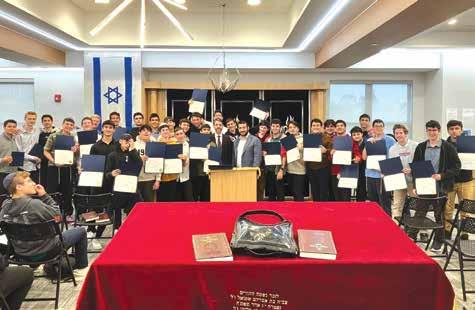
Henca Raizel
Avraham Aryeh.
The goal of this Lashon Tov break-
fast was to help incoming freshmen understand the club’s benefits, and to sign up both new and returning students for an amazing year of positive speech. As of this writing, the club this year has 88 members signed up.



On Thursday, September 26, YCQ students kicked off the school year with a series of exciting educational trips. Second grade had a fantastic day exploring Marine Life at the New York Aquarium. Sixth graders visited Skyscape, an interactive Spy Museum for thrilling insights into espio -
nage, while the seventh grade visited the Intrepid Sea, Air, & Space Museum. The eighth grade ventured to Ellis Island and the 9/11 Memorial to reflect on these important monuments of American history.
Trips like these provide invaluable opportunities for informal, hands-on learning, allowing students to engage di-

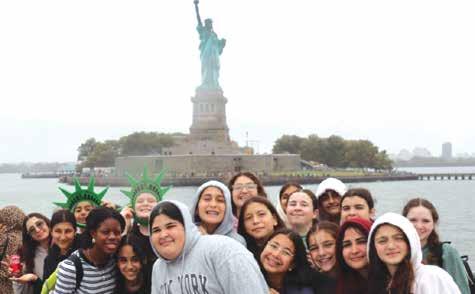
rectly with the subject matter and apply their knowledge in real-world settings. They also foster stronger bonds between students and teachers through shared experiences and collaborative activities.
YCQ students in the other grades are looking forward to their kick-off trips taking place in the coming days. A special
thank you to Mrs. Shirly Pourad-Kaikov and Mr. Jacob Grossman for organizing these memorable outings that enrich the students’ learning and help build a sense of community.

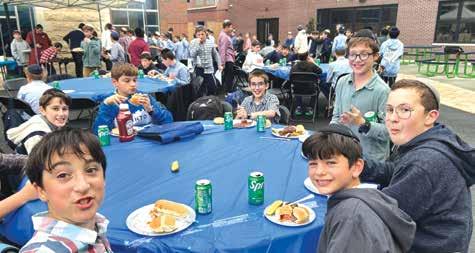
How do you celebrate nearly one hundred 6th to 8th graders who committed to keep their Techin-Check? With a BBQ Bash, of course! And that’s why R’ Yitzy Haber, YOSS TiC Commissioner, got a massive grill and ran an amazing BBQ event for these incredible boys. The ruach was amazing, the food was delicious, and the music was perfect. Did we mention the ices?! To top it off, there was a massive game of “Heads, Shoulders, Knees and SHOES” and a HUGE “Flinch” game with some
great prizes.
Rabbi Zev Davidowitz, Menahel of the Mechina, explained why they were celebrating so early in the school year: “When boys grab the opportunity to elevate their lives by taking control of their tech, we see true greatness and have so much respect for what they are doing!”
Tech-in-Check has been helping YOSS families navigate the nisayon of the generation, and these boys are already experiencing (and tasting!) what it means to live tech-free!

By Sofia Dashiff
This past Tuesday, Shulamith High School introduced an inspiring new program for the juniors called La’alot. This Torah-based initiative will foster personal growth during this pivotal stage of life and inspire us to enhance our relationships with Hashem, others, and ourselves. The program began with a lesson on the stages of inspira-
tion and how motivation ebbs and flows. This was followed by a meaningful activity in which we wrote our aspirations on paper and attached them to balloons. As we released the balloons into the sky, we davened that our hopes will reach Shamayim and Hashem will guide us in achieving our goals.
We look forward to a year full of growth!

Tichleh shana v’kililoteha. tachel shana u’virchoteha
The famous Piyut, Achot Ketana, that many say on the first night of Rosh Hashana, sums up the feelings of our entire nation.
Goodbye to last year and its curses, we welcome the new year and its blessings. Finally!
By the time the Yomim Noraim period of 5784 concluded, Hashem had clearly told us, “I need more from you, My people.” And we all hope and pray that our national and communal responses to the Simchat Torah Massacre have been pleasing to Him.
It is easy to focus on the unanswered prayers – the atrocities committed by our enemies on October 7 and beyond, the fallen and wounded soldiers, hostages who have not returned home and many who never will. Businesses destroyed, families torn apart, and Jews (and non-Jews) suffering and in pain.
But we also must be thankful; we must see the good.
On October 7, Mr. Yerucham Rivlin, a father of 12 from the town of Otniel, lost 2 sons at the Nova Festival. But, he sees things differently than one might imagine. Four of his children attended the festival, and two survived. Following the shiva, he visited the Nova site with the 2 surviving sons, and they gave him a tour – “this is where I hid,” “this is the spot where Aviad was killed,” “over there is where Gidi was murdered.” Having seen the site of the atrocities, and understanding that Hamas was on a no holds barred rampage, he realized that it was a miracle that two of his sons made it home. He told us, “I realized, when I saw with my eyes what happened, there is no logical reason that all of the people there weren’t killed. Two of my sons died, but two made it home, against all odds. I am thankful to Hashem because on October 7, He didn’t take away four of my kids, He gave back two.”
So as we close out the year, we would like to express our hakarat hatov to everyone who helped the Israel Chesed Center – which did not exist 12 months ago and was born out of necessity and hard work – grow into the largest organization providing aid for soldiers and civilians, while ensuring that the entire community has limitless opportunities to do Chesed and assist our brothers and sisters in Israel. And specifically, thank you to… · Our wives and kids - Shira and Adena, the original “Chesed Center Wid-
ows.” Without your patience, support and encouragement, we would be back to our pre-October 7 lives! And, of course, to our kids, who have been helpful in the Chesed Center (nobody teaches tzitzit tying like EJ!), taking bags to Israel (Raylie, Tamar and Momo), distributing gear out his dorm room (Yonatan) or simply being understanding of why we have been more focused on our extended family 6,000 miles away than on them. We love you!
· Our Team in Israel – Shiri Hadar, Yissachar Halpern, David Rose, and many others. Getting the right gear to the right people, dealing with Israeli bureaucracy, and working with us is not easy! But they do it with a smile.
· Community Leaders – Over 40 shuls have partnered with us over the past year, but as much as we would prefer not single out any specific Rabbonim, we must specifically express our gratitude to Rabbis Yakov Trump (YILC) and Zalman Wolowik (Chabad of the 5T), our partners and the “Morei D’atrah” of the Chesed Center; and Rabbi Sender Gluck of Khal Chasidim of Lawrence, where we first met (Jeff and Moshe) and who enabled us to launch our initial gear campaign.
· Schools and Camps – Virtually all of the local yeshivot, and many summer camps, have partnered with us, and we are grateful to you for lending us your students, allocating resources and allowing us to push you into projects that are typically not parts of your curriculum or schedule!
· Partner Organizations – By October 10, hundreds of organizations sprang up, all with a goal of helping in the “war effort.” A year later, a handful remain, and all are critical to the effort. Thank you to our partners: Yakir and team at Boots for Israel; BC Lev Echad; Yossi Newman and Just One Chesed / Chamal Lagiborim; Migdal Ohr; Soldiers Save Lives / Let’s Do Something in Memory of David Newman HY”D; Beef up Our Boys; Ascent of Tzfat; and Ezras Yakov.
· Business Partners – Thank you to so many local businesses for helping us along the way. We could not have done it without you, we appreciate you, and we encourage everyone to express their gratitude by working with you! Print on Point (Mikey, you’re a star!); Minuteman Press (New Rochelle); Ezra (free trucking); Alan Shulman / Main Event Mauzone Caterers (thank you for feeding hundreds of hungry volunteers!); NY Fun Factory (the 1-month deal to borrow tables and chairs is way expired!); Bravo Pizza; Seasons; Gourmet
Glatt; Adam’s Glatt: Crave!; SML; Iced; SplenD’or; Seegal; Fruit Platters & More; The Cheese Store; Central Perk; Dimples; Jerusalem Florist; Spruce D’Vine; Hakerem; Jezreel Wines; Runflow Art; The Five Towns Jewish Times, The Jewish Home, Jewish Vues, The Jewish Press; and 5 Towns Central.
· Our Volunteers – With over 3,000 people on our various WhatsApp chats, it’s impossible to name everyone! Every time we put out a request, hundreds of people will drop what they are doing to help in any way. Clearly, we can’t name everyone! But it goes without saying that nothing could happen at the Chesed Center without the incredible efforts of Pessie Steinberg. And hopefully nobody will be (or should be) insulted by us naming a few of the undisputed volunteer heavyweights of our community – Estee, JJ, Aviva, Shalom, Chaim, Lori, Marci, and Ruthie; Our Design and Social Media Team – Allysa, Esther, Hodaya, Judith, Ayalah, Hallie & Leebs; our musicians and tech volunteers – Ahron, Eitan, Menachem, Shlomo, Sholom, Yaakov & Matthew; and finally, Ovadia and the chevra at Israelis for Israel! And of course, huge hakarat hatov to the spouses, i.e. the “Chesed Center Widows” (thank you Arnie for coining the term).
Without a roof over our heads, the bags and gear would get wet! So we have immeasurable appreciation for the people who have housed us! Thank you to Abi Liff and Jeff Friedberg for opening up their Mill Street warehouse to us on October 10, and to The Shul of Saddle Ridge for giving us their kiddush rooms for a couple of months. Finally, we are extremely grateful to the Pilevsky family for providing us with our current home on Peninsula Boulevard. Thank you!
Without the help of all of the individuals, organizations, rabbonim and leaders, we would not have been able to help our communities, over the past year, achieve this
Transported over 6,000 duffel bags of gear to IDF bases and Security Teams, and over 2,000 bags of brand-new clothing and other supplies for displaced persons. Thank you to El Al for your support and assistance!
Facilitated the purchase and donation of over $10,000,000 in gear, including:
Over 1,000 Tactical Helmets and Vests;
Winter Gear - Thermals, sleeping bags, soft shell jackets and other cold-weather gear
Tactical Gear – Uniforms, gloves, kneepads and multitools
Safety Gear – Tactical glasses, goggles, gun-mounted flashlights, First Aid kits
Boots – over 1,000 pairs of military boots
Soldier Health – hundreds of thousands of blister bandages, rash creams, protein bars, beef jerky bags, hydration kits, and more.
Transported by ship 7 forty-foot cargo containers of medical gear, supplies and clothing to Israel.
Sent 2 cargo planes loaded with 1,100 tents and 27 pallets of medical supplies.
ICC Simcha Fund has shipped over 30 wedding gowns to Israel approximately 100 suits for chattanim and bar mitzvah boys, and has provided financial assistance for 5 smachot, including a sheva brachot for a low-income family on an IDF base, enabling the chayalim to enjoy a catered barbecue while being “M’sameach Chattan V’Kallah.” Shabbat / Chagim Programs –For every chag since October 7, the ICC has assisted Chayalim and their families, displaced families, and others impacted by the war:
Shabbat BaShetach – between Shabbat Bereishit and Pesach, we prepared and delivered over 400,000 shabbat meals to over 100 IDF bases!
Sponsored and coordinated scores of barbecues on various bases throughout Israel.
Chanukah – Over 100 duffel bags of Chanukah gifts to mefunim, soldiers and their families.
Purim – Over 100 duffel bags, 5000 Purim costumes and over 1,000 Mishloach Manot to displaced families and families of active-duty soldiers.
Pesach – Raised over $250,000 for Passover needs for families of IDF soldiers, and sent over $250,000 worth of brand-new clothing to displaced families.
Sukkot – In partnership with Shir Chadash of Yerushalyim, the IDF Rabbanut and Sgt. Sruli Wiener (who was just called back into service), we recently launched a campaign to supply Arba Minim to 5,000 Chayalim!
Please join us on October 7, the calendar anniversary of the Simchat Torah Massacre, from 7am - 8pm, as we memorialize the victims and honor the heroes of Am Yisrael.
K’tivah vachatima tovah. B’yachad nenatzeach.
- Jeff & Moshe


In a powerful show of unity, New York State Assemblyman Simcha Eichenstein, New York State Assemblyman Sam Berger, and New York City Councilman Kalman Yeger rallied together to emphasize the importance of voting strategically in the upcoming elections. With an unbreakable Democratic majority in the New York State Assembly, the leaders urged all Far Rockaway and Bayswater voters, especially those who plan to vote Republican for President, that they MUST support Stacey Pheffer Amato, the Democratic Assemblywoman up for re -

The event was emceed by the renowned community askan, Chaskel Bennett, who set the tone for the evening by making the choices crystal clear. He bluntly explained that a seat in the Democratic majority is a seat at the decision table – a seat in the Republican minority is a seat wasted. The event aimed to educate and mobilize voters, encouraging

strategic thinking in the voting booth.
“This is the truth, like it or not,” said Bennett. “If you want a say in the New York State Assembly, you have to be in the Democratic Majority. That’s the truth.”
“A vote against the Democrat,” explained Councilman Yeger, “is a vote against yourself and your community. The Jewish community is smart enough to understand the importance of strategic voting.”
Stacey Pheffer Amato has been the State Assemblywoman for Bayswater and Far Rockaway since 2017 and has been credited for her ability to defend and help her neighborhood. She is the only Jewish elected official in South Queens. She is the daughter of former Assemblywoman Audrey I. Pheffer.
The honest conversation further highlighted the crucial role that membership in the majority plays in shaping legislation. Assemblyman Eichenstein stressed, “By being part of the majority, we can effectively advocate for our community’s needs and values.” Assemblyman Berger added, “In the minority, their voices are effectively silenced, leaving Republican legislators powerless to oppose harmful legislation.” Eichenstein and Berger both explained that “you need to know which legislator has the ability to get the bill passed, which legislator has resources and gets to decide the budget. In this community, it’s only one person: Stacey Pheffer Amato,” said Assemblyman Eichenstein. Assemblyman Berger continued with “think about what it means to not have a voice at the table? To not have a say? Voting against Stacey, you’d be doing that. You can be a Republican, but understand that voting that way for this one seat, State Assembly, isn’t

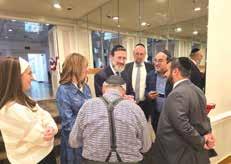
changing the system. There is a Democratic super majority, 102 Democrats to 48 Republicans. Losing this seat won’t give the Republicans any power – but voting against Stacey, voting for the other guy, you make it easier for the people who hate us [Jews] to win fights because the Republicans don’t have a say. They’re not involved, no matter how much they want to be. All they can do is yell, and I’ll be honest, no one is listening to them because they have no power and don’t make decisions.
“Stacey is in the majority, she’s a Democrat, and in the State Assembly, she has power.”
The speakers praised Stacey Pheffer Amato, a respected member of the Jewish community, and agreed that she was the strongest ally for the Jewish community in Albany.
“Reelecting Stacey ensures our [Jewish] community has a strong voice in the majority, in the room where decisions are made,” Councilman Yeger explained. “Think about who has the ability to stop a bill? It’s not the Republicans in the State Assembly. They can oppose it all they want, but they can’t stop it. A member of the majority can, Stacey can, and she has.” Yeger was referring to the “Not On Our Dime” bill that was introduced by an antisemitic State Legislator that would have banned donations to any charity that operates in Israel. While Republicans in the State Legislature may have been opposed to the bill, they failed to
have any ability to stop it. The bill did not pass, or even get voted on, because Assemblywoman Stacey Pheffer Amato was able to stop it as a member of the majority, as someone in the room where decisions are made.
“You can’t stop something if you’re not in the room. Republicans are not in the room. You take a legislator who has a say, like Stacey, out, and replace her with a Republican, you have lost your voice and the ability to fight back,” said Yeger. The keynote speaker for the evening’s event was New Jersey State Assemblyman Avi Schnall. He spoke passionately about the need to have a seat at the table but also to show loyalty to Stacey Pheffer Amato who “has always been the most courageous and influential advocates for the Jewish community, even in the face of fierce opposition from the far left.” He challenged Far Rockaway and Bayswater to follow the lead of Lakewood, NJ. Prior to Schnall’s election, Lakewood, New Jersey, was represented by a Republican, a member of the minority party in the New Jersey State Assembly. This resulted in minimal resources and attention to
the area. However, in his race last year, the Lakewood Jewish community, which overwhelmingly voted for Republican Presidential candidate Donald Trump, crossed the ballot in this one race and voted for Avi Schnall, a Democrat, in massive numbers. He won the election with over 80% of the vote. His district has immediately seen improvements through funding and legislation, and for the first time in years is having its voices heard. As New Jersey is also controlled by a Democratic majority, he explained, “this move is smart for the community and smart for our future.”
Throughout the night, the sentiment was clear by the speakers what was being explained: vote for Stacey Pheffer Amato for State Assembly. Richard Altabe, a long-time community leader of Far Rockaway and Bayswater, clarified, ”You can vote for Donald Trump for President, but when it comes to the State Assembly race, you have to find Stacey’s name and mark her box. You can be pro-Trump, and Pro-Stacey.” He continued, “This isn’t about politics, it’s Stacey. This is family. It’s personal. We need to be thankful for

the people we do have. We have Stacey. We have a fighter. We have a person who gets things done. A vote for Stacey is a vote for Far Rockaway and Bayswater. A vote for Stacey is a vote for Judaism.”
All the elected officials emphasized that a vote for the Republican candidate for State Assembly would take Far Rockaway and Bayswater out of the conversation and could empower legislation contrary to their community’s values, such as “wokeness,” “antisemitism” and “defunding the police.”
“This isn’t a criticism of the Republican candidate,” Assemblyman Berger clarified, “but rather a recognition of the reality and severe limitations of minority representation.”
In the New York State Assembly, the members of the minority, which since the 1970’s have been the Republicans, do not have a seat at the table, nor have the ability to make decisions or pass laws. Pheffer Amato, who is a Democrat and in the majority, was able to secure $75 million in STEM reimbursement for our schools, create the first ever arts reimbursement program for our schools, and secure over
$100 million in security grant opportunities for our Yeshivas and Shul’s – the Republicans weren’t able to do that and they never will!”
As the election nears, the choice is a clear one for the residents of Far Rockaway and Bayswater to make. Individuals have the ability to vote for either Stacey Pheffer Amato who has a proven record of being a champion for her community and delivered for the Jewish community time and time again, or vote for a Republican candidate who in the State Assembly will never have a seat at the table, have access to funding, or be able to get anything done.
No matter how you vote for President, Congress, or Senate, think about the race for State Assembly and if you want to ensure Far Rockaway and Bayswater doesn’t lose its voice.
If you have a question on where to vote, confirming your voter registration, obtaining an absentee ballot or anything else, please feel free to call the Queens Board of Elections at (718) 730-6730 or visit vote.nyc.





If bees could unionize, they’d definitely demand fewer workdays and more flowers.
You thought your commute was tough? Try flying five miles just to grab lunch.
Ever wonder if bees judge our gardens like, “Really? This is what I have to work with?”

If bees had a catchphrase, it’d be “work hard, sting harder.”
“Bee yourself,” they said. So, now I’m flying around aimlessly and freaking people out.
A gabbai approaches a guest in the shul and says, “I want to give you an aliyah. What is your name?”
The man answers, “Esther ben Moshe.”
The gabbai says, “No, I need your name.”
“It’s Esther ben Moshe,” the man says.
“How can that be your name?”
The ultimate middle manager: Queen Bee. Does nothing but somehow gets all the credit.
Ever wonder if bees gossip about us, like, “That guy totally screamed when I flew by!”
Bees can’t be too happy about the fact that they work their entire life to create a tiny drop of honey and we humans put it in a plastic bear-shaped container and waste it on tea.
“You think you’re busy? Try juggling pollen collection and dodging human swats all day!”

The man answers, “I’ve been having financial problems, so everything is in my wife’s name.”
1. In 2022, Austin Bellamy, 20, of Ohio was cutting a tree when he hit a beehive. He fully recovered after being stung how many times?
a. 35
b. 140
c. 380
d. 20,000
2. How many eyes does a bee have?
a. 7
b. 5
c. 2
d. 1
3. How far can a bee fly to collect nectar before it has to rest?
a. 1 mile
b. 5 miles
c. 10 miles
d. 20 miles
4. How much honey can a single bee produce in its lifetime?
a. 12 pounds
b. 1/12th of a teaspoon
c. 16 ounces
d. 32 pounds

5. How many flowers does a honeybee colony have to visit to make one pound of honey?
a. 10 million
b. 2 million
c. 500,000
d. 10,000

a. $12,200
b. $6,800
c. $400
d. $74
Answer key
6. How long can a queen bee live?
a. 1 year
b. 3-5 years
c. 10 years
d. 14 years
7. How many bees are typically in a healthy hive?
a. 500
b. 50,000
c. 500,000
d. 5 million
Wisdom key
6-8 correct: You bee really amazing!
3-5 correct: Not great, not bad. I guess you get a B!
0-2 correct: You are a bit of a zom-bee! Try some Elvish honey on your next hound dog!
8. Elvish honey, which comes from a cave in the northeastern part of Turkey, is mineral rich and believed to provide medicinal benefits. How much does it cost per kilogram?
If you have 3, you have 3. If you have 2, you have 2. But if you have 1, you have none. What is it?


The Rama in Shulchan Aruch (Orach Chaim 582:9) teaches that it is customary on the first night of Rosh Hashana to greet others by saying, “L’Shana tova tikasev v’sechasem” (may you be inscribed and sealed for a good year). However, this formalized greeting stands in contrast to Shabbos, where although it is an opportunity to greet your fellow man weekly, there is no specific halachic requirement to do so (such as wishing, “Good Shabbos”). Why is there such emphasis on greeting your fellow man and even going so far as to bless him when you cross paths on Rosh Hashana?
The Abudraham suggests that it is for the same reason that the word “U’v’chein” (and thus) appears repeatedly in the Shemoneh Esrei of the Yomim Noraim, and yet is difficult to translate (one might say, “and therefore” or “and behold”). Why do we need this introductory word before phrases like “tein pachdecha ” (place Your fear) or “ tein kavod ” (place Your honor), which, by addition of “U’v’chein ” then become “And thus, place your fear,” etc.?
The key to understanding these questions lies in a lesson from the Gemara in Bava Kama (92a): “One who prays for mercy on behalf of someone else, while they need that same thing, will be answered first.” The Abudraham explains that the reason we say “U’v’chein” so frequently during the Yomim Noraim is that it is meant to bring to mind the pasuk in Megillas Esther (4:16), “U’v’chein avo el He’melech,” (and thus I will go to the king). Esther, before approaching King Achashverosh, requested the Jewish people fast and pray for her, knowing that their prayers would strengthen her as she risked her life.
By Rabbi Benny Berlin

Rosh Hashana is a time to focus on others. When we say “L’shana tova” to another, we are turning outward, acknowledging that just as we have our needs, so do others. We might need
Chaim 101) explains that while we stand before Hashem individually, we must be aware of those around us. Hearing the cries of others reminds us to pray for them, as our prayers may be answered
When we pray for them, our prayers become more powerful.
parnassah, healing for a sick relative, or blessings for our children. But we must remember that others also need these things. When we pray for them, our prayers become more powerful.
This focus on others is also the reason for the minhag to daven loudly on the High Holidays. The Tur (in Orach
through them, and theirs through us. In a practical sense, prayers often have the opportunity to be fulfilled through us. We might know someone who is praying for a shidduch, and we could be the one to introduce them to their future spouse. Someone else may be praying for a job, and we might know
of an opportunity that could help them.
The Klausenberger Rebbe adds that the mitzvah of blowing the shofar is unique in that it requires a Makri , someone who calls out “Tekiah” or “Shevarim” before each sound is blown. No one announces before shaking the lulav, so why the need for prompting during shofar blowing? The Tokeiah could just use a siddur to remind him of the order of what he is to do, just like a chazan uses the siddur to remind him of the words. The Klausenberger Rebbe explained that this teaches us a deep lesson: to have our prayers answered, we must first listen to others. Just as we cannot blow the shofar without the Makri’s call, we must hear the needs of others before we can ask for our own.
The famous psuk which opens Parshas Nitzavim, “Atem nitzavim ha’yom kulchem lifnei Hashem Elokeichem, You are all standing this day before Hashem, your G-d” (Devarim 29:9) echoes through history to us now, reminding us that to reach our collective destiny we need each other.
This Rosh Hashana, let us take a moment to look around and recognize the unique world within each person in our community. Every individual has their strengths, struggles, dreams, and prayers. May we pray for each other and may our collective prayers storm the heavens as one kehillah.
Together, as one, may we stand before Hashem on Rosh Hashana. Let us be there for each other in tefillah and in action, and may we all be inscribed for a year of bracha, health, and peace.
Rabbi Benny Berlin is the rabbi of BACH Jewish Center located in Long Baeach, New York. For more information, visit: https:// www.bachlongbeach.com/.
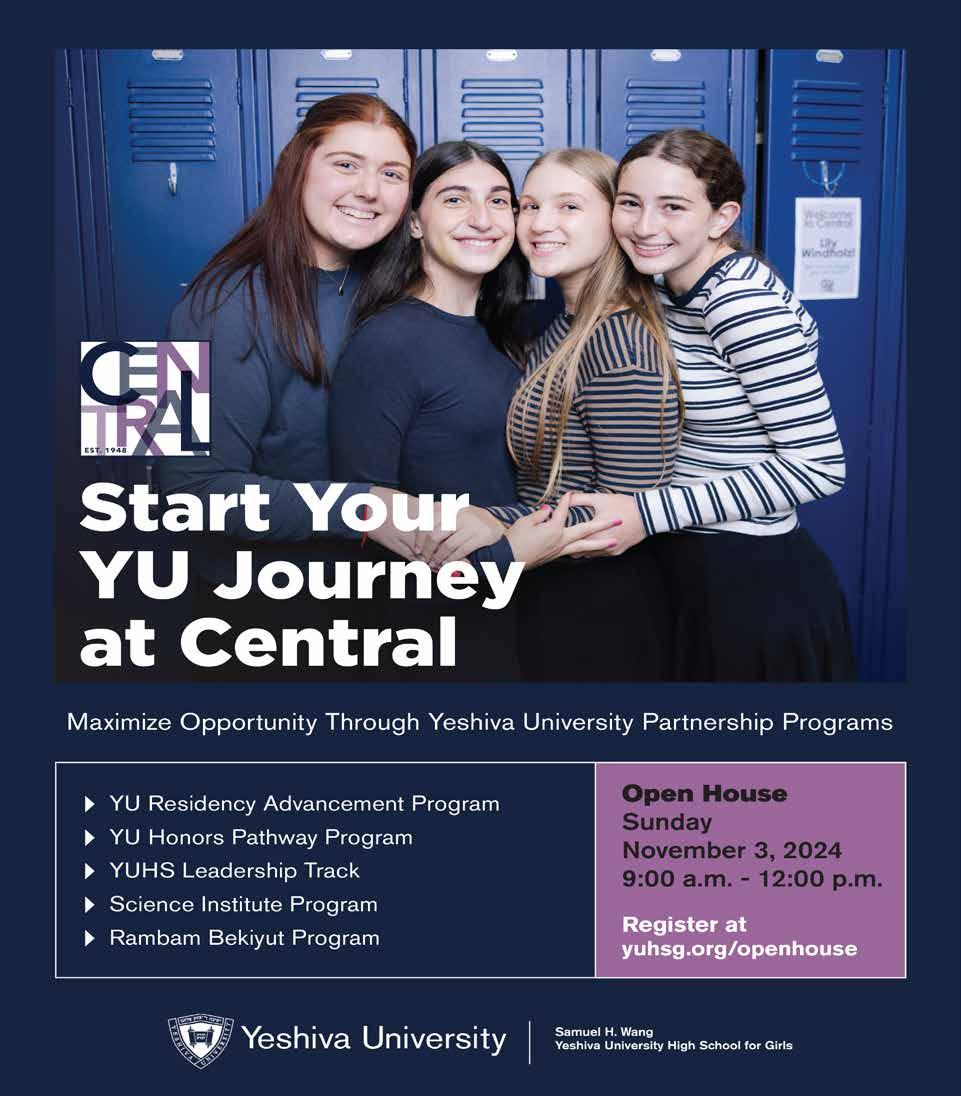
By
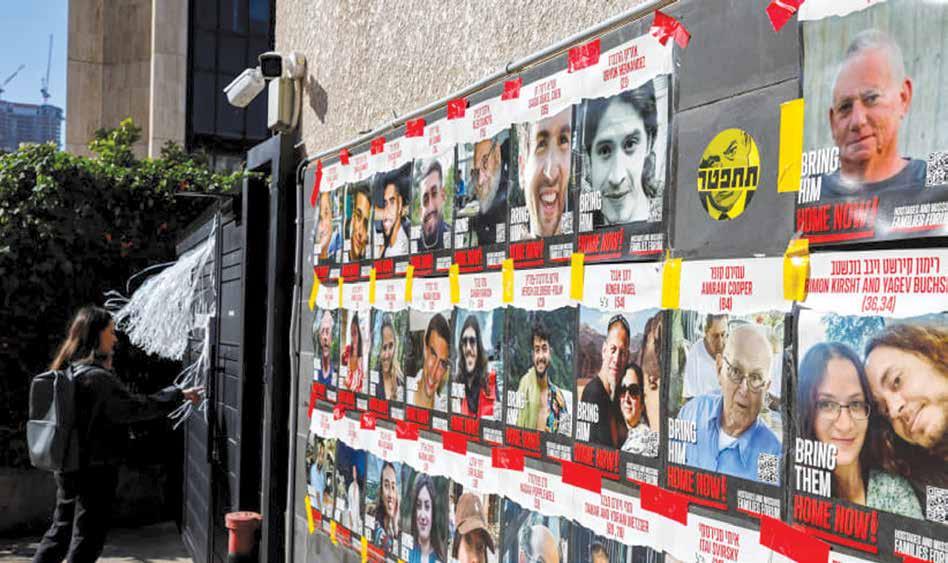
When Moshe Rabbeinu was asked to speak to Klal Yisrael about leaving Mitzrayim, the Torah says, “V’lo shamu el Moshe mi’kotzer ruach u’mei’avodah kashah.” Sometimes we are unable to hear, internalize, appreciate, and understand. There is just too much noise, too much politics, too much trauma, too much pain or just a general overload of information that clouds our ability to hear and properly comprehend.
“Lo hibit aven b’Yaakov…v’ya’su olam agudah achas…”
Over the past year, thousands have made solidarity trips to Eretz Yisrael. The Jewish people have supported one another and continue to contribute significantly to every aspect of the war effort. Though our brothers and sisters in Eretz Yisrael are the ones on the front lines of this war, Jews throughout the diaspora have come together and participated with hearts full of chessed, overwhelmingly generous wallets, and enthusiastically passionate tefillos. Certainly, there is independent value in visiting the sites of devastation and bearing witness to the monstrous atrocities of our enemies. We must hear the firsthand accounts of those who stared evil in the face and are alive to speak about the experiences of these unimaginable horrors.
But is there perhaps more that one could come home with and apply to everyday life?
“Mi yanuch, u’mi yanuah, mi yishakeit, u’mi yitareif…”
The layers of communal and personal trauma in Eretz
Yisrael are overwhelming. We decided that identifying one story, one individual, one family, or one community would be a more realistic way of making a meaningful and substantive impact.
“Machnisei dimah hichnisu dimoseinu…”
Over the past few months, our community, The Young Israel of Woodmere, has been privileged to host many individuals who have been affected by this war – widows, orphans, survivors and released hostages. We have been transformed by the life lessons, the deep insights, the courageous resiliency, and the overwhelmingly positive perspectives that they have shared around our Shabbos tables and in our personal homes. It has become normal for our children to converse, play, and relax on the couch with released hostages, newly minted widows and bereaved parents, and families of current hostages. Each one is an entire world unto him or herself. Each one experiences his or her own profound trauma and attempts to heal their painful wounds.
Below is just a small sampling of the impactful conversations and experiences that have transformed us as a family. So many of the anecdotes are too startling to share, and in an attempt to preserve their privacy, we have left the names and identities out of many of the stories. In sharing these powerful anecdotes, it is our hope that the knowledge of the reader is expanded, his feelings deepened, and his compassion and drive to help amplified.
“Shomeah el evyonim u’ma’azin chinunim…”
At close to 2:00 a.m., in a dark and moldy underground Hamas tunnel, a young, panic-stricken woman suddenly woke the other four Jewish women who were being held together in captivity. She instructed them to get off their mattresses immediately. Fearing the worst, they were then instructed to come closer together and hold hands. Having no idea where this feeling came from, she then began to lead them in singing the words, “Shir hamaalos, esah einai el he’harim me’ayin yavo ezri.” For the ensuing thirty minutes, they all sang and then screamed together, “Ezri me’im Hashem. Ezri me’im Hashem. Ezri me’im Hashem.” As they were being mercilessly tormented in captivity, these women felt a deep conviction that the only possible salvation would come from the Ribbono Shel Olam Himself. That imagery of screaming to Hakadosh Baruch Hu from the depths of despair has profoundly changed my understanding of the words “mi’ma’amakim kirasicha Hashem.”
“Asher b’yado nefesh kol chai…”
After meeting with the most powerful leaders in the world to plead for her son’s safe return, a hostage mother sent me the following text: “Hashem will save my son and all of them. It is so obvious. Psheeta. Everything else is tafel and hishtadlus. These important men who think they know the reasons, the statistics and the proper negotiating tactics, they don’t see that it is
all avodah zarah. They do not understand that it will come solely from Hashem.”
“Simcha l’artzecha v’sasson l’irecha…”
Throughout the millennia of this painful galus, we have been davening incessantly for a Geulah. We imagine what that utopian experience might feel like and how dramatically our world will change when will finally be redeemed, but how much and how seriously do we consider the reality of our redemption?
A hostage mother painfully showed me the suit that she had purchased, the plates that she had ordered, the menu that she had drawn up, and the tablecloths and napkins that she had chosen for the upcoming Seudas Hodaah when her son would be returned to his loving family. Tragically, he was ruthlessly murdered in Hamas captivity.
As I looked at all that was prepared, I asked myself: do I actually believe in the coming of Mashiach as much as this mother believed in the improbable possibility of her sons miraculous return home? Is there anything practical that I have prepared for the actual moment of Mashiach’s arrival?
“U’btzel k’nafecha nechesa v’nislonan…”
At an event in Eretz Yisrael last week, I introduced an almanah to the very sensitive team of rabbanim from Machaneh Shurah (the IDF’s army base focusing on issues of halacha and chevra kadisha). I had told her that these compassionate tzaddikim were the ones who had so gently and lovingly cared for her husband in the days after October 7. She was overwhelmed to have met them and then said, “I really need to thank you. As I was driving to the levaya, I genuinely felt as if my husband was being brought to his wedding with Hakadosh Baruch Hu. I must thank you for being the warmhearted people who attended this very sacred chuppah and volunteered to walk him down the aisle.”
“Ha’yom t’gadleinu…”
As he safely stepped onto the IDF helicopter after 128 days in Hamas captivity, Louis Har, a rescued hostage, shared the iconic words that he overheard the IDF commander declare over the radio – “ha’yehulomim b’yadeinu” – the diamonds are in our hands! If only I too could learn from them, that every Jewish soul is indeed a precious diamond that is worth risking our lives to save.
“Areshes sifaseinu ya’erav lefanecha…”
Upon arriving at Tel Hashomer hospital to be reunited with their father, Louis’s family insisted on first having a conversation with the commanding officer who had led the raid. They repeatedly asked whether any IDF soldiers had fallen in the rescue mission. Reluctant to respond, the officer finally inquired, “Why do you need to know?” They emphatically responded, “If there is an almanah currently grieving alone in her home because of our fathers’ rescue, we must first travel to her home, give her a loving embrace, and only then enter our fathers’ room to be reunited and celebrate.” The ability to selflessly put the needs of others before our own has taken on an entirely new level of meaning to me.
Iris Haim’s hostage son Yotam was mistaken for a Hamas terrorist and was tragically killed by IDF forc -
es. Iris has repeatedly verbalized her immeasurable love and support to these soldiers who made this devastatingly tragic mistake. She has invited them to her home numerous times, so that they can feel the sincere love and appreciation that she has for each of them. She harbors no hard feelings toward them at all and is only filled with adulation and respect for the sacred work that they continue to do. What an enormously powerful lesson in the human ability to be ma’avir al middosav in a most extraordinary, heroic way!
One young woman shared that she offered a daily tefillah to Hashem in Hamas captivity that the IDF not attempt to rescue her. The thought of a soldier potentially being killed for her safe return was a reality that she felt she would never be able to live with. She preferred staying in captivity for life, rather than bearing the pain of a broken family who would lose their loved one on her behalf.
“V’yaeida kol pa’ul ki atah p’alto…”

Julie Kuperstein, a sincerely devoted baalas teshuva for the past thirteen years, has been awaiting the safe return of her son Bar who was a security officer at the Nova Music Festival on October 7. Julie was asked what she feels about members of her community who seem to be moving on with their lives while she continues to endure the standstill of torment and unimaginable uncertainty. Without a moment of hesitation, Julie responded, “You seem not to understand! My son is in the hands of the Borei Olam! He has not yet returned because he has not yet finished his personal shlichus.”
Since becoming a baalas teshuva, Julie has suffered unbearable hardship. A number of years ago, while responding to a volunteer Hatzalah call, her husband was severely injured and handicapped from an accident on his way to the call. Julie now agonizingly awaits her son’s safe return from Hamas captivity. Through this staggering experience, Julie was asked whether she ever regretted her courageous choice of thirteen years ago to believe in Hashem? Have these experiences not rattled her emunah in a most radical way? Once again, without a moment of hesitation, Julie responded, “The truth is that the Borei Olam does not owe me anything. He is the Borei Olam and not I.”
“V’Hu echad u’mi y’shiveinu…”
After surviving 11 months in Hamas captivity, Ori Danino was murdered in cold blood by his captors. With absolute faith and clear conviction, his mother Einav told me during the shivah, “Ein davar rah yoreid min ha’Shamayim” – there is nothing bad that comes from heaven. “Abba lo oseh rah l’yeladim shelo” – a father never chooses to harm his children. “I am grateful to Hakadosh Baruch Hu that I was privileged to bury my son. Not only
to bury him in Eretz Yisrael but in Yerushalayim. I was not only privileged to bury a part of his body, but his body in its entirety. For this I offer thanks to Hakadosh Baruch Hu every single day.”
“Zacharti lach chessed ne’urayech…”
On one occasion, there was a small bottle of grape juice that had been brought to a group of three hostages. The three agreed to ration and split it evenly among themselves. When the third hostage, a young boy, received his portion, he assuredly said, “Ani tzamei aval ani shomer es zeh l’kiddush leil Shabbos” – I am thirsty, but I am saving my portion for Friday night kiddush. He then remembered that when eating challah at a Shabbos meal, one generally dips the bread into salt. Looking at the small remnants of his bagel, he then proceeded to scrape off the salt and spices, so he would be able to dip his stale bagel into the salt later that evening after reciting his Friday night kiddush.
The Gemara describes the importance of being mindful of Shabbos throughout the days of the week. This inspiring anecdote has made me consider my own anticipation and preparedness for Shabbos.
“Hashem tzivakos yagein aleihem…”
In life, we try to be sensitive and nonjudgmental. It is impossible to know what might be going through the mind of another person and why at times our words may evoke certain reactions. Chazal encourage us to be forgiving and understanding, as one simply never knows what might be happening in the life of another.
When picking up one of the released hostages from the airport in New York, I very innocently said, “Welcome to New York.” The reaction to my innocuous words was visceral. After a few moments, she regained composure and explained, “When I was driven into Gaza in the pickup truck, the first thing I was told by these evil terrorists was, ‘Welcome to Gaza.’ Your comment brought me back into that painfully traumatic moment.”
It is impossible for us to know what specific traumas people might be living with. Sensitizing ourselves to the reality that we are simply unaware of much that goes on in the minds of other continues to be a critically important lesson for me.
“Ba’u she’arav b’sodah…”
Before telling her six children the devastating news about their father’s heroic death on October 7, an almanah called all her children into the living room and said, “Our home has always been a happy home. Our home will always be a happy home. Look at the pasuk hanging on the wall – “hafachtah mispadi l’machol li…” Now let me tell all of you that Abba, your father, is a hero and that is a gene that all of you have from him. You too are


all heroes, and you will all heroically choose life and live it with great joy, as Abba would have wanted from you.”
“Lo sachpotz b’mos ha’meis…”
An almanah told me that since losing her husband on October 7, the most compelling bracha of Shemoneh Esrei has been “mechayeh ha’meisim.” Because the fear of loneliness and the passionate yearning to be reunited with him have been completely overwhelming, when she recites this bracha every day, she has developed a new kavanah that gives focus beyond the obvious meaning of the words. “Please, Hashem, reignite the parts of myself, the lonely almanah, that seem to be dead! Give life to the numb and paralyzed parts of me that have been anesthetized since the passing of my beloved husband.
Give me strength, energy, vigor, and vitality to remain afloat in these turbulent waters.”
If you have felt depressed and helpless at any point over the past year, consider the heartfelt tefillah of this almanah when reciting mechayeh ha’meisim.
“Im k’vanim rachameinu k’racheim av al banim…”
A harrowing text conversation took place between a father and his daughter on the morning of October 7. He informed his daughter that terrorists had completely overrun their kibbutz and that he was locked in a safe room. When she asked why he had not called the army, he responded that there were no army personnel available to assist him. The terrorists then broke down the door and began to set the house on fire. Completely

panicked, she pleaded with her father once again to call the army and inform them about his dire situation. At 11:07 a.m., her final WhatsApp messages to her father were no longer received. The last desperate message she sent her father was “Abba, ta’aneh b’vakasha – Father, please answer me!!”
As we close in on a year of this immeasurable evolving tragedy, I have thought about the power of external hearing, of internal listening, and I too petition and continue to cry out to our Abba and plead with Him during this dynamic teshuva season, “Abba, ta’aneh b’vakasha!”
Rabbi Shay Schachter is the associate rabbi at Young Israel of Woodmere.



By Rabbi Shmuel Reichman
Genuine teshuvah is not just about self-transformation; it’s about self-expression, returning to your true and higher self. As we have previously explained, there are three stages of genuine teshuvah:
• The first is individual teshuvah, where we return to our higher selves, our fetal selves, our true selves.
• The second stage of teshuvah goes beyond the limited self, turning the focus from individual to community.
• The third stage of teshuvah is returning to our absolute root and source, to the Source of all sources, to Hashem Himself.
We will now display how these three stages parallel the three themes of the Rosh Hashana tefillah.
The Rosh Hashana Tefillah
The three main themes of the Rosh Hashana davening are Shofaros, Zichronos , and Malchuyos Shofaros relates to the blowing of the shofar; Zichronos relates to remembering seminal events from Jewish history and Hashem’s covenant with the Jewish People; and Malchuyos is the process by which we crown Hashem King.
Judaism is a holistic religion, in which everything is interconnected, expressing an underlying oneness. What then is the underlying connection between these three themes?
Shofaros
The shofar represents one’s individual spiritual yearning. It is a haunting, wordless cry that brings us back to our higher self, our fetal self.
The bracha we recite on the shofar refers to the “kol shofar ” (voice of the shofar). This is because blowing the

shofar is meant to draw our attention to the unique depth of the shofar’s role in our tefillah. We blow the shofar as a part of the Rosh Hashana prayers, but it is unique amongst the tefillos. While all the other prayers utilize words, the shofar is a wordless cry. What is the meaning behind this?
Speech is always a limited expression of one’s inner thoughts. Formulating ideas and feelings into words requires taking that which is abstract, beyond finite form, and giving it concrete form and expression. By doing so, one limits that infinite potential into just the words that are spoken. This is why words often fail to describe and convey that which is most important. Words are a limited form of expression; they cannot convey the full force of “self” contained within them. Kol, however, is the root form of verbal expression, a speech that has not yet been formed into words. The wordless cry of the voice is not limited to specific words; it is beyond words and
beyond finite expression.
On Rosh Hashana, we cry out with the resounding “kol shofar,” expressing our deep yearning to return to our root selves — a yearning that cannot be expressed in words. As the blast of the shofar jars us from our stupor, we join in its cry as our souls beg to return to their root.
This is also why the concept of kol is connected to crying. When does one cry? When the clear path ahead loses its clarity and expression. When one hears the doctor’s report and finds out that instead of fifty years, they have only weeks left to live, they cry. Or, on the flip side, when one receives the news that instead of having a couple of days left in this world, they have been completely cured, they cry. When the clear and expressed path breaks down, we cry. This is why the Hebrew word for tears, “dim’ah,” is also the Hebrew word for “mixture,” something that is unclear and confusing. The spiritual concept of
crying is the breakdown in expression. This is also why the root of the Hebrew word for “crying” (bocheh) is the root of the Hebrew word for “confusion” (mevuchah) as well.
(When the Meraglim (spies) delivered their negative report about Eretz Yisrael, Klal Yisrael cried. Chazal (Taanis 29a) note that this was an inappropriate form of crying (bechiyah shel chinam — a baseless cry). In Klal Yisrael’s eyes, the road to Eretz Yisrael was broken, and the path toward their destiny was shattered. But in reality, this was not true. As punishment for inappropriately crying, for incorrectly viewing the clear path as broken, Hashem made that day, i.e., Tishah B’Av, a day of genuine crying (middah k’neged middah, measure for measure). Tishah B’Av became the day of all breakdown and crying, and it became the day where we actually lost our place in Eretz Yisrael; not by choice, but by exile [both in the midbar and later on in Jewish history].)
On Rosh Hashana, we cry out with a resounding kol, expressing how deeply we yearn to return to our source, to Hashem. The concepts of both kol and crying focus on the root and source instead of the expression. Kol is the root of speech, and crying brings us back to a formless, root state where no outward expression is clear. On Rosh Hashana, we take a step back from the expressed physical world and return back to our transcendent source.
Zichronos
Zichronos refers to the concept of memory, building upon this same theme. Memory represents tracing something from the present back into the past, of sourcing something back
to its root. On Rosh Hashana, as we discuss the Akeidah and other seminal moments in Jewish history, we connect back to our collective self, the root soul of all of Klal Yisrael.
The Akeidah holds infinite layers of depth and meaning, and it has striking implications for us as we trace ourselves back to our collective self. At the Akeidah, Yitzchak was willing to give up his life. The willingness to give up one’s life for Hashem reflects the belief that one is not merely a physical being but a spiritual consciousness that transcends their physical body. This is why Chazal note that the letters of Yitzchak’s name spell “keitz chai ” — he who lives (chai ) while paradoxically also existing beyond life (keitz). At the Akeidah , Yitzchak rooted himself beyond space and time while still living within it.
On Rosh Hashana, we remember this; we tap into our unique nature as Klal Yisrael, a nation that transcends this world while paradoxically living fully within it. The root of our ability to do so stems from Yitzchak and the Akeidah
Malchuyos
On Rosh Hashana, we crown
Hashem as our Melech (King). We declare Hashem to be the Source of everything, our ultimate root. This is our mission in this world — to become a walking kiddush Hashem , fully connecting ourselves back to Hashem, our Creator. It is for this reason that we don’t mention vidui or any of our sins on Rosh Hashana. Our singular goal on this day is to source ourselves back to
ourselves within reality, connecting ourselves to Hashem, our Melech. Before we discuss the quality and nature of our existence (Yom Kippur), we need to ensure that we exist in the first place (Rosh Hashana).)
Our Three-Stage Ascension
While all three of these themes are connected to all three forms of teshu-
As the blast of the shofar jars us from our stupor, we join in its cry as our souls beg to return to their root.
Hashem, crown Him as our King, and root ourselves within reality, connected to Hashem.
(On Yom Kippur, we focus on the details of our past year and the quality of our upcoming year. On Rosh Hashana, however, our goal is simply to root
vah, Shofaros most deeply reflects our individual teshuvah; Zichronos most deeply reflects our collective teshuvah; and Malchuyos most deeply reflects our ultimate teshuvah, sourcing ourselves back to Hashem Himself.
May we be inspired to fully actual-
ize all three forms of teshuvah this Rosh Hashana and seal ourselves in the Book of Life, the book of true existence.
Rabbi Shmuel Reichman is the author of the bestselling book, “The Journey to Your Ultimate Self,” which serves as an inspiring gateway into deeper Jewish thought. He is an educator and speaker who has lectured internationally on topics of Torah thought, Jewish medical ethics, psychology, and leadership. He is also the founder and CEO of Self-Mastery Academy, the transformative online self-development course based on the principles of high-performance psychology and Torah.
After obtaining his BA from Yeshiva University, he received Semicha from Yeshiva University’s RIETS, a master’s degree in education from Azrieli Graduate School, and a master’s degree in Jewish Thought from Bernard Revel Graduate School. He then spent a year studying at Harvard as an Ivy Plus Scholar. He currently lives in Chicago with his wife and son where he is pursuing a PhD at the University of Chicago.
To invite Rabbi Reichman to speak in your community or to enjoy more of his deep and inspiring content, visit his website: ShmuelReichman.com.

The Gemara states that Rabbi Yochanan ben Zakai was actively involved in business for forty years. Undoubtedly, during those years, he understood all the deceptive tactics that an unscrupulous dealer may employ. Rabbi Yochanan then contemplated delivering a shiur that delved into the topic of honesty during commerce, drawing upon his own extensive experiences. This shiur would ensure that honest businessmen do not inadvertently commit fraud.
However, giving this lecture would reveal many deceitful practices. This left Rebbe Yochanon in a dilemma. If he delivered the lecture, dishonest people would learn new ways to trick their customers. On the other hand, if he refrained from delivering the discourse, fraudsters would claim, “The only reason these righteous people are honest is because they don’t know any other way. Surely, if they were as knowledgeable as we are about these deceptions, they would be the same criminals we are.” This weak attempt at self-justification would encourage the thieves to commit more crimes. They would argue that everyone, deep down, is as dishonest as they are. The lecture would dispel this notion, and show that although righteous people are indeed knowledgeable about acts of trickery, they remain honest.
The Mahrasha questions why Rabbe Yochanon Ben Zakai needed this last reason (to prevent criminals’ self-justification) to deliver the shiur. What was his original purpose? It was to ensure that honest businessmen could indeed be honest, as they might mistakenly err. They needed to learn what not to do in order to prevent unintentional fraud. However, the reason stated in the Gemara for delivering the shiur is that he wanted to show criminals that tzaddikim remain honest even though they are well versed in the art of deception. Why did he change his original reasoning?
By Rabbi Avrohom Sebrow

The Ahavas Aisan explains that, at this point, Rabbe Yochanon Ben Zakai did not think that the possibility of honest merchants accidentally committing fraud was a significant issue. After all, if the merchant was trying to be honest, they probably wouldn’t fall into the pitfalls of fraud even accidentally. And
“For the ways of Hashem are straight, and the righteous will progress in them but the wicked will stumble in them.”
Regardless of what any wicked thief might do with the knowledge he gained from the discourse, the shiur still needed to be delivered. Honesty and integrity are such important qualities that
ed by a famous story mentioned by the Rashbam (Bava Basra 89a). According to the story, Rav Safra was reciting the Shema when a customer walked into his store. The customer offered to pay a certain price for an item that he wanted. Despite the potential financial gain, Rav Safra, committed to fulfilling the prayer without interruption, did not respond to the customer’s offer. The customer, misunderstanding Rav Safra’s silence as a lack of interest in the initial offer, proceeded to raise his offer multiple times. However, Rav Safra continued with his recitation of the Shema without acknowledging the customer’s increasing offers.
After finishing reciting the Shema, Rav Safra explained that he had already agreed to the initial price offered by the customer in his mind and would not break his internal commitment, even for a potentially lucrative profit. Despite the opportunity for personal gain, Rav Safra sold the item to the customer at the original offer price, demonstrating an unwavering commitment to honesty and integrity.
Honesty and integrity are such important qualities that even an accidental slight mistake made by a tzaddik is a terrible occurrence.
even if they did err, the discrepancy would likely be minor. So, while there would be some benefit, it wasn’t a decisive reason.
After explaining Rabbe Yochanon’s dilemma, the Gemara wonders, “What did he do in the end? Did he give the shiur or not?”
Rav Shmuel bar Rav Yitzchak says that he did. Rabbe Yochanon based his decision on the verse, (Hoshea 14:10)
even an accidental slight mistake made by a tzaddik is a terrible occurrence.
As the Ahavas Aisan pointed out, these mistakes will be rare; after all, we are discussing tzaddikim who are perfect in every other way. Yet, the Torah demands us to do our best, to be honest to an extreme, even avoiding unintentional slight errors in commerce.
The extent of the integrity the Torah demands of us can be further illustrat-
This story serves as a powerful example of the ethical standards upheld by individuals like Rav Safra, emphasizing the importance of honoring commitments, even those made solely in one’s mind. The Kitzur Shulchan Aruch tells us that this story is not meant just to highlight how great Rav Safra was. Rather, the story is cited so that we may be inspired to emulate the honesty and integrity displayed by Rav Safra in our own lives.
Rabbi Avrohom Sebrow is a rebbe at Yeshiva Ateres Shimon in Far Rockaway. In addition, Rabbi Sebrow leads a daf yomi chaburah at Eitz Chayim of Dogwood Park in West Hempstead, NY. He can be contacted at ASebrow@gmail.com.
Hashem, in His infinite kindness, has given us a gift in the Aseres Yemei Teshuva. How so? Not everyone, unfortunately, merited to receive a judgment on Rosh Hashana. Some people, have their spiritual report card pushed off. The Talmud Yerushalmi explains that the beinonim, the average people, are judged during these ten days of Bein Keseh L’Asor. If the average person successfully repents, then they are inscribed with the tzaddikim in the Book of Life. Indeed, even with the rashaim, although they are written down negatively, it is not sealed until Yom Kippur and that fate can be changed. The gift is that everyone receives a second chance.
The phrase “Bein Keseh L’Asor” is used to refer to the days between Rosh Hashana, when the moon is covered, to the tenth of the month, Yom Kippur. These ten days give all people the opportunity to make amends and correct their sins. Hashem comes closer to us and makes it easier to make those changes. The Talmud (Yevamos) understands the verse, “Dirshu Hashem behimatzo, seek Hashem where He may be found” ( Yeshayahu, 55:6) as referring to the Ten Days of Repentance.
We find that these ten days have significance in other places, too. Chazal also tell us that Hashem did not immediately punish Nahval, the first husband of Avigayil, for the sins he committed against Dovid HaMelech and for his tremendous inhospitality. Nahval deserved immediate punishment for this mistreatment. But Hashem did not inflict it then. Rather, Hashem gave Nahval the opportunity to do teshuvah during the Aseres Yemei Teshuvah. We see here the enormous power that these ten days possess.
In fact, the Midrash called Yalkut Shimoni tells us that the Anshei Knesses HaGedolah incorporated the ten verses of Malchios, Zichronos, and Shofros in the Mussaf of Rosh Hashana to correspond to the ten days of teshuvah — this is how
By Rabbi Yair Hoffman

important these days are.
The Shela explains that each day of the Aseres Yemei Teshuvah is progressively more and more urgent. Action should be taken in both areas of mitzvos bein adam l’Makom and bein adam l’chaveiro and all three tools should be utilized, teshuvah, tzedakah, and tefillah.
There are seven days that are in between the two days of Rosh Hashana and the one day of Yom Kippur. The Seforim HaKedoshim explain that during each of these seven days, Sunday through Shabbos, it is possible to do teshuvah for every Sunday that we sinned throughout the year on that corresponding day of the seven days. So on Tuesday of the Aseres Yemei Teshuvah, we can atone for every Tuesday in that year.
The nation of Israel was given a special role in Hashem’s Master Plan for the world. Up until now, we have only partially fulfilled this Plan — of being a nation of priests, bringing knowledge of Hashem to the world. Indeed, the davening on Rosh Hashana emphasized the hope and dream when all the nations would form one agudah to do His Will. The Torah commands us to make sure that we not
forget this special role and even provided us with special mitzvos to make sure that our role not be lost. The Mishna in Tractate Avodah Zarah tells us that the rabbis forbade a number of items that were made or owned by the surrounding gentiles. Their concern was of the possibility of intermarriage, and of losing the special destiny that G-d has planned for us. One of the items mentioned in the Mishna is bread produced by gentiles.
During the Aseres Yemei Teshuvah, it is our custom not to eat what is called “pas palter, baker’s bread.” This refers to bread or flour items that were baked under non-Jewish ownership. Regular kosher bread, cakes, pretzels, cookies and ice cream sandwiches are not to be eaten during this time. It may only be eaten if the words “Pas Yisroel” appear on the supervision.
There are a few reasons for this stringency. One reason, according to the Tur, is that during these days we try to fulfill all our mitzvos, both Torah and rabbinic mitzvos, in the most pure and ideal manner possible. How is Pas Yisroel more ideal? In the past, the sages forbade us from eating all bread and mezonos items that
were baked by non-Jews. However, this prohibition was partially repealed by the rabbis because the majority of our people were unable to adhere to this stricter ruling. However, during the Aseres Yemei Teshuva (and according to the Mishna Berurah on Shabbos, too), we avoid eating pas palter.
Another reason for this stringency, according to the Levush, is to serve as a reminder of how unique these days are.
A third reason, according to the Chayei Adam, is that we are asking Hashem not to be strict according to the law; just as we are doing something extra that is not strictly required of us, we ask Hashem not to be strict with us.
Tefillos and Additions
We must take enormous care to make sure that we add the appropriate additions to the tefillah during the Aseres Yemei Teshuvah. One such addition is the fact that in Shemoneh Esrei we say, “Oseh hashalom bimromav” instead of “oseh shalom bimoromav.” The Arizal explains that “hashalom” in gematriah is equivalent to the name of the angel in charge of inscribing, “Safriel.”
During the Aseres Yemei Teshuvah ,we also try to be stringent regarding other mitzvos, too, not just Pas Yisroel. Some people try to purchase their lulavim and esrogim during this time in order to get more mitzvos. The seforim say that if someone is not careful to eat glatt kosher all year round but just regular kosher, he or she should keep glatt kosher. For this reason, it would also be appropriate to be stringent in Cholov Yisroel during this time, if it is possible. It is not worthwhile, however, to cause a machlokes over a chumrah.
This article should be viewed as a halachic discussion and not practical advice. The author can be reached at yairhoffman2@ gmail.com.

By Barbara Deutsch
We have never been in Yerushalayim for Rosh Hashana. Despite the “three day yom tov,” we are looking forward to savoring every minute of the chagim. We have waited a very long time to celebrate a new year at home.
The days grow shorter and the air crisper; most people here continue to dress for hot weather without feeling any need for sweaters or jackets. Fall has always been my favorite season; I love the autumnal foliage (not much of that in Jerusalem), the feel of the clothing, boots/booties and layering.
The weather change reminded us that now that we have been here for almost three months, we have to check in with reality and plans need to be made for doctor appointments and checkups; we all tend to try to avoid those visits as long as we can.
As soon as we could, we picked a Kupah (Health Network). Particularly in Israel, every single bit of important information is shared through a complicated system of “word of mouth.” In the past, it was literally heard “in the streets”. Today, news travels through every imaginable type of WhatsApp chat.
Hard to imagine, but there was a time when young and old kept up with the world and each other without WhatsApp; truth be told, it is pretty awesome and free.
Armed with my calendar, teudat zehut, list of recommended doctors, referrals from my primary doctor (Dr. Martina met with her once for an interview where we exchanged lists of meds) and our host of medical appointment needs, I took a deep breath and made the connection to the Maccabi Call Center.
I followed all of the prompts and landed on press 4 for English, right after Arabic and before French. “Shalom, Chaim here,”
said a heavily Hebrew accented voice.
My immediate response was, “Do you speak English?”
“Of course!”
Before we made aliyah, we actually did something smart and unusual for us. We made all of our doctor visits for what ails us with the wonderful people whom we had come to rely on to keep us as healthy as 70-plus-year-olds can be. We have the usual ailments that a mostly worn down machine exhibits after a pretty active working life, eating a moderately healthy diet and who are the offspring of tough Holocaust survivors.
Despite all of our detailed preparations, recommendations, the guidance of determined “Chaim” as our helpful scheduler, and a solid hour of trying to book three appointments with three different specialists, we got the appointments and we needed but not a single one with a doctor who was on our carefully curated highly recommended list of the best doctors to see.
“Go private or call the office yourself,” Chaim suggested. “I can’t book if the system won’t let me.”
Had this hour on the phone been spent in the U.S., I can guarantee that I would have completely lost it on the receptionist and my patient and better equipped when it comes to handling frustration husband. “How did I get this job?”
“I do the laundry, shop and cook,” was his response.
He does.
At a recent shiva call, one of the mourners was Dr. Shira, a brilliant former Morasha camper of mine. As we were sharing how lives evolve and her busy life as a doctor in Israel, one of the visitors who knew her as a young girl asked Shira her specialty and married name. Openmouthed and

shocked, the visitor pronounced, “You are the world-class neurologist Shira? I have been trying to get an appointment with you for over a year!”
Shiva was not the time to check availability and calendars.
November will now be Medical Health Month. Before each appointment, we have to schedule blood tests; not sure why, but they take a lot of blood here. The labs are only open for two hours in the early morning, you can walk right in but woe to anyone who comes even a minute past closing: “Come back tomorrow!”
A glutton for punishment, I spent that very same afternoon making appointments with our tried and true doctors in the United States; we kept our health plans and benefits. After an hour on the phone figuring things out with every different Northwell office and those who are still independent, February is also Medical Health Month.
Walking the hills of Jerusalem makes for some serious workouts. In the months that we have been here, we have noticed that our stamina has improved, and we don’t find ourselves out of breath as we climb the hill to our door. We have also learned to better navigate the blocks in order to avoid deep inclines when we can; we are not daunted by their prospect.
When calling for appointments for well visits, be aware that the process is taxing and simply making them has the potential for making you feel sick. And it is clear that there are growing similarities between the much-maligned Israeli and American systems. Hopefully, we will learn to trust and gain confidence in the way things work in Israel.
The real hills are the emotional ones,
the highs and lows of the continued battles with our enemies. Wherever we turn, there are old and new ones waiting to destroy what we cherish and fight so very hard to preserve. In Yerushalayim, the streets are quiet, and people do their best to live normal lives.
We went to the National Library of Israel last night to see an original musical about the changing tides before World War II, themes similar to what we are experiencing right now. The venue is magnificent, a must to explore when in Jerusalem. The place is exquisite.
Right before the curtain call, the head of security spoke to the audience of mostly senior Anglos. He outlined the protocols for sirens interrupting the program, “Stay seated until we determine if it’s a threat or a real danger.” In our many years of theater going, we have never been warned before. We are in a brand-new magnificent venue being reminded that we must always be on guard. We do what we can to stay safe and healthy; we live our lives and put our trust in Hashem.
Grab a sweater. It gets cold in shul. It’s Rosh Hashana.
Wishing all peace in Israel and in our lives. With best wishes for a happy and blessed New Year; most importantly, a healthy one!
Barbara Deutsch is the former associate principal at HANC, middle school principal at Kushner, and Dean of Students at Yeshiva of Flatbush. A not-retired educator, she is trying to figure out life in Israel through reflections on navigating the dream of aliyah as a wife, mother, grandmother, great-grandmother and friend.
By Gedaliah Borvick
In Israel, many streets bear the names of the sages Hillel and Shammai, who, despite their famous legal disputes, shared deep mutual respect. While standing at the intersection of Beit Hillel and Beit Shammai Streets in Tel Aviv during the Three Weeks, a friend remarked that this crossroads symbolizes the inspiring bond between these two sages and could serve as a remedy for sinat chinam, or baseless hatred, a divisive force within our people since ancient times.
The Jewish people are described in the Torah as “stiff-necked,” or stubborn, and maintaining unity has always been a challenge. Recently, the severe division over judicial reform and other issues has threatened national cohesion. The resulting demonstrations and threats not only disturbed the country but also emboldened our enemies to attack us
tion, the Second Temple was destroyed due to sinat chinam, or baseless hatred.
Many believe that the remedy is ahavat chinam, or baseless love. However, Rav Shalom Rosner, quoting others, argues that this approach misses the point. Instead, he suggests the solution is ahavat Yisrael, or love of all Jews. Each person is created in the image of G-d and has redeeming qualities worthy of love and admiration. Spending the time to understand and value every person can help foster peace.
Pirkei Avot 5:17 offers valuable insight by noting that the debates between Hillel and Shammai endures because their disagreements were driven by the pursuit of constructive legal outcomes. The Talmud (Yevamot 14b) further illustrates this by highlighting that, despite their differences, members of Beit Shammai and Beit Hillel intermarried.
Spending the time to understand and value every person can help foster peace.
on October 7, 2023. However, the surprising unity and resolve shown by Israel in response to the Hamas massacre highlighted the positive aspects of our stubbornness, as we rallied together to defend our families and homeland.
Despite this initial unity, discord is creeping back, and we risk returning to the historical patterns of division that have plagued us. According to our tradi-
Only through mutual respect and appreciation can disagreements be healthy and productive.
We have much to be grateful for. Our country is in capable hands, as the younger generation has met the challenges of this war with resilience and courage. Now, it’s our turn to set aside our divisions and entrenched emotions and begin anew by emulating the re -

spectful dialogue modeled by Hillel and Shammai. By cultivating an environment of understanding and appreciation across Am Yisrael, may we be able to
transform our disagreements into constructive discussions, merit divine salvation, and achieve true, lasting peace. Shana tova.
Gedaliah Borvick is the founder of My Israel Home (www.myisraelhome. com), a real estate agency focused on helping people from abroad buy and sell homes in Israel. To sign up for his monthly market updates, contact him at gborvick@gmail.com.



By Hershel Lieber
My readers are aware by now that I have traveled very often to Poland. Almost all my trips were in relation to either my participation as a lecturer at the Ronald S. Lauder summer and winter retreats or my annual trip to serve as the baal tefillah at Warsaw’s Nozyk Synagogue during the Yomim Noraim. On some occasions, I had different agendas and traveled to other cities within Poland. From my previous articles, many people also know of my connection with the Yeshiva of Kishinev, Moldova, where I was immersed in all aspects of its existence between the years of 19932006. As a result of my frequent travels, I became an expert of sorts regarding travel opportunities to various sites that Jewish travelers have an interest in seeing. In relation to my knowledge I was frequently asked for travel advice, and on occasion, I was engaged in leading a heritage trip to the “Old Country.”
In the summer of 2002, my brother Yossi asked me about organizing and leading a group tour to Poland for himself, eight friends, and their wives. I was excited about the prospect of guiding them and did not even desire renumeration. I did have one condition: I asked that the group join me after the Polish leg of the trip for two days in Kishinev. My intention was to show them the kiruv work that we were involved with at the boys’

yeshiva and at the girls’ school. My hope was that the participants would extend financial help to keep our project going. I threw in a shabbos stopover in Budapest,
charged excitement within the group, and a departure date was set for Sunday, October 27.
We met at Newark Airport late Sun-
Walking solemnly through the dismal barracks, we could hardly hold back our tears and emotions.
Hungary, as an additional enticement.
I organized a meeting in September with the entire group where I presented our itinerary and described the sights that we would be seeing. There was a

day afternoon. Together with Yossi and Idii, we were joined by their friends Moshe Chopp, Yakov Finestone, Moshe Fuchs, Tommy Gelb, Shaye Lieberman, Shiya Roth, Yossy Rakower, a”h, and C.J.

Schnitzler and their spouses. Aside from the passengers’ luggage, Pesi and I put together over a dozen cartons containing food, plastic dishware and cutlery for our meals. I was providing breakfast (cereals, rolls, crackers, fresh fruit and vegetables, tuna, jam, peanut butter, cake, etc.) which we ate in the hotel dining rooms. Lunch was individually prepared by the group members from the selection of food that was displayed during breakfast. Dinners were double-wrapped individual trays to be heated up in the hotel ovens. The food came from Schick’s Caterers and was superbly delicious!
Although I was very involved in planning the daily itinerary and what sights we should take in, I had hired a Polish tour operator to book hotels, arrange coach bus transportation, and prepare the schedules for all our destinations. Wojtek was a very personable guide whom I first engaged during my summer stay in Poland and met again multiple times when I was there for Rosh Hashana and Yom Kippur. We worked extremely well together, and I engaged him again when I took a high school class from Yeshiva Ohr Shrage to Poland and Prague in 2004.
One important lesson I learned from many of our trips was the need to be flexible and make modifications to itineraries when needed. Becoming overwhelmed




was cancelled, and we were rebooked to Warsaw late that afternoon. I called Wojtek, and we switched our hotel accommodations from Krakow to Warsaw’s Radisson Hotel and changed the next day’s program as well. We took the extra time afforded by the flight change to go into Zurich for a ninety-minute walking tour. When we finally arrived to our hotel, we prepared dinner for our group and settled in for the night.
On Tuesday, Pesi and I got up at 5 a.m. to prepare the buffet-style breakfast, and I then joined the other men for Shacharis at the Nozyk Shul. After breakfast, we went by coach to Gora Kalwaria, also known as Gur the hometown of the Chadushei HaRim, the Sfas Emes and the Imrei Emes, the first three Gerer Rebbes. The beis hachaim where the first two Gerrer Rebbes are interred was being managed by the last Jew living in Gur, Feliks Karpman, who unlocked the gate so we can go in to daven and say Tehillim. He also took us to the former Bais Medrash of the Rebbes, where we toured the building. The edifice does not seem as large as what was told by chassidim. Thousands did come there for the Yomim Noraim and Shavuos, but it’s hard to imagine how they all fit in. When I was there in 1979, the building was being used as a furniture factory but presently the building is under Jewish ownership. We also saw the Rebbe’s residence two doors away.
We then boarded our bus for the approximately four-hour drive to Oswiecim, more commonly known as Auschwitz, and neighboring Birkenau, where over one million Jews were murdered by the Nazis, ym”sh. We had a very knowledgeable guide who was very sensitive to the fact that we were all descendants of survivors. We walked through the gates of hell where our silence spoke a thousand words. Walking solemnly through the dismal barracks, we could hardly hold back our tears and emotions. We stopped to say Tehillim, daven Mincha and say a mournful Kaddish.
history, and davening there was very meaningful. Though it was raining, our morning was dedicated to touring Kazimierz, Krakow’s Jewish district which began as a separate town for Jews in 1495. There are seven synagogues within a short distance from each other that survived the war, many of them dating back to the 16th century. Some of the shuls that we saw were the Izaak Shul, the Kupa Shul, the Popper Shul, and the historically acclaimed Old Synagogue. The most famous one is the Remu Synagogue, whose rabbi was Rav Moshe Isserles, who authored the Darkei Moshe on the Tur, and the Mapa (known as the Remuh) on the Shulchan Aruch. He is buried in the old beis hachaim right behind the shul. Also buried there are the Tosfos Yom Tov, the Bach, the Rebbe Rav Heschel, the Maginei Shlomo, the Megale Amukos, and many other notables. Interestingly, I have an ancestor, Malka Pitzele, who was also buried there, but that is a story in and of itself. We then went to the New beis hachaim where the Maor V’Shomesh and Rav Shimon Sofer and some other prominent personalities are interred.
At 1 p.m., we left by bus to Lezajsk (known in Yiddish as Lizensk) to daven at the kever of the Rebbe Rav Meilech
(1717-1787), the propagator of chassidism in Galicia, Poland. He was a talmid of the Mezritcher Magid and took over the mantle of leadership in 1772. The kever is visited by tens of thousands of people, especially during his yahrzeit on the 21st of Adar. We stopped in Lancut at the ohel of the Ropshitzer Rebbe and proceeded to Lezajsk. There, we lit candles, said Tehillim and recited the famous tefillah that the Rebbe Rav Meilech authored as an introduction to davening. It took five hours to reach our destination – rain the entire time and horrendous traffic, which we later found out had to do with the custom of Poles visiting cemeteries on the eve of All Saints Day (Halloween). The drive back was faster, but we arrived after midnight.
I had arranged that we would eat in a klezmer-themed restaurant after regular hours where they would warm up our double-wrapped meals. Our arrival time was supposed to be 10 p.m. We had called earlier about our predicament, and they accommodated us. The Klezmer group consisted of three male musicians who sang Yiddish favorites. We had our hot delicious meals while enjoying the songs and atmosphere. We even got up to dance to the lively klezmer music. Again, we enjoyed a fully active day, combining
and distressed when plans change is truly counterproductive. Our first snag occurred when we landed in Zurich on Monday morning and were waiting for a connecting flight to Krakow. The flight
We continued on to the Chevra Lomdei Mishnayos Shul, the only remaining pre-war shul which was refurbished and had an exhibition of the vibrant Jewish life that existed until September 1939. There, we davened Maariv and headed back to our bus. We drove to Krakow ,where we ate our dinner at the Ronald Lauder Club where we were addressed by Krakow’s Rabbi Sasha Pecaric. It was a long day, and we all couldn’t wait to go to sleep.
On Wednesday, we were up again at 5 a.m. to take care of breakfast. The men went to the Izaak Synagogue. This mid-17th century building has a unique


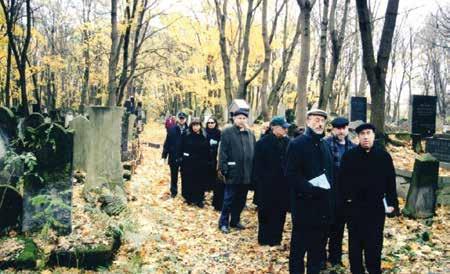


meaningful experiences with wholesome entertainment.
On Thursday, we left at 6 a.m., and we davened on the bus. We went to ZYCH, the Jewish Historical Institute, where we were addressed by Yale Reisner, who headed the genealogical department and told us about his interesting work and accomplishments. Then we went to the beis hachaim where we said Tehillim at the kevarim of Rav Chaim Brisker, the Netziv, the Chemdas Shlomo, and many other gedolim. We visited a small section of the Ghetto Wall and davened
Mincha at the Nozyk Shul, making up the leining that we missed in the morning. During the evening at dinner, we were addressed by Sharona Kanofsky, who was working for the Lauder Foundation, and Kostek Gebert, a journalist and correspondent of major Polish newspapers who is a recognized spokesman for his fellow Jews. We were also addressed by Monika Krajewska, a well-known Jewish artist who showed us some of her beautiful Jewish-themed artistic creations. Following the above speeches, our group also had the opportunity to express their own feelings and emotions about the past few days. Their impressions about Poland were definitely different from what they originally expected.
Friday, after davening at the Nozyk Shul and a quick breakfast, we boarded a plane that would take us to Budapest for Shabbos. We were just halfway through our trip, and we still had a lot more adventures ahead of us.
Hershel Lieber has been involved in kiruv activities for over 30 years. As a founding member of the Vaad L’Hatzolas Nidchei Yisroel he has traveled with his wife, Pesi, to the Soviet Union during the harsh years of the Communist regimes to advance Yiddishkeit. He has spearheaded a yeshiva in the city of Kishinev that had 12 successful years with many students making Torah their way of life. In Poland, he lectured in the summers at the Ronald S. Lauder Foundation camp for nearly 30 years. He still travels to Warsaw every year – since 1979 – to be the chazzan for Rosh Hashana and Yom Kippur for the Jews there. Together with Pesi, he organized and led trips to Europe on behalf of Gateways and Aish Hatorah for college students finding their paths to Jewish identity. His passion for travel has taken them to many interesting places and afforded them unique experiences. Their open home gave them opportunities to meet and develop relationships with a variety of people. Hershel’s column will appear in The Jewish Home on a bi-weekly basis.



By Eliyahu RosEnBERg
t was one of those beautiful days in May 1972 when the sky was a cloudless, perfect blue, and the air was fresh and sweet. For Avraham Schwartzbaum, an American sociology professor who, at the time, had been living abroad in Taiwan with his wife, it was a pleasant, quiet morning. Although he often took a cab or a bus to the University of Taiwan – where he worked as a visiting professor – on that particular day, he decided to take the train. And so, at around 6 a.m., the man got to the station, took a seat, and read his newspaper while he waited for his train to arrive. He definitely enjoyed the opportunity to relax, the time to think for a while unburdened by the distractions of everyday
life. Although, to be fair, it wasn’t as though his home was full of many distractions; if anything, it was too quiet. It was just him, his wife, and their housekeeper, Mei-Mei; no babies keeping them up all night or children running around the house. But to him and his wife, their quiet home didn’t seem particularly tranquil; it seemed empty. He and his wife Rochel had been married for around seven years at the time but weren’t yet blessed with children. And although they had been trying to adopt a baby back in the U.S., that, too, seemed like a hopeless endeavor, as there was a never-ending adoption waitlist. It seemed like they would never know the privilege of having a child of their own. But little did they know that, from one moment to the next, their
My father did everything with a tremendous amount of love, and he was able to instill in us a feeling of love of yiddishkeit. My parents had to hire Chumash tutors for me because they weren’t able to help me. But i always say that they were able to give me something that i ’m not sure many others really have, and that is such an appreciation and love for yiddishkeit, for the mitzvos, and for shabbos.
i always tell people that my story is a story of hashgacha pratis, and it shows how haKadosh Baruch hu is constantly in our lives, taking care of us. Even if we think he’s busy with this or that, he’s always watching over us, and you know, nothing’s ever by chance.
i am so grateful for everything that haKadosh Baruch hu has given me: my husband, my children, my friends, my children in-law, my grandchildren. a s l aurie guttman, a”h, a very special woman from Baltimore, said, ‘ i hope that when i get to shamayim, that hashem is as happy with me as i am with him.’
prayers for a baby would be answered.
As the professor sat alone, reading his newspaper, the empty silence of the station – and of his life – was suddenly shattered by what sounded like the cry of a baby. He reflexively looked up from his paper and briefly turned around to investigate. But when he found nothing of note, he dismissed the noise as insignificant and went back to the newspaper.
But after hearing the crying twice more, Dr. Schwartzbaum could contain his curiosity no longer. He rose from his seat and turned around, and that’s when he spotted the sight that would forever change his and his wife’s life: a bright red silk cloth seated right behind him. Intrigued, the man approached the scarlet jacket and picked it up gently. And lo and behold, wrapped within the beautiful silk was a precious baby girl, crying softly in the arms of the man that would soon be her father. The tiny infant had her umbilical cord still attached and a newborn film on her skin. The only hint of where the child had come from could be found on a tiny, handwritten note pinned to the beautiful scarlet jacket that enveloped her. It read, “May whoever finds this baby be blessed with health, happiness, and fortune.”
“That baby was me. And my father would always joke, ‘Well, the health came and the happiness came, but I’m still waiting for that fortune to arrive,’” Devorah Goldstein shared. “So, he picked me up and because he didn’t really know what to do with a newborn baby, he called over the transit police and gave me over to them. And then his train came and off he went.”
The professor went on with his day until 10:00 a.m., when he got to a payphone and did his daily “check in” with his wife. As Devorah explains, that phone conversation was a bit different than their usual ones. After he told his wife about the incident, she expressed strong disappointment
that he gave away the abandoned baby despite the fact that the couple had been looking to adopt for quite some time. And then she proposed that they track the child down and try to adopt her.
He agreed to give it a shot and canceled his classes for the rest of the day so that he could meet up with his wife at the train station. There, they asked the transit police where the baby was, and the officers directed them to a nearby orphanage run by a man named Reverend Wen. Thus, the couple made their way to the orphanage, knocked on the door, and were greeted by the reverend. Dr. Schwartzbaum explained that he was the one who had found the newborn baby that had just been brought to the reverend. But as soon as they expressed interest in adopting the infant, Wen became a bit standoffish, expressing concern over whether it would be responsible for him to give a Chinese baby to an American couple. But Dr. Schwartzbaum, an expert sociologist who could read people very well, saw that the reverend didn’t really care about the child’s heritage or wellbeing. Rather, Wen wanted to cut to the chase: how much money would they be willing to pay for the baby? And thus, the couple scraped together $25 and handed it to the man, promising to pay him another $75 later ($100 was a lot of money back then in China). And Wen couldn’t be happier. He handed the baby off to the couple, and the three of them went on their way.
“Most people have nine months to prepare for a baby, sometimes less, but usually you have a couple of months at least to know that a baby is coming. But my mother woke up that morning childless and walked out with a baby,” explained Devorah. “So, she really didn’t know how to deal with me. And she said that if anybody would have told her that this tiny little human being would be able to keep a grown adult up all night, she would have been like, ‘No way,
that’s impossible! I’m an adult and this is a child.’ But indeed, I kept her up all night. And if you look at pictures of her in the morning, you’ll see that her eyes are half shut and she’s exhausted, but she has this big grin from ear to ear. And she said it was the best night of her life!”
* * *
Devorah’s father, Avraham Schwartzbaum, later wrote the book, “The Bamboo Cradle,” about the incredible story of how he adopted his daughter and how it was because of her that he and his wife soon became frum.
“When my father and mother met each other, they were not frum. They both came from families that knew nothing about Yiddishkeit, although my mother has a side of her family that is frum,” explained Devorah. “The entire family was there to greet and welcome my parents back from China and to meet the new baby. One of my mother’s frum aunts came over to her and said, ‘Mazal tov! It’s so nice that you have this baby, but you know she’s not Jewish, right?’ And my mom said, ‘Yeah, we know. But don’t worry. We’re going to make her Jewish. How hard could it be?’ My aunt replied, ‘OK, well, I would like to ask you to do me a favor. I know you’ve waited so long for a child, but just give her the best conversion that is out there; something that won’t be questioned by anyone.’ My mother answered, ‘OK, sure, no problem.’”
Soon thereafter, the couple moved to Richmond, Virginia, and Devorah’s father became the University of Virginia’s Dean of the Sociology Department. Soon after they settled into their new home, they called an Orthodox rabbi and explained their situation to him. But, to the couple’s dismay, the rabbi refused to give their daughter a conversion unless they, too, would become frum. After all, it wouldn’t make sense to bring another Jew into the world that is going to grow up eating treif and living without a Jewish identity, the rabbi said. And so, they decided to find a different rabbi. They opened the phonebook, looked for rabbis, and decided to meet with one of them. As soon as they sat down together, the rabbi, eager to please his guests, handed the couple a piece of paper.
“Alright! This will be awesome!” the rabbi said enthusiastically. “Just sign this paper and your daughter’s Jewish!”
“Wait a minute. Isn’t there something more to this than just signing a piece of pa-

per?” Devorah’s father asked.
“Nope. Just sign this piece of paper, and she’s Jewish!”
“That wasn’t really what my parents were looking for either,” explained Devorah. “They thanked the rabbi, and they got up and left. My father couldn’t help but feel like there has to be something a little bit more to being a Jew than just signing your name.”
They tried to find another rabbi, someone who was more in the middle of the road. But the next rabbi that they went to also handed them a piece of paper and said that all they needed to make Devorah Jewish was a signature.
“Wouldn’t she need to immerse in the mikvah?” Devorah’s mother asked the rabbi.
“Oh, no, not at all. That’s old fashioned,” he responded. “But, if you really want to, we can all go to the JCC, we’ll kick everyone out of the pool, we’ll dunk your daughter in a couple of times, and it’s the same thing. It’s just water.”
“Well, I mean, it just doesn’t seem so spiritual,” she told him. “She’s joining the Jewish people. Shouldn’t it be something special?”
Suddenly, the rabbi burst out in a smile and said, “You’re absolutely right! You know what? We’ll invite the Chinese community to come join us! We’ll open our synagogue, we’ll combine Israeli food and Chinese food, we’ll play Israeli music and Chinese music, we’ll combine the cultures, and it’ll be an incredibly spiritual, uniting night!”
Rochel Schwartzbaum and her husband looked at each other for a moment, and it was clear that neither of them was crazy about the idea. So they got up, thanked the rabbi for his time, and walked out. At the time, Devorah was just a few months old, and her parents figured that it couldn’t hurt to wait a few more months to deal with her conversion. But, a few months somehow turned into a few years, and before they knew it, their little girl was four years old, ready to start going to school. They wanted to enroll her into a local Jewish school, but there was just one problem: she wasn’t Jewish.
“I always tell people that my story is a story of hashgacha pratis, and it shows how HaKadosh Baruch Hu is constantly in our lives, taking care of us. Even if we think He’s busy with this or that, He’s always watching over us, and you know, nothing’s
ever by chance,” Devorah declared. “My father was sitting in a Hillel House on a Friday, reading his newspaper like he always liked to do, and this young rabbi sitting across from him started to schmooze with him. He invited my father for Shabbos. So my father said, ‘Oh, that’s so nice of you, but it’s not just me. I have a wife and a child.’ And then they got into the whole conversation, and it came out that I wasn’t yet Jewish and that I needed to go to school and it was a little bit of a problem. So this rabbi says, ‘You know what? Come to my house for Shabbos, and I think I can help you after Shabbos.’”
And so, they went. To this very day, Devorah, who was just four at the time, vividly remembers the experience, which turned out to be her very first Shabbos. She recalls the wonderful smell of the roasted chicken and cholent, the fun and relaxed atmosphere, and the warmth of their hosts. It was an amazing time, and on Sunday morning, Devorah’s parents sat down with the rabbi and his wife to discuss the prospect of being megayer their young daughter.
“Well, to be honest with you, I’m not so sure,” the rabbi started, singing the same tune that they had heard four years prior. “Why should I bring another Jew into the world that won’t be religious or have any sort of Jewish identity?”
The couple let out a sigh of disappointment and couldn’t help but feel slightly misled, but then the rabbi continued talking.
“I’ll tell you what! If you’re willing to take upon yourself three things that will give you a foundation of Yiddishkeit, then I’m willing to help you, because at least your daughter will grow up with a Jewish identity and how you go further is up to you. If you’re willing to take the three mitzvos of Shabbos, kashrus, and taharas hamishpacha upon yourself, then I’m willing to help you.”
Somehow, that seemed reasonable to the couple. It made sense to them, and it wasn’t too overwhelming to adopt just three mitzvos. And thus, they agreed to the rabbi’s proposal.
* * *
Although she was only four at the time, Devorah remembers the day of her immersion in the mikvah like it was just yesterday.
“I remember being dunked, and I didn’t know how to swim! And I remem-
ber thinking, ‘Oh my gosh, I’m going to die, I’m drowning! Why is my father doing this?’” Devorah recalled, chuckling. “And my father was speaking very loving words to me, and then he pulled me up. And then he did it again, two more times! I remember being taken out the last time, and I’m sputtering, and there’s water all around. And everyone’s clapping and they’re saying, ‘Mazal tov, mazal tov!’”
From there, her parents slowly became more and more religious as time went on, until they fell deeply in love with Yiddishkeit and decided to become completely frum. Incredibly enough, one year after they took the three mitzvos upon themselves (and twelve years after they had gotten married), they had their first biological child, a baby boy. When Devorah was nine years old, her family went to Israel on a six-month sabbatical, during which her parents immersed themselves in Torah learning. Soon after, the two decided to make aliyah.
Although Devorah encountered bullies and ignorant individuals who failed to accept and understand her during her time in Israel, she also made incredible friends in the Holy Land and had unforgettable experiences that brought her closer to Hashem and made her the inspirational person she is today. Because of Devorah, her parents and family transformed into devoted servants of Hashem, exemplifying emunah and dedication to Judaism. In fact, her father wrote their book in order to make a kiddush Hashem and show the world the power of hashgacha pratis. Today, Devorah, a proud mother of five and a grandmother, lives in Baltimore with her husband and works as a teacher.
“People will come and tell me that they’re inspired by the fact that the one act of my father picking me up from a bench in Taiwan led to him not only having four sons that are raising Torah homes and families, but for him to also have tons of grandchildren and great-grandchildren who are living Torah lives and learning in yeshiva,” Devorah shared. “I am so grateful for everything that HaKadosh Baruch Hu has given me: my husband, my children, my friends, my children in-law, my grandchildren. As Laurie Guttman, a”h, a very special woman from Baltimore, said, ‘I hope that when I get to Shamayim, that Hashem is as happy with me as I am with Him.’”
Moderated by Jennifer Mann, LCSW of The Navidaters

Thank you for such a thought-provoking column. I was wondering if you guys can help me with a situation I am in.
I am dating a great guy; we are going on our second month dating next week. He is kind, generous, and has all the qualities I would like in a husband. Over the course of the past few weeks, I have met a few people who have heard of him. The responses have always been along the same lines. “Wow, him? He’s very picky...you’re lucky that he has dated you this long,” “he dated my friend for a while; he’s a great guy.”
Comments of the like are making me extremely nervous that he will end up breaking up with me. All the signs in our relationship points to him being serious and committed. But the comments from people around me are definitely affecting me mentally about the prospect.
Can I bring this up with him? Or is it better than I leave it alone and keep things to myself? Are what people are saying a red flag?
Thank you, Sarah*
Rebbetzin Faigie Horowitz, M.S.
It’s not like you have been dating him that long, Sarah. However, you are feeling very vulnerable as a result of what you have heard from others. One guy cannot break you if he is commitment-phobic.
However, you can and should bring up with him the direction the relationship is taking. Being open is healthy and good. If you are both seasoned daters, it might be a good idea to bring up the subject of when each of you has come close to commitment and what that felt like. If taking action and putting things on the table feels hard, get some help.
Michelle Mond
During my many years as a shadchan, I cannot even count how many times I have heard the following kinds of statements after an engagement of a great guy is announced.
“Wow, he finally settled down!”
“He said no to every idea I had!”
“No way!! He was so picky, I never thought he’d get married!”
“Can I see a picture? I NEED to see the type he ended up with!”
My point in telling you this is to show you how common it is for people to make inappropriate comments like this. You are not the first nor the last person to be on the receiving end of these types of messages from neighborhood yentas.
So, you may ask, why do people say it? Either people are shocked enough to say whatever is on their minds, or maybe they are envious of the shadchan who finally got the “pickiest” guy to settle down. Whatever the case may be, unfortunately comments like this are normal.
My message to people reading this column regarding this topic is think before you speak. My message to you, Sarah, is trust in Natan and your relationship, unless there is something concrete that is bothering you. The previous girls that he has dated did not work out for a reason,
quite possibly to make room for you in his life. You have no idea about the issues or concerns he had with his prior relationships which did not work out.
I have seen so many guys once labeled as super-picky get engaged. If he is the right one for you, then it will happen. It also can’t hurt to communicate with him directly. You can start the conversation by discussing your own past dating experiences, then proceed to ask Natan about his.
Dr. Jeffrey Galler
My wife often accuses me of “thinking like a man” and failing to understand that women tend to share their personal experiences with their closest friends. However, this column has heard of far too many situations where “helpful” friends can sabotage a potentially wonderful relationship.
When you are dating someone seriously, it’s best to keep the details of your relationship private. You should not be sharing this very personal aspect of your private life with your friends. Perhaps maliciously or perhaps inadvertently, your friends could easily ruin your relationship with your boyfriend.
Why would a single girl’s friends ruin a budding romance? Perhaps they genuinely mean well and are trying to be helpful. Perhaps they are jealous. Perhaps they don’t want to lose a single friend to married life.
Regardless of their motivations, unless there’s evidence of serious wrongdoing, it’s important to not let these external opinions overly influence you.
It is important for you to understand that the “helpful” information imparted by your “friends,” may be wildly inaccurate. Or, perhaps the young man has grown and evolved and is very different than what your “friends” have heard about him. If you are old enough, and mature enough, to consider marriage, trust your own judgment and instincts. Focus on, and enjoy, the relationship you’re building and make decisions based upon your own direct experiences, rather than external noise.
Rabbi Dr Josh Mark, Psychotherapist
It’s so wonderful that you found someone with so many of the qualities you’ve been looking for. It’s like searching for the perfect piece of clothing; you visit a thousand stores until you find just what you’ve been searching for. Yet even “perfect fits” need a bit of “work” to make it just so.
As you describe it, you and the young man need to have a discussion about what you’ve heard. The purpose of the discussion should certainly be to clarify what you’ve heard and clarify where he’s “holding.” While the discussion may feel awkward at first, it will give the two of you the chance to deepen your connection and of course to put these comments and responses to rest. It will also give him an opportunity to soothe your feelings and worries, something that, given
You should not be sharing this very personal aspect of your private life with your friends.
the ups and downs of life, will get tested again and again. Life is rarely smooth, but when you’re with your best friend, the ups and downs become fun and filled with blessings.
As to the red flags, only clarification through candid discussion will reveal what the flags mean. No matter what comes out, you will be closer to your ultimate goal: building a heimishe Yiddishe home. B’hatzlacha and mazal!
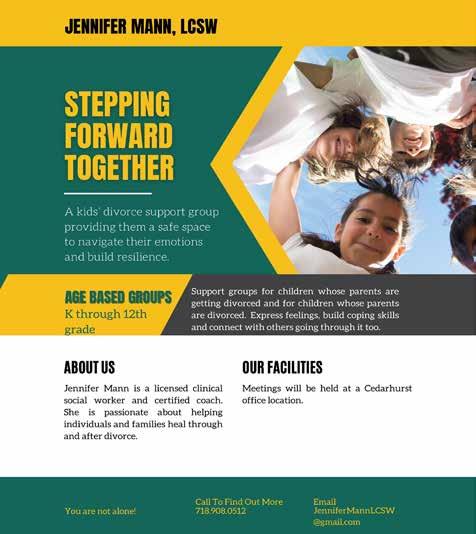
Dear Sarah,
Thank you for your email and for reading the column! I completely understand the concern you have and how this would be affecting you mentally. How nerve-wracking to think about your guy being picky and how this may impact you down the road, at any point.
I don’t know that there is a clear, definitive answer about how to go about handling this. As they say, different strokes for different folks. On the one hand, people’s drive-by comments can often be ridiculous and stir the pot for no reason. And on the other hand, where there’s smoke there’s fire. Life

typically presents us with two conflicting truths, and when it does, how do we make a decision about what to do?
One thing I will say, regardless of your decision, is that all relationships come with the risk of getting hurt. I can also say that very often people are labeled “picky” because they haven’t met the right one. Isn’t everyone “picky” until they do, to a certain extent? Another truth is that if he does have a pickiness issue, it will reveal itself at some point and you will have to have confidence about who you are and your value in order to stay in this relationship (and any relationship for that matter, and I hope your confidence is high). When we work on owning our own value and worth, we shift mindsets from “does he like me?” to “is this a relationship I feel safe in? And I’m going to pay attention to how I feel because that is of utmost importance when I choose my life partner.”
I am of the school of thought that if something is causing anxiety, mental anguish and getting in the way of your mental health and ultimately the relationship, it is always best to be honest and communicate. Whatever comes out of the conversation will be better than being left in the dark riddled with anxiety. Should you decide to speak with him, approach the situation with vulnerability and a pinch of humility, expressing your genuine embarrassment and discomfort in bringing this to his attention. If he dumps you for bringing this up, then good riddance. If he is defensive, that is not good either. Look out for how he tends to your feelings around this. Look for sensitivity and kindness and gratitude for you having shared.
Marriage is a lifetime of sharing feelings and worries, and you want a partner who is going to be there for
You are not the first nor the last person to be on the receiving end of these types of messages from neighborhood yentas.
you through it all and who can remain present, committed and non-defensive. Here is a sample script for the conversation:
“Can we talk? There’s something that’s been on my mind, and I don’t want to keep things from you. A few people mentioned to me that in the past you’ve been kind of picky with dating. I’m not saying I believe them, but I didn’t know what to do with this. I wanted to share this with you because I don’t want any secrets between us, and it also is making me feel a little uneasy. It would put my mind at ease if you could share a bit about why past relationships haven’t worked out because I’d like to hear it from you and not others. And also, if we could talk about how we are both feeling about this relationship.”
If he was “picky” in his past but he is into you, you’re going to have to decide if you are going to put your trust and faith in his feelings for you. And if he wasn’t, you’re going to have to decide if you believe him.
Sincerely, Jennifer
Jennifer Mann, LCSW is a licensed psychotherapist and certified trauma healing life coach, as well as a dating and relationship coach working with individuals, couples, and families in private practice at 123 Maple Avenue in Cedarhurst, NY. To set up a consultation or to ask questions, please call 718-908-0512. Visit www.thenavidaters.com for more information. If you would like to submit a dating or relationship question to the panel anonymously, please email JenniferMannLCSW@gmail.com. You can follow The Navidaters on FB and Instagram for dating and relationship advice.

By Sara Rayvych, MSEd
Rosh Hashana is a special time for reflection. Another year has passed, and a new one is about to begin. Many emotions emerge as we look back, remembering the different experiences we had over the past year. I know I’m not the only one who feels this Rosh Hashana is different from others. We’ve had a very difficult year – one we never could have envisioned. Our tefil-
los this year will be especially intense. There is so much beauty in the Jewish calendar, with each month bringing its own “flavor.” This is a time to evaluate where we are and where we’d like to be. As parents, we can also take stock of our parenting, creating goals for ourselves.
The day-to-day life of a parent can be overwhelming, with adults barely


finding time to sleep or eat. It’s certainly understandable that spending time evaluating our parenting methods may feel like a luxury. It’s important to periodically take that time and give real thought to what changes we’d like to make. We’re always meant to be growing, and only by putting real thought and intention into our parenting, can we hope to continue on that positive path. Rosh Hashana is the perfect time for this extra cheshbon hanefesh.
Evaluating our parenting methods is a very powerful tool towards improvement. It gives us a chance to think deeply about how we are parenting and if our current methods are meeting our child’s needs. As our children grow and develop, their needs are continuously changing. They also go through phases that may temporarily require a different approach.
In many ways, the changes we make to our parenting can be the catalyst for improving our overall middos. Learning patience with a toddler will bring patience into the rest of our life. Speaking with a gentle tone will be applied towards others. Thinking before we act will improve all our interactions.
The role of a parent begins automatically once that baby is placed in your arms. A lot of what we do is based on instincts, our own experiences growing up, and basic survival. Parenting is
wonderful but incredibly difficult without breaks. While it’s beautiful that each child is unique, it also means there is no guidebook for each child! It’s easy to fall into habits that may or may not be the best option. Perhaps what worked in the past isn’t effective now, yet we haven’t changed our techniques to match the child’s current needs. Parenting by rote is not the most successful long-term parenting model.
There is also a tendency for positive behaviors to slip away without a conscious effort towards maintenance. The parent who speaks lovingly may start to raise their voice without realizing. After making an effort to maintain eye contact during conversations, a parent may regress into looking at their phone or other places. We see this in most areas of life, and we require constant, personal vigilance to ensure we’re on the growing path.
There is also a strong tendency to parent by reacting reflexively to the child’s behavior or the circumstances around us. While this is logical and an important part of the job, parenting proactively is even more effective. A proactive parent anticipates situations that may arise and already has a gameplan in place to address the issue. A proactive parent can often prevent negative situations from occurring – it’s easier to prevent a problem than to try fixing it afterwards.
Choose something to improve and
make that your goal for the upcoming year. It doesn’t need to be dramatic, and we’re more likely to maintain a smaller, more realistic goal.
The Yomim Noraim are such a special time, but this beautiful z’man comes with a number of challenges for parents. Parents of young children are unable to spend hours in shul listening to the soul-stirring tefillos, even just hearing 30 shofar sounds can seem insurmountable. Preparing so many meals to feed the crew can be overwhelming and stressful. We want to focus on the meaning of the day, but the kids are fighting over a toy. Rosh Hashana looks very different with kids.
Becoming a parent comes with many changes, including a shift in our yom tov experience. It’s a difficult mental shift, but we can adjust our expectations to better match the reality. It can be painful for many parents to not daven in shul – especially on Rosh Hashana and Yom Kippur. Perhaps there are pangs of guilt, or simply the pain of being unable to feel the depth of the yom tov. Raising children is a holy avodah.
We are currently building the future of Klal Yisroel. It may be difficult to connect the screaming toddler of today to the great person they can become, but the potential is there. Daven what you can and try to take a few minutes of (non-existent) quiet to reflect on the kedusha of the day, but also try to feel the chashivus in the seemingly mundane tasks that come along with childrearing.
The shofar is an important and meaningful part of Rosh Hashana. In addition to being the mitzvah of the day, it sets the tone and directs our feelings. Many felt a little pained last year without shofar on the first day of Rosh Hashana.
With shofar being so prominent, it’s natural that everyone wants to be present – including mothers of young children who usually can’t attend shul. There are a number of options to ensure everyone hears shofar without disturbing the kehilla. I’m not a rav and parents should ask their own shailos regarding which of the following suggestions are halachically appropriate for their family. It’s wonderful if young children can be present and hear shofar, too. As lit-
tle ones have limited ability to remain quiet, they should be brought in just before shofar blowing. Let them get their energy out first and walk in just for the big event. It’s tempting to want to daven with the kehilla before, but for many children, if they’re present during the earlier tefillos, then they’ve already fulfilled their quiet quota and will get cranky during the actual kolos.
Come prepared with whatever your child will need for comfort. Babies may need their pacifier or special blankie. Slightly older children may benefit from having a (non-messy) snack or drink. This is the one time of year I suggest lollipops, drinks with straws, or other treats that require sucking to keep their mouth occupied. Please remove any trash or items you’ve brought with you. In addition to being basic derech eretz, our children are never too young to see the kavod we give a makom tefillah.
Littles ones are calmer when they’re held – keep an infant or toddler close and in your arms. Slightly older children may benefit from holding their adult’s hand.
It’s unfair to the rest of the kehilla when a child runs around or screams
throughout shofar blowing. Depending on shofar blowing times, mothers can take turns watching each other’s little ones at home, while the other attends shul. Alternatively, mom can go to shofar blowing after Tatty comes home.
There are times when parents absolutely cannot get to shul. It requires advanced planning, but there are many individuals who can blow shofar and are happy to do so. One year, my little one was throwing up, and I didn’t feel comfortable bringing him to shul to infect others. We were very fortunate to have a neighbor who thoughtfully blew shofar for us and came to the rescue.
I want to wish our readers and all of Klal Yisroel a year full of bracha, shalom, good health and nachas from their children. Shana tova!
Sara Rayvych, MSEd, has her master’s in general and special education. She has been homeschooling for over 10 years in Far Rockaway. She can be contacted at RayvychHomeschool@gmail.com.

Dear Readers,


I get a lot of letters, thanks to all of you who read and respond to this column. A few weeks ago, I received a letter that shook me to the core.
I feel it is appropriate to share it now, as Rosh Hashana is a time of cheshbon hanefesh, a time we take an accounting of our soul, our hearts, and minds, and of course, our actions.
Certain details have been omitted to protect the privacy of the writer.
Hi Morah,
It’s been quite a number of years since the last time I’ve seen you.
Well over 25 Years.
And I wonder if you remember me.
But then again, how can you forget?
How many girls end up in your 3rd grade class and (obvious abuse, details omitted) for no apparent reason by their mother?!
I think it takes a real special someone to have a student like that be a part of their class and to want to make a difference.
You spoke up and advocated for me. And when you realized it wasn’t getting you far, you wouldn’t always send me home. You’d take me to your after-school programs on Tuesday or Wednesdays, I believe.
By Etti Siegel
You’d tell me that I’d be your helper. And you’d show me pictures of your children and shared stories with me about your family. I believe this was your way of keeping me out of my house, out of my mother’s abusive hands.
My mother was a single mom to a lot of children. Her life wasn’t easy, and it would take years before I realized that it was also no excuse for the way she treated me.
I’ve since then graduated from high school, went to seminary in Israel, gotten married to the wrong person, and had a son and daughter.
I so badly wanted to do right by my children, and it helped to have had certain mentors and people in my life that had invested so much in me and I couldn’t shake off the feeling or allow it to go to waste.
I left my ex-husband with a toddler who had yet to be diagnosed with autism while I was 3 months pregnant with my second child.
I raised them alone, with no college degree, no help from parents, no help from my kids’ father, and pretty much a negative in my account.
Here she writes about her difficult time going through college and getting a degree, juggling her children, and a low-paying job that helped her pay the bills. She writes how she met a man who actually seemed healthy and was on his own journey from a troubled background. To protect her privacy, I left out this detailed section.
Two months ago, we got engaged.
I’m not sure what I had done in my past life to deserve a man like him. But no matter how hard the last year has been, he stands by my side, insists on taking care of my kids and literally worships the ground I walk on. I am a real queen in his eyes, and every day that we are together he peels off layers from my past.
It has also allowed me to reconnect to the best parts of my past and to get in touch with you.
Thank you for being you and for being there for me during that time. It truly means the world to me and I owe you a piece of my happiness for not stopping to fight for me during my third grade year.
Thank You. Thank you!!
We don’t realize the impact of our actions on others. As a teacher, I always tried to care for my students. Who knew that my one year with this student would be something she held onto for so many years?
It makes me wonder how many other children I impacted…and if any students from my past were inadvertently hurt by anything I had done.
What a humbling experience and a reminder of the responsibility we have to do our best with every student who enters our world.
Kesiva v’chasima tova.
- Etti
Mrs. Etti Siegel holds an MS in Teaching and Learning/Educational Leadership and brings sound teaching advice to her audiences culled from her over 35 years of teaching and administrative experience. She is an Adjunct at the College of Mount Saint Vincent/Sara Shenirer. She is a coach and educational consultant for Catapult Learning, is a sought-after mentor and workshop presenter around the country, and a popular presenter for Sayan (a teacher-mentoring program), Hidden Sparks, and the Consortium of Jewish Day Schools. She is a frequent contributor to Hamechanech Magazine and The Journal for Jewish Day School leaders. She will be answering your education-based questions and writing articles weekly for The Jewish Home. Mrs. Siegel can be reached at ettisiegel@gmail.com.


By Aliza Beer MS, RD, CDN

Rosh Hashana is an exciting and beautiful holiday. It ushers in cooler temperatures, increased optimism, and extravagant meals. This year is especially challenging given the 3-day yom tov set-up, even for those celebrating in Israel. Let’s be clear: the goal is not to lose weight, but to maintain, or at the very least, minimize the gain. We must balance adhering to our health goals, while partaking in the special foods and delicacies belonging to this holiday. Follow my tried and true strategies, and you will commence the new year with a strong and healthy start.
• Flavorful Fish: There are six yom tov/Shabbos meals. It is exceptionally unhealthy and highly caloric to consume six heavy meat meals in a row. Incorporate fish into 1-2 meals and make that your primary protein. If one dislikes all fish, then eat a few chicken/turkey meals to help balance out the red meat.
• Avoid the Appetizers: Eating an appetizer and main at every meal for six meals in a row is simply too much food! Try to avoid the appetizers or stick to healthier/less caloric options like salads and broth-based soups.
• Cancel the Challah?: The challah bakers out there know that challah is just like cake. Consuming a thick slice
(or two) of challah at six meals in a row is a recipe for disaster. Consider eating a healthier carb like matzah or sourdough at least half the meals.
• Breakfast of Champions: For those who are able to eat breakfast, please do so; it would be helpful to get some protein in such as yogurt or cottage cheese or eggs before heading off to shul. Davening is usually long, and lunch is late. Eating a breakfast, or in some cases, bringing a snack to those shuls that offer a break, will prevent you from coming to lunch ravenous which easily leads to overeating.
• Skinny Sides: If you are washing on some kind of bread at every meal, make the bulk of your side dishes lower carb, such as a wide variety of vegetables and salads. You may also include healthy high-fiber starchy sides such as sweet potatoes, butternut squash, kabocha squash, and quinoa.
• Hold on Honey: Yes, honey is a unprocessed and healthier form of sugar, but it is still high in sugar and calories. By all means, dip your apple in the honey, but refrain from slathering it on everything and anything.
• Water Really Does Work: Maintain good hydration by drinking at least eight cups of water a day. Avoid diet beverages and sugary juices and sodas.
Change up your beverage selection with flavored seltzers or unsweetened iced teas. Water will help fill you up and facilitate in GI motility. Drink with your meals, alternating between bites of food and sips of water; this will help slow down the meal and ultimately contribute to increased satiety.
• Walk This Way: Too much time is spent sitting in shul and around the table. Exercise is needed for one’s physical and mental well-being and will help offset the increased caloric intake at these numerous and large meals. Weather permitting, aim to walk at least 20 -30 minutes each day.
• Moderation not Deprivation: I am a big believer in partaking of mindful indulgences. However, you need to find a balance: select your favorite unhealthy high-calorie food at the meal and take a small portion of it. Fill up your plate with mostly healthy foods, and don’t take seconds unless you are truly hungry. If one meal ends up being very off-track, make the next meal a great one.
• Timing is Everything: Desperate for that honey cookie or sliver of babka? If you are definitely going to treat yourself, do it early in the day, never late at night. The best time is at breakfast, and the latest is at lunch. Never treat yourself after
dinner because whatever we are eating at night is quite literally sticking to us. The body has the ability to try and burn off at least some of the food we consume earlier in the day. Food eaten later on at night won’t have the same opportunity to be metabolized or utilized efficiently.
Rosh Hashana is indeed a wonderful chag that encompasses both physical and spiritual feasts. Enjoy the fantastic food, but don’t lose focus on family, friends, and personal growth. If done mindfully, you can have your cake and eat it, too! Maintain good hydration and physical activity. Exercise appropriate portion control and pay attention to hunger cues. Remember, this is only the beginning; we have many more chagim in our near future and it’s imperative to pace ourselves. With the right preparation and a little bit of discipline, you will enjoy your yom tov without abandoning your health goals.
Wishing all of my readers a kesiva v’chasima tova and a shana tova!
Aliza Beer is a registered dietitian with a master’s degree in nutrition. She has a private practice in Cedarhurst, NY. Patients’ success has been featured on the Dr. Oz show. Aliza can be reached at alizabeer@gmail.com, and you can follow her on Instagram at @alizabeer


By Naomi Nachman
This dish has many simanim in the recipe, making it great for your Tishrei menus. It is a delicious appetizer or main dish any Friday night. You can omit the pinenuts if it is your minhag not to eat them on Rosh Hashana. I am planning to add this to my Sukkot menu; the bright colors of the garnish will really enhance our sukkah.
◦ 24 large, pitted dates, preferably medjool
◦ 1 pound ground lamb
Lamb Mixture
◦ 1 small shallot, finally minced
◦ 2 cloves garlic minced
◦ 2 tablespoons chopped parsley
◦ ½ teaspoon cumin
◦ ½ teaspoon allspice
◦ ¼ teaspoon cinnamon
◦ 1 teaspoon kosher salt
◦ 1⁄8 teaspoon pepper
◦ 2 tablespoons pine nuts
Sauce
◦ 1/3 cup pomegranate molasses
◦ 2 tablespoons extra-virgin olive oil
Naomi Nachman, the owner of The Aussie Gourmet, caters
and
and

◦ 1 tablespoon silan
◦ 1 tablespoon tomato paste
◦ 1 teaspoon kosher salt
◦ Crushed black pepper
◦ 1 cup water
◦ 1 cup red wine
Mix the ground lamb with all the ingredients for the lamb mixture. Gently fill the dates with the meat mixture. Set aside.
In a large, wide saucepan, add sauce ingredients on a medium-low heat until ingredients are dissolved. Add in the stuffed dates to the sauce and simmer on low, covered, for 30 minutes to an hour, basting halfway through.
Garnish with pomegranates and fresh parsley before serving.
If you have leftover lamb, you can roll it into balls and cook them alongside the dates.
Yom
for families and individuals within The Five Towns and neighboring communities, with a
cooking presentations for organizations and private groups throughout the New York/New Jersey Metropolitan area. In addition, Naomi has been a guest host on the QVC TV network and has been featured in cookbooks, magazines as well as other media covering topics related to cuisine preparation and personal chefs. To obtain additional recipes, join The Aussie Gourmet on Facebook or visit Naomi’s blog. Naomi can be reached through her website, www.theaussiegourmet.com or at (516) 295-9669.

This column features business insights from a recent “Mind Your Business with Yitzchok Saftlas” radio show. The weekly “Mind Your Business” show – broadcasting since 2015 –features interviews with Fortune 500 executives, business leaders and marketing gurus. Prominent guests include John Sculley, former CEO of Apple and Pepsi; Dick Schulze, founder and Chairman Emeritus of Best Buy; and Beth Comstock, former Vice Chair of GE; among over 400+ senior-level executives and business celebrities. Yitzchok Saftlas, president of Bottom Line Marketing Group, hosts the weekly “Mind Your Business” show, which airs at 10pm every
1. Simcha Trieger, President of The Vendors
If I had to share one lesson that I have learned keeping offices stocked it would be, “eat well, work better.”
2. Isaac L. Muller, President & CEO of Highview
Never give up. It took me about 6-7 years to build my business from the ground up. It was hard. It went back and forth so many times. The only thing that never came to mind was that maybe it was time to give up.
3. Darin Adams, Growth Advisor & Professional Event Speaker at Keap
When someone reaches out to you, you have two minutes to respond to them. After two minutes, the efficacy of your message starts deteriorating rapidly. The faster you can respond, the stronger your message will be.
4. Moshe Farber, Fractional CMO at C Level Accelerator
Measuring the effectiveness of a marketing plan isn’t just about metrics. It’s about understanding the impact of business goals. So, it’s not just about metrics, but you really need to understand exactly what your overall vision is.
5. Isaac Joseph, Sales Executive at CallMax
When you find a client, close the account, and everything is running, constantly follow up with them. You never know what hiccups might be happening that they’re not reaching out about because they feel uncomfortable.
Sunday night on 710 WOR and throughout America on the iHeartRadio Network.
Since 2015, Yitzchok Saftlas has been speaking with leading industry experts on the “Mind Your Business” show, sharing insightful business and marketing strategies.
On a recent edition of “Mind Your Business,” Yitzchok Saftlas hit the floor at NBX 2024 to talk to entrepreneurs, executives, and business leaders across many industries, gathering their top business tips.

6. Dovy Walter, CEO of Blitz
Whenever you’re talking to a client or working on a sale, put yourself in the client’s shoes. Ask yourself, “What problem can I solve for them and how?”
7. Sol Horowitz, Business Coach at Rock Leadership Solutions
Personally, I dislike tips. For me, tips have a very short shelf life, but books stay with you a lot longer. However, that is my personal choice. Find the learning style that works for you.
8. William C. Buzzini, Associate at R3M Law LLP
If you’re getting an attorney, make sure that the attorney really specializes in the area that you’re looking to have them service you.
9. Moshe Heller, CEO & Founder of Anyway Pay
A lot of people have great ideas, but not a lot of people go after them. Go after it. The worst thing that could happen is that you fail, and that’s not really failure. You learn from it, and you start over again.
10. Refoel Langsam, Photography Professional at Langsam Photography
Pay attention to detail. If a client has a question, answer the question. Clients want to know that you’re there for them. They’re going to do more business with you, because you’re building that connection.
11. Tani Shechter, President of Armlabz Don’t stop. My business didn’t start where it is now. My website and a product wouldn’t be here if I gave up along the way.
12. David Genger, Co-Founder of Devx Staffing
Utilize technology. Think about how you can automate your business. Think about how you can implement better processes and different solutions. Go all in on technology. That’s your edge.
13. Menashe Friedman, CEO & Founder of M Friedman Consulting
If you’re a sales director looking for the right people, look for three things: 1) Are they coachable? 2) Do they have determination? 3) Are they willing to do the work that they need to do? Somebody with those three traits is a winner.
14. Shaina Keren, Noted Career Consultant at SK Career Consulting
I think that people fight their personalities. People who are quiet think, “I should really get out there more.” But you don’t need to fight yourself. Every single person has so many God-given natural gifts that they can tap into.
15. Chaim Shapiro, Executive Director of Undergraduate Career Services at Touro University
If you have your own business, create a LinkedIn business page. When you have a blank page listed as your place of work, it doesn’t look good. Just create it, put in your logo, and some basic information. It makes a big difference.
16. Shimon Kolyakov, Co-Founder & CEO of TorahAnytime
You have to be tremendously passionate about whatever you do. Don’t go into a certain industry just because you think you’ll make money in it. Find a problem that people have, get a solution, and market it.
17. Mordechai Elfassy, Swift Staffing
My father once told me, “If it can help people and do good, that’s always a good thing.” So, always try to look for a business opportunity where you’re helping people.
18. Aryeh Morrison, Custom by Artscroll
When you give something to people that they can keep and appreciate, not just a candy platter or something disposable, they’ll keep it on the shelf. They’ll always remember you, and so they’ll keep coming back to you for more business.
19. Nathan Weiss, President & CEO of Onit
Whenever you have to make a big decision or investment, don’t act before talking to the right people. Gather

some ideas and options out there. You don’t want to be stuck with a bad decision later on.
20. Mechy Czin, Sales Rep at Pledger Charitable
The best tip I ever heard when it comes to sales is that you should always be nice to people and make them feel good. Hear their needs and make sure you can make them happy.
21. Yankie Markowitz, CEO of SBA Loan Group
One thing that businesses struggle with is keeping up with their financials. At least once a quarter, go through what you’ve done and ask, “What are am I doing? Where am I holding? How do I get to the next level? What have I done until now that hasn’t worked out?”
22. Naftali Schabes, Owner of Naftali Status
People always say, “Oh, advertising is not in my budget.” If you’re starting a business and an advertising budget (even just $5,000 annually) is not implemented in your first-year profile, don’t even start.
23. Eliezer Blatt, Presentation Skills Expert & Founder of Eli Blatt Speaker Training
When you’re speaking to someone, look them in the eye and focus on them. Don’t do “shoulder surfing,” where you’re looking to see if there’s someone else to speak with. Look right at the person and focus on them. They feel that.
24. Avi Pruzansky, President of Unicom Telecom
Every “no” that I get doesn’t bother me even a bit, because it just brings me that much closer to getting a “yes.” Every day, I wake up optimistic, no matter what happened the day before.
25. Esther Adamson, CEO & Founder of Summit Social
People are really missing out on cold messaging campaigns on LinkedIn. LinkedIn is literally a business platform, and it’s okay to pitch your business. If you create a good message that’s quick to the point, easy to answer, and not annoying, you can have a lot of success.
26. Shlomo Zeide, Co-Founder of Print It
When it comes to printing, many people wait until they have every single item they need (folders, brochures, envelopes, etc.) before sending it over to the printer. But some items take more time than others. As soon as any item is ready, send it, and check it off your list.
27. Shmily Weinberger, Photographer at Weinbergers Photography Inc
Invest in your photos, and you will see the profit in sales. Sometimes people try to get away with something cheaper, and then prospective customers don’t see their true value.
28. Chaim Geller, CEO & Founder of Help Me Build Credit
In today’s world, everyone needs to have credit. Any loan or credit card you want to apply for to help your business will require good credit. Always remember to keep your credit in good standing.
29. Isaac Gross, CEO of IG PPC
Just be honest. I turn away a lot of businesses if I feel that I cannot add value. So, be honest. You might lose in the short term, but you’ll build your reputation in the long term.

Exchange between President Biden and a reporter:
REPORTER: Any comment on the strikes in Yemen, Mr. President?
BIDEN: I’ve spoken to both sides. They gotta settle the strike. I’m supporting the collective bargaining effort. I think they’ll settle the strike.
We need to guard that spirit. We have to guard that spirit. Let it always inspire us. Let it always be the source of our optimism, which is that spirit that is uniquely American. Let that then inspire us by helping us to be inspired to solve the problems that so many face, including our small business owners.
- Kamala Harris speaking at the Economic Club of Pittsburgh
We just need to move past the failed policies that we have proven don’t work. And like generations before us, let us be inspired by what is possible.
- ibid., seeming to forget that she has been in office for the past four years
Some of the work is going to be through what we do in terms of giving benefits and assistance to state and local governments around transit dollars and looking holistically at the connection between that and housing and looking holistically at the incentives we in the federal government can create for local and state governments to actually engage in planning in [a] holistic manner that includes prioritizing affordable housing for working people.
- Kamala Harris, in an interview with MSNBC’s Stephanie Ruhle
One can watch that and say, “She didn’t give a clear and direct answer.” That’s okay because we are not talking about clear and direct issues.
– Stephanie Ruhle, after the interview
Is it just me…I feel like someone just “roofied” ChatGPT.
- Greg Gutfeld, commenting on Harris’s interview
Surely Cheney, the IRS, Putin and Iran endorsing Kamala can’t all be wrong!
- Elon Musk on X, after the IRS union endorsed Kamala Harris
I have spent countless hours studying Hezbollah, and there is not an expert on earth who thought that what Israel has done to decapitate and degrade them was possible.
- Jared Kushner on X
Anyone who has been calling for a ceasefire in the North is wrong. There is no going back for Israel. They cannot afford now to not finish the job and completely dismantle the arsenal that has been aimed at them. They will never get another chance.
- ibid.
After the brilliant, rapid-fire tactical successes of the pagers, radios, and targeting of leadership, Hezbollah’s massive weapon cache is unguarded and unmanned. Most of Hezbollah fighters are hiding in their tunnels. Anyone still around was not important enough to carry a pager or be invited to a leadership meeting. Iran is reeling, as well, insecure and unsure how deeply its own intelligence has been penetrated. Failing to take full advantage of this opportunity to neutralize the threat is irresponsible.
- ibid.


Who [in the world] is Zelensky to be trying to interfere in our election? The arrogance of this guy… And the guy, I’ve got to say, is an absolute moron for coming to the U.S. six weeks before the election and attacking Trump and Vance.
- Sen. Ted Cruz (R-TX) commenting on Ukrainian Pres. Vladimir Zelensky disparaging JD Vance and then visiting an ammunition plant in with Governor Josh Shapiro (D), Senator Bob Casey (D-PA), and Congressman Matt Cartwright (D-PA)
I don’t care if Zelensky likes or dislikes what they have to say. If he had the sense G-d gave a cricket, he would have said, “I’m not going to comment about U.S. elections, that’s for the people of America to decide.” - ibid.
This is just dumb on his part, because if Trump wins, he’s got a huge problem that just got bigger. And if Trump loses, you know, good luck trying to get Republicans to listen to what he has to say if he just behaves like a Democrat campaign activist. - ibid.
All Biden does is sleep on the beach. How do you sleep on the beach when you have cameras on? I promise to never sleep on the beach with the cameras on!
- Donald Trump at campaign rally
I watched, about a year ago, when he talked about how the illegal migrants are hurting our city, and the federal government should pay us, and we shouldn’t have to take them. And I said, you know what? He’ll be indicted within a year. And I was exactly right, because that’s what we have… These are dirty players. These are bad people. They cheat, and they do anything necessary.
– Donald Trump commenting on Mayor Adams being indicted by the Justice Department

Hezbollah is winning.
- Tweet by Iranian supreme leader, Ali Khamenei
We are happy to book you in for an eye test. We are a public hospital and open to everyone.
- Assuta Public Hospital of Ashdod responding in Persian
Mr. Nasrallah was opposed to Israel, which he called “the Zionist entity,” and maintained that there should be one Palestine with equality for Muslims, Jews and Christians.
- The New York Times writing about terrorist mastermind Nasrallah, who was responsible for numerous horrific terrorist attack against Israel and around the world, including killing 220 marines in a bombing on U.S. barracks in 1983 and bombing a Jewish center in Buenos Aires in 1994 which killed 85 people
Earlier today, Israeli Prime Minister Benjamin Netanyahu addressed the U.N. General Assembly. To make sure that the pro-Hamas protestors wouldn’t show up late, he offered to page them first.
– Greg Gutfeld
I truly believe that Biden’s legacy will be etched in the history books as Washington.
- The View’s Sonny Hostin equating Joe Biden with George Washington
The same always happens with the ideas of the left. They design a model according to what human beings should do, and when things turn out differently, they repress, restrict and curtail their freedom.
- Argentina’s President Javier Milei addressing the U.N.
In this very house, we have systematically voted against the State of Israel, which is the only country in the Middle East that defends liberal democracy, while simultaneously demonstrating a total inability to respond to the scourge of terrorism.
- ibid.
Joe Biden referred to JD Vance as a secretary at an event yesterday. Even more absurd, he referred to his wife as a doctor.
– Greg Gutfeld
Mark Zuckerberg unveiled new holographic smart glasses this week. The glasses will allow users to translate words spoken in foreign countries. So you can hear “what a [total] dork” in 24 countries!
- ibid.
California’s plastic bag ban is now in effect, prompting Nancy Pelosi to go into hiding.
– ibid.


Fearing For Her Safety, Kamala Will Only Appear in Public Behind Soundproof Glass Until Election Day
- ibid.
Media Warns Florida Hurricane May Hamper Ongoing Trump Assassination Attempts
- ibid.
Exploding Restaurant Buzzer Takes Out Hezbollah Party of 6 - ibid.
Eric Adams Declares New York a Sanctuary City For Mayors Facing Federal Criminal Charges
- ibid.
New Poll Shows Kamala With Huge Lead Among Deranged Assassin Demographic
- ibid.
Experts Warn Hurricane in Hurricane Alley During Hurricane Season Clear Sign of Climate Change
- ibid.
Eric Adams has now been indicted. He should probably go stab someone at a New York subway station so the prosecutors release him quickly.
– Tweet by Ben Shapiro
There really is nothing like [the UN General Assembly]. If you can’t get down a couple of blocks on foot, you can at least console yourself that some African despot is holed up in his 5-star hotel.
- Douglas Murray, New York Post
Hamas has strong support at liberal elite colleges and the youth wing of the Dems. As the older Dems retire or pass away, the Democratic Party will become officially antisemitic.
- Elon Musk on X

Let’s extinguish him for good.
- Joe Biden’s Secretary of Commerce Gina Raimondo on MSNBC talking about Trump


By Bret Stephens
In 2006, Hezbollah launched a guerrilla raid into Israel. It led to a 34day war that devastated Lebanon, traumatized Israel, and concluded with a U.N. resolution that was supposed to disarm the terrorist militia and keep its forces far from the border.
The resolution did neither.
Instead, a combination of international wishful thinking and the willfulness of Hezbollah’s patrons in Iran have brought us to where we are now — the cusp of a conflict that could dwarf the scale of fighting in the Gaza Strip. Can a full-blown war be avoided? Hard to say. Can the lessons of 2006 lead to a better outcome this time? That’s the important question.
First lesson: Tactical brilliance is not a substitute for sound strategy. In 2006, the Israeli air force, operating on excellent intelligence, was able to knock out many of Hezbollah’s longer-range rockets — often hidden in homes — by the second night of the war. The strike surely helped spare scores, if not hundreds, of Israeli lives.
But Israel had little idea of how to fight the war after that, other than through a bombing campaign whose ferocity generated acute diplomatic pressure for the war to end, along with a belated Israeli ground incursion that got badly mauled by Hezbollah. Does Israel have a better plan today?
Second lesson: Hezbollah is not Israel’s main enemy. Iran is. Or, to borrow a metaphor from former Israeli Prime Minister Naftali Bennett, Tehran, Iran’s capital, is the head of the octopus, and Hezbollah — like Hamas in Gaza or the Houthis in Yemen — is merely one of its tentacles. By going to war with Hezbollah, Israel risks exhausting itself in a secondary fight.
That doesn’t mean that Israel can afford to ignore Hezbollah; its arsenal of 120,000 to 200,000 missiles and rockets poses a dire and direct threat to the Israeli home front. But the only way in which Israel restores its deterrence is by imposing costs directly on Hezbollah’s

masters. Tehran, not Beirut, is the real center of gravity in this fight.
Third lesson: Do not make an enemy of the Lebanese people.
Except in its Shiite strongholds, polling by the Arab Barometer shows, Hezbollah is unpopular among most Lebanese. With good reason: The group has hijacked their country, murdered their most beloved leaders, turned much of
it should not repeat the 2006 mistake of trying to create deterrence through demonstrations of brute force. The kind of targeted strikes demonstrated by last week’s pager attacks are vastly more effective in erasing Hezbollah’s aura of invincibility.
Fourth lesson: Keep the U.N. out of it. In theory, the Security Council’s Resolution 1701, which ended the 2006 war,
Tehran, Iran’s capital, is the head of the octopus, and Hezbollah — like Hamas in Gaza or the Houthis in Yemen — is merely one of its tentacles.
the country into a target, and devoted its resources to building a vast military infrastructure even as the national economy has collapsed.
Israel can’t hope to turn Lebanon into any kind of ally — that fantasy died with the Syrian-backed assassination of Bashir Gemayel, Lebanon’s Israel-aligned president-elect, in 1982. But
empowered a U.N. peacekeeping force to prevent Hezbollah from placing its forces close to the Israeli border. In reality, the U.N. peacekeepers did nothing of the sort, at a cost of billions to U.S. taxpayers.
If the United States or Europeans want to create a buffer area between Israel and Hezbollah, they should deploy their own troops under a NATO flag or
perhaps invite Arab states to send forces. Otherwise, the reestablishment of the Israeli-controlled security zone in southern Lebanon that existed from 1985 to 2000 might, for all the long-term problems it presents, be the least-bad alternative.
Fifth lesson: The proper role for the United States in the crisis is not to seek a diplomatic solution. It’s to help Israel win.
Until al-Qaeda’s attacks Sept. 11, 2001, no terrorist group had murdered more Americans than Hezbollah. Israel’s strike last week in Beirut, which killed Hezbollah commander Ibrahim Akil, avenged the 1983 attacks there on the U.S. Embassy and Marine barracks, in which 258 Americans perished. Hezbollah later went on to murder and starve untold numbers of Syrians by helping Bashar Assad in the bloody suppression of his own people.
Those crimes should neither be forgotten nor forgiven. Nor can it be in the interests of the West for a terrorist group with burgeoning ties to the Kremlin to maintain effective control of a Mediterranean state while it terrorizes its neighborhood. Beyond Israel’s interests in secure borders against Tehran’s Axis of Resistance, there is an American interest in checking the expansion of what I call the Axis of Repression, a broader group that includes Iran, China, Russia and North Korea.
Which brings us to a sixth lesson: It’s tempting to view Israel’s various battles as regional affairs, distant from America’s central concerns. It’s also foolish. We are now in the opening stages of yet another contest between the free and unfree worlds. It’s a conflict that reaches from Norway’s border with Russia to the struggle of the Iranian people against their own government to the shoals of the South China Sea. It will probably last for decades.
In that fight, Israel is on our side, and Hezbollah is on the other. Whatever happens in the days and weeks ahead, we can’t pretend to be neutral between them.

Hasan Nasrallah wanted to live and die as a fighter, and he got his wish Friday, when Israeli bombs pulverized his underground lair in Beirut. Hezbollah will surely seek to avenge Nasrallah’s death, but he was the rare leader who was close to irreplaceable.
I met Nasrallah in October 2003 in a fortified bunker in the southern suburbs of Beirut, not far from where he died. For a man who ordered the deaths of so many Israelis and Lebanese, he was surprisingly soft-spoken. He was a charmer, not a shouter; his legitimacy came from his clerical study in Najaf, Iraq, and his riveting sermons, televised during Muharram and other religious holidays.
In a Lebanon where political leaders usually live the soft life, even as they plunder the people, Nasrallah was different. He told me proudly that his own son Hadi had died fighting Israel in 1997. “We didn’t send our children to London or Paris to university but to fight alongside other Lebanese,” he said.
Nasrallah was also unyielding. That’s why he was an inevitable Israeli target. He ordered rocket attacks against Israel starting Oct. 8, the day after Hamas’ barbaric massacre of Israeli civilians. He exercised a measure of restraint, refraining from large-scale attacks on Israeli cities. But he wouldn’t step away from the battle.
And he would never separate Hezbollah’s fate – and Lebanon’s – from the Hamas fighters hidden in Gaza. He had a chance to save himself and his movement, in a peace plan devised by U.S. emissary Amos Hochstein. But that would have required a break with Hamas. Nasrallah wouldn’t do it.
In 2003, I asked Nasrallah if there were any formula for peace that would end the suicide bombings that were then ravaging Israeli civilians. He gave a cold-blooded answer: “I can’t imagine a situation, based on the nature of the Israeli project and the nature of the Israeli leaders, where the Palestinians would agree to lay down arms.”
By David Ignatius

Nasrallah saw no exit, only war between Israel and the “resistance” he claimed to lead. At the time of the 1993 Oslo Accords between Israel and the Palestine Liberation Organization, “there was a philosophical debate” about a peace agreement, he said. But that era was over.
Nasrallah created an extraordinarily powerful movement in Hezbollah. It was so strong and well-disciplined that it was able, over time, to seize power from the Lebanese state. Hezbollah’s operatives looked different than other Lebanese militias. They were leaner, tougher and better organized. You could make them out, occasionally wearing green blazers, when you arrived at the Beirut airport.
Hezbollah embodied the organized power of the Lebanese Shiites, who had once been the dispossessed, the outcasts at Lebanon’s party of self-celebration. They became the largest of Lebanon’s ethnic groups – and gradually the toughest, too.
Hezbollah ministers served in the dysfunctional Lebanese government, and they exercised a veto over who would lead the country as president (a Christian, by Lebanon’s power-sharing formula) and prime
minister (a Sunni Muslim). But Hezbollah’s real power was that it was an alternative government, with its own network of social welfare and security organizations to serve the followers of its self-appointed resistance to Israel.
Animating this state within a state was Nasrallah. Augustus Richard Norton noted in his 2007 book, “Hezbollah,” that as far away as Damascus you could buy key rings, shirts, buttons, bumper stickers and posters bearing Nasrallah’s face.
For all Nasrallah’s charisma, however, many Lebanese grew to hate him and his militia. When patriarchal former prime minister Rafik Hariri was assassinated in February 2005, many of the tens of thousands of Lebanese who poured into the streets blamed Syria and, implicitly, its ally Hezbollah. (A U.N.-backed tribunal in 2020 found a Hezbollah member guilty of the assassination.) The anti-Hezbollah feeling deepened after the 2006 war, when Israel warplanes – retaliating against a Hezbollah cross-border kidnapping operation – destroyed much of Lebanon’s infrastructure.
Even Nasrallah knew he had gone too
far. “We did not think, even one percent, that the capture would lead to a war at this time and of this magnitude. You ask me, if I had known on July 11 … that the operation would lead to such a war, would I do it? I say, no, absolutely not,” he told Lebanon’s New TV station. But despite the 2006 disaster, Nasrallah kept baiting the Israeli tiger.
The war that finally claimed Nasrallah is one that he and movement tragically didn’t want to escape. The fight defined them. Without the mantle of resistance, Hezbollah would lose its rationale for overriding the Lebanese state. Paradoxically, it needed war to survive.
In June 2002, I asked one of Nasrallah’s spiritual mentors, Sheikh Mohammed Hussein Fadlallah, what he would say to innocent Israeli children who had been killed by a suicide bomber. He turned the question back on me, asking what I would tell the victims of Nagasaki.
“Under war, everything happens,” Fadlallah told me. “Because war is war.”
The Shiite have a devotion to martyrs, all the way back to the murder of Ali, the prophet Muhammad’s cousin, in 661, and his son, Hussein, in 680. During the 1970s in Lebanon, that revered martyred imam was Musa al-Sadr, a brilliant cleric who disappeared in Libya in 1978.
When Nasrallah emerged as the Hezbollah leader in 1992, posters displayed his round face under an iconic portrait of Sadr. Fouad Ajami, in a 1987 study al Sadr, “The Vanished Imam,” described a cult of defiance and death: “Young men behind sandbags, with their Imam’s posters, defend the ruins that are theirs and their sect’s.”
Now Nasrallah has joined the long line of Shiite martyrs. He will be mourned by his followers, who will try to avenge him. But his death offers a chance for Lebanese to reclaim their country after nearly 40 years of ruinous Hezbollah leadership.
By Choe Sang-Hun
CHEONGJU, South Korea — When the South Korean spy met with Kim Jong Il, he declined the late North Korean leader’s offer of a toast, citing a promise to his mother that he would never drink.
But the undercover agent, masquerading as a businessperson, vowed to break his abstinence when the two Koreas reunified, until recently an overriding policy goal of the leaders of both countries.
Park Chae-so, the spy, amused Kim when the North Korean dictator gave him a bottle of blueberry wine as a parting gift. He asked for another.
“Mr. Chairman, don’t we Koreans say one is one too few?” he said.
Park’s 1997 meeting with Kim, the father of the current leader, Kim Jong Un, lasted only 35 minutes. But it was a coup for South Korea’s intelligence community: He was its only known undercover agent to penetrate the security cloaking the world’s most secretive regime and finagle an audience with its enigmatic leader.
Until then, Kim was so reclusive that even his own people had heard his voice only once, in 1992, when he shouted one sentence into the microphone while inspecting a military parade: “Glory to the heroic soldiers of the People’s Army.”
But Park was impressed with Kim’s speaking style.
“There was a flow — and not a single repetition,” Park said of his conversation with the supreme leader.
Park’s identity and his meeting with Kim, who ruled North Korea from 1994 to 2011, were exposed in a political scandal in 1998, turning him into a celebrated — but former — spy in the South.
These days, the ex-spy is a cautious but vivid storyteller, and this account is based on his version of events, which have inspired a book about his life and a movie, “The Spy Gone North.” While parts of his story have been corroborated
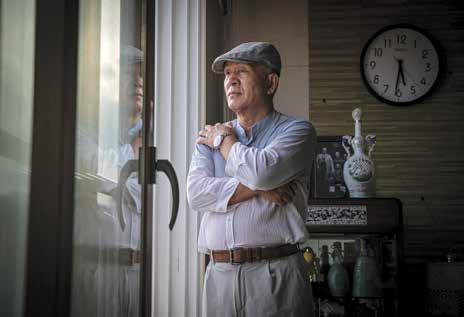
by officials and associates, neither North Korea nor his former spy agency has officially commented on his work.
Park, 70, visited North Korea more than a dozen times, convincing North Korean officials that he could get them badly needed cash, including by helping them sell porcelain and other ancient North Korean artifacts abroad.
He said that whenever he was there, he folded his clothes — and left a couple strands of hair in his bag — in such a way that he would know whether his belongings were searched while he was away from his hotel. When the searching stopped, he knew he had gained the trust of his minders.
A senior North Korean official once put a gun to his head when he refused to cooperate with a plan to have him “marry” a North Korean woman and have a baby in the North, he said during an interview in Cheongju, where he lives, one of a few conversations he had in Cheongju and in Seoul, South Korea, with The New York Times. Park was told that Kim had already named the pro -
spective baby: Tongil, or “Unification.”
“Whenever I visited the North, I knew my life was on the line,” Park said. “When the plane took off from Pyongyang and was up in the air, I could breathe again, relieved that I had survived another trip.”
A son of a farming family in Cheongju, south of Seoul, Park was an army major in 1990 when he was recruited by the Defense Intelligence Command. He began creating a new reputation as part of a carefully choreographed plan to eventually have him infiltrate North Korea. He borrowed money, squandering it in real estate deals gone wrong, and often got into trouble with superiors. He added a few criminal records to his file.
Three years later, in 1993, he was tapped by the country’s top intelligence service, the Agency for National Security Planning, just as North Korea’s clandestine nuclear program had turned into an international crisis.
By this time, he was known among his friends and former military colleagues — and hopefully among the
North Korean spies in the South who would check up on his background — as a disgruntled former military intelligence officer, heavily indebted and dabbling in various private business enterprises.
For agents spying on North Korea, the famine there in the 1990s created rare opportunities. The North’s elites traveled to China to trade and earn badly needed cash. There, they met South Korean businesspeople, some of them undercover agents who piggybacked on business deals to meet North Korean officials and establish an intelligence-gathering foothold.
Park had his first breakthrough when he learned that one of North Korea’s biggest players in such deals was a nephew of Jang Song-thaek, Kim’s brother-in-law and at the time one of the country’s most powerful figures.
To get the nephew in trouble with his Chinese creditors, Park arranged for a shipment of walnuts and pine nuts to be confiscated at a South Korean port. He then gave the nephew $160,000 to pay off his debt, and the grateful Jang family began pulling strings for Park. Doors started to open.
One of his new contacts, Ri Chol, a North Korean Workers’ Party trade official, later introduced him in turn to a senior official from the Ministry of State Security, the North’s secret police, in Beijing. After learning that the security official had a son and daughter about to get married, Park delighted him with a pair of expensive watches as a wedding gift.
Such episodes convinced him that money talked among the elites of the impoverished North.
“My mission was to penetrate as deep inside the Pyongyang leadership as possible to learn what they were thinking,” Park said. “If I had any success, it was because I figured out their taste for money.”
As his contacts expanded up the hierarchy, the scrutiny increased. No matter
how good his cover story, Park’s North Korean contacts would have known that anyone doing business with them was at least being watched by South Korean intelligence.
North Korean officials once showed him photos of his mother working at a garden and his two daughters going to school in South Korea. The message: Don’t betray us or else.
By the time Park met Kim, he had already crafted a lucrative business deal for North Korea that involved bringing a film crew to the North to shoot South Korean TV commercials. Park said Kim personally had blessed this proposal.
Surprisingly, the leader also asked Park to “read his face,” having heard from his aides that Park practiced the Asian art of fortunetelling based on facial features.
But Kim also had a more serious plan for Park.
North Korea wanted him to help with its scheme to block Kim Dae-jung, the longtime opposition leader in the South, from winning its 1997 presidential election. North Korea instead wanted the South led by a less-experienced conservative leader.
At home, Park’s spy agency also did
not want Kim Dae-jung, a former dissident whom it once attempted to assassinate, to win the election either. His agency and North Korea, sworn enemies of each other, both plotted separate smear campaigns designed to depict Kim Daejung as an untrustworthy communist.
in the election. Before they did, they leaked classified intelligence reports that mentioned an undercover agent codenamed “Black Venus” who had met Kim in Pyongyang. There was enough detail for journalists to figure out who Black Venus was.
“Whenever I visited the North, I knew my life was on the line,” Park said. “When the plane took off from Pyongyang and was up in the air, I could breathe again, relieved that I had survived another trip.”
Park personally opposed such interference. He tipped off aides to Kim Daejung so they could prepare against such plots, while urging North Koreans to embrace an opposition victory.
After the opposition leader won the presidency, Park’s bosses at the spy agency went to prison for illegally meddling
Park was preparing for a trip to North Korea in 1998 when South Korean media identified him as Black Venus. His agency discharged him with a $224,000 bonus.
“I had no regrets,” Park said. “I could not let an enemy country interfere with an election in my country.”
He then made a second fateful decision. He reconnected with Ri, the North Korean trade official, and worked as a freelancing agent for inter-Korean projects — a genuine businessperson this time. In 2005, he and Ri arranged the filming of a Samsung cellphone commercial in Shanghai, the first of its kind, that featured two female celebrity entertainers from both Koreas.
After the political mood changed in South Korea with the conservatives taking back power in 2008, his old agency caught up with him. In 2010, agency officials arrested Park on charges of illegally contacting North Koreans and sharing sensitive military data with them. Park argued that none of it was secret, but he was sentenced to six years in solitary confinement.
Since he was freed in 2016, he has not had a formal job.
Although Park has no plans to reconnect with his North Korean contacts, he often wonders if they might reach out to him, as he had helped them hide money abroad when he was a spy.
“They need my help to access the money,” he said.
© The New York Times

By Avi Heiligman
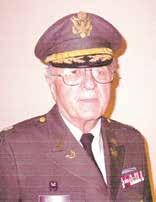



The story of Jewish World War II soldiers encompasses nearly every battlefield across the globe in the air, land, and sea. Veterans returned home with medals and tales of incredible heroism while fighting the Axis powers. Their diverse experiences have been recorded in history books, but many of them haven’t had their stories well publicized. Here are some of the stories of Jewish World War II veterans.
Philip Bradley was a forward observer for an artillery battalion with the 897 th Field Artillery, 289th Infantry regiment, 75th Infantry Division. He was born in New Haven, Connecticut, and came from a Jewish Ukrainian family originally with the last name of Braslavsky. Bradley served with the division throughout many battles in Europe including the Battle of Bulge. On the night of December 27, his battalion was attacked by a much larger force from the experienced 2nd SS and 12th SS Panzer divisions of the army commanded by Sepp Dietrich. The twelve American gunners shot 4,700 shells into the oncoming SS divisions and at times were firing so fast that they had six shells in the air at the same time. The next morning, Bradley went to observe the enemy lines and found that his unit had killed no fewer than 500 Germans the previous night. Bradley was awarded the Bronze Star along with several other medals for his actions while fighting in Europe.
In an interview, Bradley said that he knew of two true heroes who fought with him during the tough battles against the Germans. One of them was his commander, Henry Fluck, who stopped the German attack with incredible results. The other was a Jewish BAR (Browning automatic rifle) man named Abraham Matza who was killed saving the lives of his fellow soldiers.
Private Matza also served in the 289th Regiment, and on January 6, 1945 near Manhay, Belgium, a German gun emplacement opened up on the advance group in his company. The gunfire killed one American soldier while the others were trying get out of the way. Matza charged towards the machine gun nest firing his BAR until it was shot out of his hands. He then picked up another rifle and continued covering the withdrawal of his unit. This redirected the enemy fire on him, allowing the rest of the unit to reach safety. Private Matza was killed in the battle and received the Distinguished Service Cross posthumously for his courageous actions.
Pilots flying the P-51 Mustang claimed close to 5,000 enemy aircraft during World War II. The last of these kills was attributed to Jewish pilot Stanley Newman who flew 57 missions in the long-range, single-seat fighter plane. The Chicago native enlisted in the army in 1942 and graduated from flight school in 1944. Only the best candidates were selected to become fight-
er pilots, and his coolness under pressure helped him survive the last of the war. On May 8, 1945, he was flying with the 9th Air Force when he and his wingman were attacked by two German fighters. Newman forced down two of the enemy aircraft and shot down a third plane. He later said in an interview, “I got on the tail of this guy, and he was rolling back and forth.” There is a dispute whether this was the last confirmed kill of the war as another pilot claimed a German plane later that night.
After the war, Newman stayed with the military and flew during the Korean War, where he completed 100 missions. During the Vietnam War, the veteran pilot flew cargo missions into Southeast Asia. He earned two Distinguished Flying Crosses for his actions and retired as a major general.
On June 6, 1944, many soldiers, sailors and other specially trained service members landed or were flown in to conduct operations together with the regular infantry units. One of these was Corporal Eugene Levine, of New York, who was assigned to the 9th Tactical Air Command (TAC). The job of the 9th TAC was to provide close air support for the U.S. First Army that was to land on the Normandy beaches. Levine was a weather observer in an air support party that was to provide communications between the divisions landing in France and the 9th TAC. Levine was one of only
four weather observers that were trained as paratroopers or airborne gliderman, On D-Day, he landed in France in a Waco glider near Ste. Mere Eglise. His unit was attached to the 82nd Airborne Division, and Levine brought with him vital communications equipment for the division, including a newly developed transmitter. At 11:30 p.m., he was able to deliver the first weather report that day from France to headquarters.
After D-Day, Levine transferred to the 21 st Weather Squadron and took part in several battles including the Battle of the Bulge. In April 1945, he entered the Buchenwald concentration camp days after it had been liberated and stayed there for several weeks acting as a translator for the Jews who had survived the Nazi brutalities. Levine was awarded the Bronze Star for his actions in Europe.
These are just a few of the many Jewish servicemen who served with distinction and courage during World War II. Not all heroes have feature documentaries made about their service, and these Forgotten Heroes is history to be remembered.
Avi Heiligman is a weekly contributor to The Jewish Home. He welcomes your comments and suggestions for future columns and can be reached at aviheiligman@gmail.com.
classifieds@fivetownsjewishhome.com • text 443-929-4003
MAJOR APPLIANCE REPAIR
Servicing Washers , Dryers , Refrigerators , Dishwasher, stoves
All work guaranteed. Call 718 3762288
VACUUM SALES AND REPAIR
All areas call Max Flam 718-444-4904
THE LEATHER SHOPPE
The spot for all your custom leather Judaica. Tallis/tefillin bags, lulav and esrog bags, havdallah sets, challah covers, shtenders, pesach sets, matzah/afikomen bags. WhatsApp: (732) 523-0007 or email: theleathershoppe732@gmail.com for a full catalog. We ship.
MY MOTTO IS DON’T WAIT TO buy real estate
Buy real estate and wait
Your realtor for life 516-784-0856 Alexandra at Realty Connect USA
PEACEFUL PRESENCE STUDIO
Men’s private yoga, Licensed Massage & Holistic Health Guidance 436 Central Ave, Cedarhurst Info. & free video training www.peacefulpresence.com 516-371-3715
READING SPECIALIST
Trained in Orton Gillingham and many multisensory reading programs. Specializes in dyslexia and auditory processing disorder and other reading difficulties.
Rhess.education@gmail.com
Call or Text (516) 220-2059
GERBER MOVING
FULL SERVICE MOVING
Packing Moving Supplies
Local Long Distance. Licensed Insured
1000’S Of Happy Customers
Call Shalom 347-276-7422
HANDYMAN AVAILABLE
For big or small jobs, Sheetrock, carpentry, painting, electrical, plumbing, install & repair appliances
Call Ephraim at 347-593-4691
MANAGEMENT STAFF WILL ASSIST you with: * Obtaining Medicaid and Pooled Income Trust
* In-home Assessments, Individual and Family Counseling
* Securing reliable home care assistance
* Case and Care Management services
Dr. S. Sasson, DSW, LCSW (718) 544- 0870 or (646) 284-6242
HAIR COURSE:
Learn how to wash & style hair & wigs. Hair and wig cutting, wedding styling Private lessons or in a group Call Chaya 718-715-9009
ZEVIZZ WOODTURNING JUDAICA Challah knifes, batei mezuzah, besamim holder, kiddish cups, havdalah candle holders, yad for sefer torah, pens, stenders, bowls and more 952-356-2228
ECO-FRIENDLY CONTRACTOR
Big or small jobs. from conception to completion windows, doors, plumbing, electrical, Kitchen Cabinet countertop. petitions, Bathrooms, tiling. additions , painting, any construction work. call MICHEL 9175383763 Shomer Shabbos
CEDARHURST
Don’t miss this opportunity!
4 Bedroom 21/2 Bathroom House Perfectly located in Cedar Bay Park, walking distance to all. Oversized property for expansion, A Must See. LOCATION, LOCATION. For More Info call (516) 881-7727 Leave Message
WOODMERE
Beautiful, brick, colonial boasting 5 bdr 3.5 Bth in pristine condition. Excellent location, near all! Move right in! RCUSA 516-512-9626
WOODMERE
Introducing a stunning 14-side hall colonial home in the Hewlett Woodmere School District. Formal living room, formal dining room, den with a skylight. Eat in Kitchen, two sinks, a double oven, a warming draw and a microwave. First floor bedroom, a full bathroom and laundry room. Two-car garage. Upper level has four bedrooms, two full bathrooms. Finished basement with playroom, storage and utilities. Well-groomed exterior with porch adjoining the master bedroom. Hardwood floors and back patio. Central air conditioning, inground sprinkler system, alarm system. Close proximity to schools, shopping centers, restaurants, and transportation options. Mark Lipner Associate Broker Berkshire Hathaway Laffey International 516-298-8457 mlipner@bhhslaffey.com

CAN’T AFFORD YOUR PROPERTY TAXES? MORTGAGE?
Must sell for any reason? Call for FREE Consultation. Call now 212-470-3856
Cash buyers available!
WOODMERE
Spacious home within school district 14 with exquisite upgrades and central air conditioning, splendid kitchen with dual sinks, five bedrooms. Main level encompasses a spacious great room, office space, complementing the formal living and dining areas. Unfinished basement, detached garage. Expansive lot, measuring 80 x 100. Conveniently located near shopping, railroad, restaurants and places of worship.
Mark Lipner Associate Broker Berkshire Hathaway Laffey International 516-298-8457 mlipner@bhhslaffey.com
WOODMERE ACADEMY LOCATION
Unique Find! Designer renovated 10 bdrm 6.5 bth col. Stunning pvt 1st flr guest suite w/2 lg bdrms, full bth, & addl kitchen. POR.
Chana Bienstock
Miller Realty, inc. 516-449-9692
Entrance off Gourmet Glatt lot, second floor, shared bath, ideal for therapist/ office work, includes utilities, $600. Call 516-371-3715
CEDARHURST – 1200SF Retail Space
Corner Cedarhurst & Chestnut Av Next to LIRR and minyanim Call/text/Whatsapp: 516-206-1100





BIG FULLY RENOVATED, Woodmere, spacious 4bedroom 2 full bath split level.2 car garage +driveway. Backyard on water SD#14. W&D. Tons of storage space. 347-517-3552
DON’T GET STUCK WITH A TWO STORY HOUSE YA KNOW, IT’S ONE STORY BEFORE YOU BUY IT BUT A SECOND STORY AFTER YOU OWN IT!
Call Dov Herman
For An Accurate Unbiased Home Inspection
Infrared - Termite Inspection
Full Report All Included NYC 718-INSPECT Long Island 516-INSPECT www.nyinspect.com
DELIVERY PERSON NEEDED to deliver this Newspaper every Thursday morning to locations in Brooklyn. Must have Mini van or SUVand availability to work Consistently every week. Good pay Please email gabe@ fivetownsjewishhome.com or call (917) 299-8082
SEEKING ELA TEACHER Teaching position for Gr. 6. Mon.-Thurs., afternoon hours. Far Rockaway/5T area. Great salary, warm, supportive environment. Training in our curriculum is provided. Teachersearch11@gmail.com
BNOS MALKA IS SEEKING Assistant teachers, AM or PM. Also seeking Resource Room teacher. M-Th 8:00-12:30, F 8:00-11:00. Special Education degree preferred. Must teach both Hebrew and English subjects. Send resume to rungar@bnosmalka.org
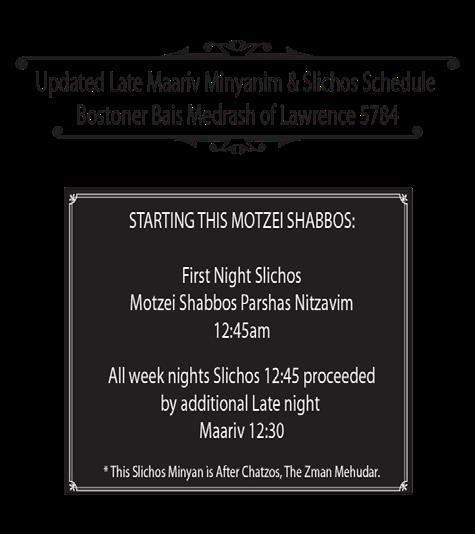
HELP WANTED HELP WANTED
classifieds@fivetownsjewishhome.com • text 443-929-4003 HELP WANTED MISC.
GREAT OPPORTUNITY!
Looking for a Payroll Processor for a Healthcare Management office in the Five Towns. No experience required. Reach out to Jobs@FCC-Corp.com
REGENTS EXPERT
Tutoring regents in Algebra and Geometry A Darchei Torah instructor. Guaranteed results Text 347-491-8045
WhatsApp 347-767-1755
5 TOWNS BOYS YESHIVA
Seeking Elem Gen Ed Teachers Excellent working environment and pay. Only lic/exp need apply. Email resume to yeshivalooking@gmail.com
SEEKING ASSISTANT teachers for elementary General Studies classes for ‘24-’25 school year. Candidates should have skills to take over for teachers if needed. M-Th, PM hours, strong support. Far Rockaway area. Send resume to teachersearch11@gmail.com
BOOKKEEPER
Excellent growth potential, Frum environment, Excellent salary & benefits. Email resume to: resumetfs1@gmail.com
MDS REGIONAL NURSE
5 Towns area Nursing Home management office seeking a Regional/Corporate level MDS Nurse to work in our office. Must be an RN. Regional experience preferred. 2-3 years MDS experience with good computer skills required. Position is Full Time but Part Time can be considered. Great Shomer Shabbos environment with some remote options as well. Email: officejob2019@gmail.com
ACCOUNT MANAGER
Long Island. Handle WhatsApp sales, cust svc. $50-$60k + comm. Apply with resume: hr@getpeyd.com

ENGLISH TEACHER
Shevach HS needs a 10th grade ELA teacher, 3 classes/day M-Th, 12:30-2:30 pm. Please send resume to mshepard@shevachhs.org.
DEVELOPMENT ASSISTANT
A multi-tasker needed for general office work. The ideal candidate is someone who is detail-oriented, responsible, and can take ownership. Looking for someone who is eager to learn, and expand his/her skill set while possessing the ability to work independently and as part of a team. Experience with Excel required. Five Towns location. In-office position only, not remote. Please send resume to 5tpart.timecareer@gmail.com
YESHIVAT KOL YAAKOV
In Great Neck, NY, is seeking general studies teachers for both the elementary and middle schools, for the upcoming academic year. Mon-Thur afternoons. Competitive salary, warm and supportive environment. Send resume to m.kalati@kolyaakov.org
SPECIAL ED TEACHER
HASC seeks Special Ed Teachers for our Early Learning Program. Warm, supportive and enjoyable working environment. Great Pay and Benefits! Sign on Bonus! Referral Bonus! Please email resume to jobswd@hasc.net
NEFESH MATCHMAKING (Chesed) Free Shadchan service for the special needs community. We help those with Medical, Physical, Emotional or Intellectual challenges find their spouse. Strictly confidential. Email for more info. Nefesh.matchmaking@gmail.com
SHMIRAS HALASHON
Text 516-303-3868 with a time slot of your choice to be careful on lashon hara. Be a part of the 1,000 people for klal yisroel!















Iwas casually flipping, actually scrolling these days, through my heavily discounted New York Times digital edition (I have long since cancelled my print version), when I happened upon an opinion piece that immediately caught my attention.
It read:
“Gossiping Is Fun. It’s Natural. And These People Won’t Do It.”
“Gossip is a universal feature of human culture. It’s also the target of passionate, widespread censure.”
So an article about lashon hora, I mused, and some people are actually against it! It must be “Moshiach’s tzeiten” (time for Moshiach)!
I looked to see who wrote it and wasn’t surprised to see that her name was Michal Leibowitz, a staff editor in Opinion.
Who else would be writing about the downside of lashon hora but a fine Jewish woman from Brooklyn, I presumed.
What did surprise me, however, was
By Country Yossi Toiv

finding this smack in the middle of the piece:
“I was first introduced to the idea that gossip is a harmful act through a particularly grating religious children’s song by Yossi Toiv, the guy whose musical stylings form the basis of the Kars4Kids jingle. Lyrics include: ‘Guard your lips from speaking evil/in your house and school and shtiebel!’
(A shtiebel is a small, often informal synagogue.) This teaching was regularly reinforced throughout my childhood — at my Jewish day school, by my parents, even by my classmates.”
I almost fell out of my chair!
A poem I had read long ago immediately came to mind:
The Arrow and the Song
By: Henry Wadsworth Longfellow
I shot an arrow into the air, It fell to earth, I knew not where; For, so swiftly it flew, the sight Could not follow it in its flight.
I breathed a song into the air, It fell to earth, I knew not where; For who has sight so keen and strong, That it can follow the flight of song?
Long, long afterward, in an oak I found the arrow, still unbroke; And the song, from beginning to end, I found again in the heart of a friend
Many years ago, I wrote a song for one of our Kivi and Tuki albums called, “Don’t Talk Lashon Hora, Don’t.” Every time, Tuki wanted to tell Kivi some juicy piece of gossip, Kivi would sing that “grating” song to him.
While our esteemed opinion writer may have found it annoying, at the time it did seem to find its way into her subconscious, instill an awareness and sensitivity to the problem, and emerge decades later as a lengthy, well-researched article that hopefully will educate, elicit reflection, and hopefully engender some
behavior modification!
The Chofetz Chaim would be proud! I just find it amazing that a catchy, little ditty written for kids so many years ago could possibly have such far-reaching repercussions!
This should serve as an important reminder to us all that the songs we write, listen to, and play for our children should always be informative, engaging, and Torah inspired.
That’s why our motto has always been: “Torah, middos and mitzvos thru laughter and song.”
Never underestimate the power of a song!
Maybe “The Old Gray Lady” has some usefulness after all!
The article can be found at: https:// www.nytimes.com/2024/08/26/ opinion/gossiping-fun-naturalcomplain.html?smid=em-share





Rosh Hashana marks the beginning of a reflective period in the Jewish calendar year. At one and the same time we look back at the accomplishments and failures of the past year and we also look forward to our lives and hoped for achievements in the coming good year now dawning upon us. The prayers of Rosh Hashana represent this duality of outlook.
They also represent the constants in our lives and souls. The Malchiyot section tells us of G-d’s ever present rule over his world and its creatures. It is this constant that surpasses time and space, calendars and timepieces. Life is too random and unstructured for human society to begin to understand and to cope with in the absence of this constant.
It is only because of this omnipresent constant that we retain the ability to glimpse the past and foresee the future simultaneously. We are all aware of the famous Hebrew quip that says that the past is gone, the future has not yet arrived, and the present is but a wink of the eye. Yet the present is always with us with its demands and challenges. It is the constant reminder to us of G-d’s eternal sovereignty, always omnipresent even if sometimes hidden.
The L-rd ordained for us so many

By Rabbi Berel Wein

commandments so that in every step in life that we take we are reminded of His presence and sovereignty. We are never really alone in our existence in this world. This is one of the great sublime messages of Rosh Hashana.
Rosh Hashana is called, in our liturgy and rabbinic literature, the day of remembrance. G-d, so to speak, remembers us for good and for life, and we remember our
ourselves. Heaven, so to speak, holds up a mirror to us, and as we move, so does our reflection in Heaven.
If we are not diligent in remembering, then we are prone to be forgotten as well.
Rosh Hashana is the tool to reinforce our memory of people gone and of past events, of family traditions and ancient customs and of the core events of Jewish history.
On Rosh Hashana, the entire sweep of hu-
The shofar represents our trumpet call to national and spiritual greatness.
entire history from the binding of Yitzchak till today. The most painful of all conditions, as we are all so aware of today in our time, is the disappearance of memory. The person we loved and cherished is gone even if the body of that person is still present and functioning.
If this is true regarding individual human beings, how much more so does it apply to national memory? We ask G-d not to forget and forsake us, but we are also bidden to remember our story and
manity is remembered and assessed. In a flash, the past becomes the present. That is the tremendous aspect of memory, for by being able to evoke the past, we recreate it as part of the present. The Zichronot section of the liturgy of Rosh Hashana provides us with this gifted ability.
But Rosh Hashana is also a holiday of optimism and of looking forward and ahead. We resolve to become better people, more humane and G-dly in our attitudes and behavior. The echo of the shofar
of Sinai that we hear, or our own sounding of the shofar, inspires us to strive to become a holy nation and a kingdom of priests. That echo has never diminished, and the challenge it conveys has also never lessened. Rising to that challenge is the goal set for us in the new year. The sounds of the shofar remind us again of Sinai and its eternal covenant and strictures. Just as our past was governed by it, so, too, will our future be determined by its structure and parameters.
So, too, to a certain extent, our future can be assessed and can become more predictable on Rosh Hashana. The more we are able to hear the echo of the shofar of Sinai, as we strain to listen to the faint strains of the shofar of redemption, the better the new year will be for us individually and nationally. The shofar represents our trumpet call to national and spiritual greatness.
All of the verses of the liturgy of Shofrot combine these two soundings – Sinai and redemption – in their message and import. The great army of G-d’s eternal people is being summoned to arms, to face the challenges of the new year. We have to hear those shofar soundings in our souls and not only in our ears.
Kesiva v’chasima tova.

According to the tzaddikim, Rosh Hashana is not a time to speak in public. Rather, it is a time of (Melachim 2:4:13) “b’soch ami anochi yishbas, dwelling amongst the people.” The only way one person can possibly get up to speak in front of other Jews on Rosh Hashana is to try and offer a little inspiration for the blowing of the shofar. Therefore, may the following words be accepted as an effort to encourage the King’s subjects on the occasion of His coronation.
One of the major events we remember and “remind” Hashem of by blowing the shofar on Rosh Hashana is the merit of Yitzchak who allowed himself to be slaughtered for Hashem’s sake at the Akeida. We must wonder what Yitzchak was thinking as he walked toward Har Hamoriah to die al kiddush Hashem, in order to sanctify G-d’s name. The Midrash (Tanchuma Vayeira 23) relates that Yitzchak said, “If [Hashem] has chosen me, my soul is given over to Him. Over my blood, dami, I am greatly pained.” And nevertheless, “‘The

By Rav Moshe Weinberger
Adapted for publication by Binyomin Wolf

two of them walked together’ with certainty, this one to slaughter and this one to be slaughtered.”
The Maharam Shick asks why, if Yitzchak was so willing to give his life that he walked together with his father Avraham with equal determination to do Hashem’s will and if he declared “my soul is given over to Him,” why does the Midrash say he was exceedingly pained over the spilling of his own blood?
He answers that he was certainly more than willing to give up his life and acquire the World to Come in one moment. But what pained him was that he would no longer have the opportunity for “dami,” to stop and be silent. Dami can mean “my blood,” but it can also mean “my stopping” or “my silence,” as in the phrase, (Vayikra 10:3) “V’yidom Aharon, And Aharon was silent” or (Tehilim 30:13) “L’ma’an yizamericha kavod v’lo yidom, in order that I sing out Your glory and not be silent.” Yitzchak was thinking, “My soul is given over to Hashem but I cannot bear the pain of knowing that
I will no longer be able to stop and silence my own personal desires. I will no longer be able to fulfill, (Tehilim 44:23) ‘We are killed for your sake all day.’” What does it mean to be killed for Hashem all day? One can only be killed once! It must mean the little death one experiences when he says “no!” to his body’s desires because of his belief in Hashem. A person can die a thousand deaths to sanctify G-d’s name in that way. A person can give over his soul, his desires, and his honor over to the Master of the World.
The Tur in Orach Chaim 581 quotes the Yerushalmi that on Rosh Hashana, “[The Jewish people] eat, drink, and rejoice on Rosh Hashana [even though it is the day of judgment] because they know that Hashem will do a miracle for them.” The Gemara in Brachos (20a) explains the key to meriting a miracle. The Gemara states, “Rav Papa said to Abaye, ‘What is different about the earlier generations for whom miracles were performed, but miracles are not performed for us?’ ... He said to him, ‘The earlier gen-
erations gave their lives for the sanctification of G-d’s name but we do not give our lives for the sanctification of G-d’s name.’”
We must understand why Rav Papa asked this question to Abaye in particular. We must also understand how Abaye could say that the people in his generation did not die to sanctify G-d’s name. Weren’t multitudes of Jews willing to give their lives in order to keep and study Torah at the time of the Romans? Abaye therefore must have had something else in mind.
Notably, “Abaye” was not Abaye’s real name. According to Sherira Gaon and Rashi on Gittin 34b, his real name was Nachmeni. His father died before Abaye was born, and his mother died shortly after naming him Nachmeni. He was raised by his uncle, Raba bar Nachmeni. Raba bar Nachmeni did not want to call his adopted son by his own father’s name. Therefore, with great love, he called his son “Abaye,” which is an acronym for (Hoshea 14:4) “asher bicha yerucham yasom, in You, for whom the orphan is granted mercy.” Abaye

R8 grew up with great loneliness and poverty. Nevertheless, he was moser nefesh, sacrificed, and overcame all of those challenges to become “Abaye,” thus fulfilling “we are killed for your sake all day.”
It is a miracle whenever a person engages in self-sacrifice because he goes against his own nature. Abaye did not mean that people do not give up their lives for G-d. Every Jew has the potential, and many people, until today, give up their lives for Hashem’s sake.
Abaye knew that Jews will give up their lives for G-d. He was saying that in his times, people did not live for G-d by sacrificing their own desires for His will. When a Jew goes against his nature, he merits that Hashem will go against nature by performing a miracle for him.
I heard from my rebbe, Reb Dovid Lifshitz, zt”l, who heard from Reb Yerucham Levovitz, zt”l, that when Reb Yerucham was young, a tightrope walker came to his town to perform. The town did not usually experience much excitement so this was a big event. This was particularly so because there was no net below the tightrope. After the performance, everyone crowded around the tightrope walker to ask him all about it. One man asked, “What was the scariest part? Was it when you first got
onto the rope? Was it as you walked down the rope as it got lower? Or was it when the rope began going higher?” The performer answered him, “No, the most frightening part was turning around.”
Reb Yerucham concluded that, indeed, the hardest thing in the tightrope of life is turning around after one has become accustomed to doing things in a certain way
his life over to G-d time and time again. When Jews do this, then Hashem will do miracles for us and deliver us healing and rectification for us and our children.
On erev Rosh Hashana one year, the Minchas Elazar of Munkacz was asked by his very young grandson, “Zayde, please blow the shofar!” He loved hearing his grandfather blow the shofar throughout the
When a Jew goes against his nature, he merits that Hashem will go against nature by performing a miracle for him.
for a long time. Going against one’s nature and turning around is a miracle, and by turning around, one merits miracles.
Such sacrifice does not have to be dramatic. If one is accustomed to arriving for Shacharis five minutes late every day, he can turn around and come five minutes early every day. If one is accustomed to always outdoing what other people say and “getting in the last word,” he can turn around. When one reverses old habits, he can give

month of Elul and was disappointed that his grandfather had not blown the shofar that morning. The Rebbe tried to explain to his grandson that we do not blow the shofar on erev Rosh Hashana but he insisted, “Zayde, please blow the shofar!” No matter how many times he tried to explain to him that he could not blow the shofar, his grandson would not listen. The child began to cry. Finally giving in, the Rebbe privately blew the shofar for his grandson.
The next day, Rosh Hashana morning, he got up in front of the shul right before the blowing of the shofar and said: “Master of the world, You can testify that I have always done everything I could to keep every single halacha and minhag. But yesterday, because I could not bear to listen to my grandson cry, I blew the shofar in violation of the minhag. Hashem, how can you bear to listen to the cries of millions of your children for thousands of years? They are not asking to hear one hundred blasts of the shofar, thirty blasts, or even ten blasts. They are only begging for one blast of the shofar! Tika b’shofar gadol l’cheiruseinu, sound the great blast of the shofar of our freedom, announcing the arrival of Moshiach!”
Master of the world, our lives are given over to You. Help us turn around and recognize that our bodies and our souls belong to You, and may You sound the great shofar of our redemption with the coming of Moshiach this year.
Rav Moshe Weinberger, shlita, is the founding Morah d’Asrah of Congregation Aish Kodesh in Woodmere, NY, and serves as leader of the new mechina Emek HaMelech.


By Harav Yaakov Feitman

Parshas Nitzavim is generally seen as the introduction to both Selichos and Rosh Hashanah. This not only makes sense but is made clear by the Holy Zohar (Bamidbar 231a): “Wherever we find the word hayom – meaning “today” – the reference is to Rosh Hashanah. One of the proofs of this connection is the pasuk in Iyov which relates that “it was hayom, and the angels arrived to stand by Hashem.” Rashi comments there that this took place on Rosh Hashanah. Some meforshim explain that hayom refers to the most important day, when we are judged and hopefully granted life and happiness for the coming year.
However, Rav Yosef Sholom Elyashiv, zt”l, turns this citation on its head. In his Sefer (Divrei Agadah) on matters of hashkafah – Jewish thought – he explains that the Zohar is actually giving us both guidance and chastisement for the Yomim Noraim. “Why are you just standing there?” Rav Elyashiv asks. The pasuk is admonishing us for remaining the same as we were the previous year. “We must use the
opportunity to change,” he teaches. “We must be different and better.”
The Satmar Rebbe also noted that the pasuk, (Devarim 11:12) “The eyes of Hashem…are always upon it from the beginning of the year to year’s end” seems to contradict itself. The pasuk begins by calling the new year hashanah – the year – and then refers to it as just shanah –year. The rebbe pithily points out that most of us think, mean and say that “this will be the year. This will be the year that I will change…improve…not do this…that, etc. However, by the end of the year, it is painfully clear that it was just shanah –another year.
Our job before Selichos and Rosh Hashanah is to change that pattern and change ourselves. Let’s actually make this the year. Perhaps, with so much that has occurred this year – Hamas, hostages, rampant antisemitism – this year we will make it happen. We will make this hashanah, the special year which will change everything.
Let us return to Rav Elyashiv. He
reminds us that on the Rosh Hashanah night (some do this both nights) we will eat the head of a fish or even head of an animal and recite “to be the head and not the tail.” Rav Elyashiv explains that this means that in general we literally take the tail end of the previous year and just go right into the head of the new year with no time to pause or reflect. We might add that other meforshim interpret the word nitzavim – to stand – more positively and optimistically, as to stop and think. It means that we should stop our random running headlong from one deadline to another, from one so-called important meeting, e-mail or event to another and stop to make some of the most important decisions of our lives: what will we do with our future? What do we wish 5785 to look like?
One way to achieve this is to look back one more parshah to the beginning of Parshas Ki Savo. There we read about bikkurim – First Fruits. The Baalei Mussar tell us that we read about bikkurim now and at the seder because in Tishrei
and Nisan, our two beginnings, we have to start fresh. Rav Moshe Feinstein (Darash Moshe, Parshas Ki Savo) notes sadly that many young men enter the yeshiva brilliantly with much potential. Everyone says this will be the next gadol hador, the next leader in Klal Yisrael. Suddenly, however, the genius falters, the bright light dims, and he is just another talmid, just another year. What happened? Rav Moshe writes that he lost that freshness, that excitement. He is phoning it in, repeating words but there is no excitement or novelty. My rebbe, Rav Yitzchok Hutner (Pachad Yitzchok, Rosh Hashanah Maamorim 14, 16 and 27) points out that the word and concept shanah carries with it a dual and seemingly contradictory connotation. On the one hand, it is cyclical and repetitive, and on the other, it is new and exciting. This is the saga of our lives. In the morning, we daven, “Please accustom us to study Your Torah.” The word for accustom in Hebrew is targileinu, which usually refers to rote or habit. And yet, we know that these are bad terms, generally

referring to religious acts which are performed without energy and inspiration. Rav Hutner explains that a human being requires both. We must have routines, such as going to shul, attending a class, washing our hands, which come to us naturally and almost automatically. However, we must imbue these events with originality and exhilaration. That is both the magic and challenge of Rosh Hashanah.
How do we go about achieving this paradox? The Gra, Gaon of Vilna, writes that one who has done teshuvah – repentance – is like a ger, a Jew who has converted. He begins life again like a newborn baby. I tell my students that if someone calls you a baby, say thank you. It is a wonderful compliment. Not only do we not believe in original sin, we know that a newborn is innocent and pristine. He or she has no sins or deficits. For this reason, we wish the baby at his bris, “Just as he has entered into this covenant, so may enter Torah, marriage and good deeds.” Isn’t it insulting to tell someone in his twenties to be like the day of his bris? Actually, not all – we wish both the bride and the groom to be as holy and pure as that baby was several decades ago.
That is our day of Rosh Hashanah. We will often remind ourselves on
Rosh Hashanah that this is the day of our creation. It is our birthday and the beginning of the world itself. That is what gives us the ability but also the responsibility to become new again.
The story with the Gerrer Rebbe is well-known but worth repeating. The Bais Yisrael was giving brachos after davening, and an entire group of boys from a baal teshuvah yeshiva were receiving their bless-
meant was that since this is the pinnacle of Creation, which begins on the 25th of Elul, we have already reflected upon all the glories of Creation. After Hashem first created them, he has since been recreating the universe every moment, as we say in davening, “He recreates in His goodness every single day the entire universe.” For us, what this means is that we are not the same as we were yesterday, 10 years ago
It is to celebrate our ability to change, for everything, including ourselves, is new.
ings. One boy from a mainstream yeshiva somehow got “stuck” in the middle and walked up to the Rebbe, saying, “I am not a baal teshuvah.” The Rebbe responded sharply but with a smile, “And why not?”
On Rosh Hashanah, we all start fresh. Rav Nosson Wachtfogel, founding Mashgiach of Bais Medrash Govoha of Lakewood, used to say that “Rosh Hashanah we all spend two days exploring the palace of the King.” One of the many things he

or even one minute ago. For that reason, we can easily change since we are not the same anyway.
When we look at Rosh Hashanah this way, we can understand why we don’t say viduy – confession –on this day, nor do we fast or cry. As Nechemiah (8:10) told Klal Yisrael on their first Rosh Hashanah in Eretz Yisrael, “Do not mourn and do not weep… Go eat rich foods and drink sweet beverages… Do not be sad; the enjoyment
of Hashem is your strength.” Nechemiah was teaching us all that this special day is not only for teshuvah. It is to celebrate our ability to change, for everything, including ourselves, is new. My rebbe adds that that Nechemiah also told them to do chessed on this day, for since the world was created with and for chessed (Tehillim 89:3), it is a day to perform acts of kindness and to recreate ourselves completely. When Hashem made us it was “something from nothing,” but now we can take whatever we have which is good and pure and recreate the rest in His image which is perfect.
Perhaps we can add that this is also why we sing so many beautiful tunes on the Yomim Noraim, beginning with Rosh Hashanah. A niggun is both new and old. The sounds go up and they go down, just like us. But we can, as Chazal say, go down in order to go up. We can utilize our downfalls to rise ever higher. Let us use these tools to both climb the heights and then to remain up on top of the mountain, as we shall say on each night of Rosh Hashanah. May we and all of Klal Yisrael have a kesivah vachasimah tovah.

“Last year, this year, and next, I and standing strong for our entire Long Island community, even when few on the other side of the aisle will join me, Together, we will not back down.”
- Assemblyman Ari Brown


By Ra BBi Daniel Glatstein

Avraham Avinu was instructed by Hashem to take his son Yitzchak, whom he had eagerly awaited for 100 years and from whom he had been told his legacy would continue, and offer him as a korban to Hashem. Avraham Avinu passed this test, displaying great zeal and alacrity, placing the love of Hashem above his human emotions.
Akeidas Yitzchak is central to many of the minhagim and tefillos of Rosh Hashana. It is the zechus we most invoke on the Yom HaDin. Let us present a number of examples.
The only mitzvah d’Oraisa specific to Rosh Hashana is the mitzvah of tekiyas shofar. The Gemara says that the reason we blow the shofar of a ram is to remind Hashem of Akeidas Yitzchak. Hashem gives us an assurance that when we do so, He will view it as if we personally sacrificed ourselves at the Akeidah.
In Mussaf of Rosh Hashana we recite the bracha of Zichronos, asking Hashem to remember us for our favor. Here, too, the mention of the Akeidah is front and center.
Our G-d and the G-d of our forefathers, remember us with a favorable remembrance before You, recall us with a recollection of salvation and mercy from the primeval, loftiest heavens. Remember for us, Hashem, our G-d, the covenant, the kindness, and the oath that You swore to our father Avraham on Mount Moriah. Let there appear before You the Akeidah when Avraham, our father, bound Yitzchak, his son, upon the altar and he suppressed his mercy to do Your will wholeheartedly. So may Your mercy suppress Your anger from upon us. We then conclude, “ For it is You Who eternally remembers all that is forgotten, and there is no forgetfulness before Your Throne of Glory, and may You mercifully remember today the Akeidah of Yitzchak for the sake of his offspring Blessed are You, Hashem, Who remembers the covenant [made with Avraham Avinu at the Akeidah].”
When we ask Hashem to recall merit on our behalf, it is the Akeidah that we focus on more than any other zechus that Klal Yisrael may have. The bracha of Zichronos is centered around the Akeidah, asking Hashem to remember the exceptional self-sacrifice of our forefathers as a merit on our behalf.
Throughout our illustrious history there were nu-
merous tzaddikim who also performed mitzvos and exhibited personal sacrifice in the service of the Ribbono shel Olam. What is special and unique about the Akeidah that it stands alone as the paragon of merit that we invoke on Rosh Hashana? Moshe Rabbeinu likewise accomplished numerous spiritual achievements on behalf of Klal Yisrael. Why do we not invoke any of his maasim tovim as a zechus for us on the Yom HaDin? Why do we not remind Hashem, for instance, that Moshe Rabbeinu taught us all the entire Torah? Why is the Akeidah the central event that we invoke as cause for Hashem to be merciful in His judgment on Rosh Hashana?
The subject of the Torah reading of the second day of Rosh Hashana is the Akeidah. The Gemara teaches that on the first day of Rosh Hashana we lein, “Hashem remembered Sarah as He had said…” (Bereishis 21:1) which is the opening pasuk heralding the birth of Yitzchak, and on the second day we lein, “And it happened after these things that G-d tested Avraham…” (ibid., 22:1), which are the opening words of the parasha of the Akeidah. Rashi explains that we lein this parasha so that Hashem recalls Akeidas Yitzchak as a merit for us on the Yom HaDin.

The minhag on Rosh Hashana to recite Tashlich at a body of water is another instance when we invoke the merit of Akeidas Yitzchak. The Rema codifies that we go to the water to recite the pasuk, “V’sashlich b’mtzulos yam kol chatosam, and cast into the depths of the sea all of our sins ” We spent hours davening in shul; why could we not spend a few more moments and add this pasuk to the davening? Why must we go down to the river to recite this pasuk?
The Mishnah Berurah explains that is it based on the Midrash that states that when Avraham Avinu went to perform the Akeidah, the Satan tried various methods to prevent him from fulfilling Hashem’s decree. One tactic employed by the Satan was that he created a river to block Avraham’s path. Avraham was neck-deep in the water, crying out to Hashem, “Save me, for water has reached my soul ,” before he was able to pass through.
Thus, Tashlich is yet another custom of Rosh Hashana which we perform to invoke the great merit of the Akeidah
The Shulchan Aruch writes that it is customary to eat the head of a ram on Rosh Hashana as a siman, a portent and prayer, “she’nihiyeh l’rosh v’lo l’zanav, that we be as the head and not as the tail.” Why the head of a ram? The Shulchan Aruch explains: It is to remember the ram that Avraham used as a replacement at Akeidas Yitzchak.
Prior to blowing the shofar, the baal tokeiah recites a special tefillah. In this prayer he states: “May You be filled with mercy upon Your people, and may You contemplate the ashes of Yitzchak, our forefather, that are heaped upon the Altar. May You deal with Your children with the Attribute of Mercy and may You overstep for them the line of the law. Remember for their sake the Akeidah of Yitzchak for his offspring…” Here, too, the Akeidah receives unique prominence, in that no other event from our collective national history is mentioned in his prayer — only the Akeidah.
There are various customs as to what item should be used in the performance of kapparos. The Rema mentions the use of a chicken, while the Mishnah Berurah states that a fish may be used if a chicken is not available. A third minhag is to use money. The Meiri, however, maintains that the original custom was to use an ayil, a ram. The use of a ram, explains the Meiri, allows us to understand the mechanism of the ritual of kapparos. The ritual of kapparos is a zecher, remembrance, of the Akeidah
When Avraham was told not to harm Yitzchak, he caught sight of a ram that he then offered in lieu of his son. Every action Avraham performed on the ram he did with the express intent that Hashem should consider it as if he were performing it on his dear son Yitzchak.
“Yehi ratzon, may it be Your will, that this should be as if I am bringing Yitzchak as a korban.” He repeated this tefillah with each step of the avodah. Thus, Avraham Avinu performed the very first kapparos
The purpose of kapparos, the Meiri explains, is that it is a re-enactment of Akeidas Yitzchak! In fact, the Meiri mentions that kapparos was originally practiced on Rosh Hashana itself.
We have identified seven different practices of Rosh Hashana that are performed to invoke the great merit of the Akeidah. Let us discover why the Akeidah is so central to Klal Yisrael having a successful outcome on the Yom HaDin
Toward the end of Selichos, we state, “Mi she’ana l’Avraham b’Har HaMoriah, Hu ya’anenu, the One
av R aham BeseecheD
h ashem that just as he was silent anD DiD not challenGe h ashem’s commanD, so too — on this Day — h ashem shoulD Remain silent anD not pRosecute Klal y isR ael.
Who answered Avraham Avinu on Har HaMoriah, He should answer us [as well].” Which tefillah is referenced here? When Avraham Avinu was proceeding with the Akeidah, we don’t find that he davened for anything at that time. Avraham was focused on performing exactly what Hashem had instructed him to do. What are we referring to when we say that Hashem, Who answered Avraham on Har HaMoriah, should answer us?
One may argue that the centrality of the Akeidah to Rosh Hashana is because Rosh Hashana is the day that the Akeidah took place. Is that, in fact, so? Let us explore. When did the Akeidah take place? Interestingly, the Torah does not tell us when the Akeidah actually happened. The Mishnah and the Gemara also do not give us an indication as to when these events transpired.
The Pesikta Rabasi says that when Hashem instructed Avraham to offer Yitzchak as a korban, Avraham could have challenged this unusual command. Hashem had told him “Since through Yitzchak will offspring be considered yours” (Bereishis 21:12); how
could that be reconciled with this new directive: to bring Yitzchak as an offering to Hashem? However, Avraham refrained from challenging Hashem. He remained silent; he had no reaction other than to actually perform the tzivui with outstanding zerizus. “But I am like a deaf man, I do not hear, like a mute who does not open his mouth” (Tehillim 38:14). Avraham, however, did ask Hashem to repay him in kind. When the descendants of Yitzchak would be judged by Hashem bayom hazeh, on this day, then, Avraham asks, Hashem should disregard the prosecutors and accusers who may rise up with claims against Klal Yisrael. Regardless of how numerous they may be, just as I remained quiet when instructed to perform the Akeidah, so, too, should You, Hashem, remain silent and not prosecute Klal Yisrael when accusations are hurled against Yitzchak’s descendants.
This Midrash is revealing to us that Avraham actually did offer a prayer at the Akeidah. Avraham beseeched Hashem that just as he was silent and did not challenge Hashem’s command, so too — on this day — Hashem should remain silent and not prosecute Klal Yisrael. Avraham’s reference to “this day” clearly indicates that the Akeidah took place on the Yom HaDin, on Rosh Hashana.
The Midrash then continues and tells us the name Avraham gave to the place where the Akeidah took place. “And Avraham called the name of that place Hashem Yeraeh, as it is said this day, on the mountain Hashem will be seen” (Bereishis 22:14). To what does hayom, this day, in this pasuk refer? The Midrash then explicitly asserts that it was Rosh Hashana when the Akeidah took place, and Hashem acceded to Avraham’s request. He would remain silent when the accusing angels would prosecute the Bnei Yisrael, and He would disregard their accusations.
Avraham then asked Hashem to swear that He would honor His commitment, and, in fact, Hashem swore, as the pasuk states, “And he [the angel] said, ‘By Myself I swear—the word of Hashem’” (ibid., 22:16).
The Midrash explains that this is why the Torah says that Rosh Hashana takes place “Bachodesh Hashvi’i.” It refers not only to the seventh month, but also to the “month of the shevuah, oath,” the oath that Hashem took that He will ignore the prosecutors.
One may suggest that the Akeidah is central to the service of Rosh Hashana because it happened on Rosh Hashana. But upon further analysis, is this really a satisfactory rationale? Just because Rosh Hashana is the anniversary of the Akeidah, should the Akeidah now become the central theme of Rosh Hashana? Furthermore, as we are about to learn, it is far from unanimous that the Akeidah even took place on Rosh Hashana in any case.
The Yalkut Reuveini, an ancient compilation of midrashim, records that the Akeidah took place on Yom Kippur, not on Rosh Hashana. Likewise, Derashos Even Shva’ib states that we can make a kal vachomer, an a fortiori argument. Non-Jews are

arlei lev, their hearts are uncircumcised. Their hearts are not as perceptive of spirituality as the heart of a Jew. Yet, they can do teshuvah and return to God. Kal vachomer, certainly, Jews, who are malei lev, who are soft-hearted and perceptive to teshuvah, should definitely do teshuvah. Especially on this holy day, on Yom Kippur, which is designated for our teshuvah, as it received many added, enhanced kedushos. He writes that it is the day on which Avraham Avinu was circumcised , it is the day of the Akeidah, it is the day on which we received the second Luchos, and it is the day that we were forgiven for the Cheit HaEigel. Clearly, he, too, is of the opinion that the Akeidah took place on Yom Kippur.
According to the opinions that the Akeidah happened on Yom Kippur, we still do not blow the shofar of a ram on Yom Kippur or perform any other ritual on Yom Kippur to recall Akeidas Yitzchak. Clearly, the remembrance of the Akeidah is unrelated to the day on which it transpired.
There is even an opinion that the Akeidah did not take place in Chodesh Tishrei. Midrash Rabbahexpounds upon the pasuk, “ Hachodesh hazeh lachem ,” Shemos 12:2), which refers to Chodesh Nissan. Many great events took place in Nissan. Hashem chose the Jewish people in Nissan, and He will ultimately redeem us in Nissan. Yitzchak was born in Nissan, and, according to this midrash, Akeidas Yitzchak took place in Nissan as well. And yet, according to this opinion, there is no commemoration of Akeidas Yitzchak in the month of Nissan. Evidently, the centrality of the Akeidah to Rosh Hashana is not a matter of commemorating the anniversary of the Akeidah. The merit of the Akeidah must be fundamental to the very essence of the Yom HaDin. Let us try to uncover the essential connection of the Akeidah to Rosh Hashana.
Rav Yonasan Eibeshutz offers an outstanding insight into what actually transpires on Rosh Hashana that will open up for us a new dimension of understanding why the Akeidah is so essential to our avodah on the Yom HaDin.
The pasuk states, “What is frail man that You should remember him, and the son of mortal man that You should be mindful of him?” (Tehillim 8:5). The Gemara explains that this question was asked of the Ribbono Shel Olam at the time that He created Man.
When Hashem wanted to make Man, He first created a group of angels. He then queried these malachim, “Should I make Man in My image?” The malachim asked what Man was, and Hashem explained how Man would act, how he would conduct himself.
When the malachim understood the nature of Man, they were perplexed. They asked Hashem, “If this is Man, why would You want to create him? “What is frail man that You should remember him, and the son of mortal man that You should be mindful of him?” Creating Man does not seem to be a good idea.”
Hashem extended His small finger and burned all
the malachim. He then created another group of malachim, and the process repeated itself. They, too, expressed their incomprehension that Hashem would want to create Man. The second group was similarly destroyed.
When Hashem then queried a third group of malachim whether or not to create Man, their answer was, “It is Your world; do as You please.” Man was then created.
Many years passed; eventually the Dor HaMabul, Generation of the Flood, and the subsequent Dor HaHaflagah, Generation of the Dispersion, arrived. The malachim saw how corrupt and destructive these generations were and turned to Hashem, suggesting that the first two groups of angels appear to have been correct in their assessment of the desirability of Man’s creation.
Hashem responded to the malachim with the following words, “V’ad zikneh ani hu, v’ad seivah ani
on eveRy Rosh h ashana since that initial cReation, h ashem RecReates m an all oveR aGain.
esbol,” which can be translated, “Until I am old, I am He; until I get old I will tolerate him” (Yeshayah 46:4). Hashem states, “Although Man may be bad now, one day he will be good, and I will patiently tolerate him until he is.” What is the meaning of Hashem’s response?
Although the malachim advised Hashem against it, Hashem created Man, on Rosh Hashana. Rav Yonasan Eibeshutz teaches us that this process is repeated annually. On every Rosh Hashana since that initial creation, Hashem recreates Man all over again.
We believe that the calendar is not linear, progressing onward continually, but rather it is circular, a living cycle that repeats itself every year. Every year on Rosh Hashana, Hashem re-creates Man for the upcoming year. Hashem created Adam on the first Rosh Hashana, and He recreates Man every year on Rosh Hashana. Each and every one of us is being re-created annually.
As Hashem embarks on His annual creation of Man, the malachim once again challenge Him and try to persuade Hashem that creating Man is not a wise choice. They are mikatreig annually, attempting to
prevent Hashem from repeating what they consider to have been a mistake in the first place. On the very first Rosh Hashana, the malachim asked Hashem, “What is frail man that You should remember him, and the son of mortal man that You should be mindful of him?” and every year they again ask Hashem this question. They point out our flaws and the numerous aveiros that we committed, and they advise Hashem to not repeat the mistake of creating Man.
Every Rosh Hashana there is a war in heaven! All the angels cry out to Hashem, “Don’t do it! Perhaps proceed with the re-creation of the entire universe, of the world and all its animal and plant inhabitants — but don’t create Man! Man is corrupt. Man is destructive. Man is evil. Don’t make him again.”
A fascinating Zohar explains the pasuk, “ U’la’adam lo matzah eizer k’negdo” (Bereishis 2:20), which literally refers to the fact that Man could not find a mate. The Zohar explains it in a novel way. He says that Adam could not find any eizer, help, among Creation as every creation tried to dissuade Hashem from making Man! The trees, the animals, the birds, the fish, the angels — everything in Creation — shouted out to G-d that creating Man was a bad idea. Man did not have anyone to help him, anyone to promote his cause and defend his right to be created.
We come to shul on Rosh Hashana dressed in our yom tov finery, feeling that we have a clean slate and are getting a fresh start. However, Rav Yonasan Eibeshutz writes that if only we understood what was transpiring in Shamayim on Rosh Hashana — that tremendous efforts were being expended to prevent us from being re-created, working to end our existence — we would not be able to eat, drink, sleep, or dress, for fear of losing the war with the malachim. There are myriads of angels fighting with Hashem, striving to convince Him to end the existence of Man.
The Sfas Emes presents the same idea. This challenge of the malachim resurfaces annually on Rosh Hashana. Part of the din on Rosh Hashana is defending against this kitrug, defending our right as humans to exist. Rosh Hashana is thus a very fearsome day.
How can we hope to be victorious against the malachim and their claim that Man’s actions have clearly demonstrated that he does not deserve to be re-created? Can we truly claim that we are “prime examples” of what Hashem had in mind when He made Man?
The Midrash Tanchuma states that when Hashem wanted to create the world, the angels told Him that He should not ruin His beautiful world by creating Man. The angels scanned the future history of Mankind and declared, “Mah enosh ki tizkerenu, What is frail man that You should remember him?” Hashem responded that they were looking at the wrong generation! The angels were looking at the generation of Enosh, when the sin of idolatry was introduced, when they, in fact, should be looking elsewhere. “You are looking at the generation of the Mabul,” Hashem tells them, “Let me direct your attention to a different time, a different

generation, so that you will see the type of behavior that more than justifies the creation of Man.” Hashem then showed the malachim Avraham Avinu taking his beloved son Yitzchak, and bringing him to the Akeidah with zerizus and simcha to fulfill the word of Hashem. Avraham allowed his love for Hashem to transcend the love he had for his long-awaited, most-beloved son. It is with the merit of the Akeidah that Hashem silences all the angels and all the naysayers who did not want Him to create Man.
As noted above, the Pesikta teaches that Avraham Avinu had implored Hashem that just as he, Avraham, had remained silent in the face of the nisayon of the Akeidah, so too should Hashem maintain His silence in the face of our accusers. In his tefillah, Avraham Avinu referred to this annual war between Hashem and the angels about allowing the re-creation of Man. Avraham implored Hashem to recall his self-sacrifice for every Rosh Hashana to come, and to maintain His defense for the right for Man to be created yet again.
The response to the malachim, the answer as to why Hashem created Man, with all his many flaws and deficiencies, is to observe Avraham Avinu and see the level he achieved. Our right to be created against the accusations of those who seek to undermine the value of our existence comes only through the Akeidah
The Akeidah:
Critical to Our Defense on the Yom HaDin
Rav Dovid Cohen, the Rosh Yeshivah of Chevron, explains that this concept clarifies why the Akeidah plays such a central role to our service on Rosh Hashana. The Akeidah is the one defense we have against the warring angels, against the prosecutors and accusers who readily point out our flaws and beseech Hashem not to make the same mistake again, not to give mankind a new lease on life. The Akeidah is proof that Man can transcend his taavos, can put his physical and emotional desires aside in the service of Hashem, that Man can achieve the spiritual levels that will justify his existence.
We repeatedly invoke the zechus and the message of the Akeidah, reminding Hashem of the event that provides a definitive answer to their claim, silencing them and allowing us to be granted a favorable din True, Man can be destructive and corrupt, but Man can take another direction as well. Man can perform such an act of selfless sacrifice as Avraham did, that, in doing so, he has the potential to rise to a madreigah, spiritual level, that supersedes that of even the malachei ha’shareis, ministering angels.
When the angels look down from Shamayim and see Man achieve a level such as Avraham did at the Akeidah, they are filled with tearful emotion from witnessing so profound an act being performed by a human being. That is why the central focus of the Rosh Hashana service is Akeidas Yitzchak. It is the merit of the Akeidah that will literally save the day.
After witnessing the Dor HaMabul and Dor Ha-
Haflagah, the malachim expressed their opinion that it had been a mistake to have created Man. Hashem answered, “V’ad zikneh ani hu, v’ad seivah ani esbol, I will tolerate him until I get old.” What does Hashem mean? Mortals age, people get older from year to year. But Hashem is immortal; He does not age!
The Maharsha explains that Hashem sometimes appears to the neviim, prophets, in different guises. For example, at Krias Yam Suf, Klal Yisrael saw Hashem as an ish gibor milchamah, a mighty warrior. At Har Sinai, when the Jewish nation was in a prophetic state, Hashem appeared to them as a zakein malei rachamim, an elderly person who was filled with compassion.
Hashem agreed with the angels that then, during the Dor HaMabul and Dor HaHaflagah, Mankind is undeserving of existence. But, says Hashem. I will wait around, I will be patient, until I am an old man — until
the spiRitual poweR of the shofa R is what
tRiGGeReD this incReDiBle comeBacK of the foRces of GooD while it simultaneously quells the foRces of evil.
the time when I will appear to Klal Yisrael as an old man at the time of Mattan Torah. Hashem said that even though at that moment in time Man did not deserve to live, the day will come that he will justify his existence. On the day of the Giving of the Torah you will see Klal Yisrael in a new light, you will see Man who is worthy of existence.
Which Is It? Akeidah or Matan Torah?
However, this interpretation of the Gemara is at odds with the Midrash Tanchuma’s account of Hashem’s response to the malachim. The Midrash explains that Hashem’s answer to the malachim’s protest, questioning Man’s right to exist, is the Akeidah. Looking at Avraham Avinu and the level he achieved at the Akeidah provides all the necessary justification for Man’s existence. The Gemara, on the other hand, presents a different justification for Man’s existence: Man deserves to exist because the day will come when the Bnei Yisrael will receive the Torah.
Which is the true justification for Man’s existence? Avraham Avinu at the Akeidah or the Giving of the Torah on Har Sinai?
When Avraham was commanded not to sacrifice
Yitzchak, he found an ayil nearby that he offered in his stead. Pirkei D’Rabbi Eliezer brings a midrash that the ram’s left horn was preserved and blown by the Ribbono shel Olam at Matan Torah , on Har Sinai. The horn of the very animal that was sacrificed in lieu of Yitzchak Avinu was sounded at the giving of the Torah. The right horn of that ram was longer than the left, and is referred to as the Shofar Gadol, the Great Shofar. That horn will be blown L’asid Lavo, at the End of Days, at the time of the ingathering of all the Jews from exile.
Why did Hashem save the horns of this specific ram for these two occasions? Couldn’t the horns of a different ram, a ram that was alive at the time of those events, be sufficient? Surely there was no shortage of rams at the time of Matan Torah and there will be no shortage at the time of L’asid Lavo. There must be some connection between the horn of Kabbalas HaTorah and the horn of L’asid Lavo, and this connection seems to also be related to Akeidas Yitzchak
The Ramchal, in his commentary to the davening of Rosh Hashana, presents a profound and fundamental idea. He seeks to explain the purpose of blowing the shofar on Rosh Hashana. After all, we spend many hours reciting the various tefillos of Rosh Hashana. What is the purpose of also blowing a ram’s horn? What does it add to what we seek to accomplish on the Yom HaDin?
The Ramchal says that the purpose of the shofar is to magnify the forces of good in this world and to simultaneously diminish the forces of evil. Why must we do this? It is because when Adam HaRishon committed the aveirah of eating from the Eitz HaDaas on Rosh Hashana, evil was infused into the fabric of the world. The forces of evil grew so strong that they completely overpowered and conquered the forces of good. Evil’s triumph over the world was pervasive. These forces of evil dragged Man down and ultimately led to the Dor HaMabul and Dor HaHaflagah
When evil has the forces of good in its grasp, holding it hostage, then goodness can never accomplish in This World. Hashem therefore decided that it was time to allow the forces of good to be released from the clutches of evil. This re-instatement of the forces of good in the world took place at Har Sinai, when the Torah was given. The forces of good were able to free themselves of the forces of evil, and they were able to assert themselves to a great extent. However, they were not, as yet, able to completely subdue the forces of evil. The Ramchal writes that the spiritual power of the shofar is what triggered this incredible comeback of the forces of good while it simultaneously quells the forces of evil.
The first time this happened was at the Giving of the Torah, when the forces of good freed themselves and began to assert themselves. But the process was incomplete. This first blowing of the shofar was unable to effect a complete eradication of evil; it could not provide goodness with complete dominion over the world.

When will the forces of good be able to fully assert themselves throughout the world and in so doing completely conquer and destroy the forces of evil? It will be when the Great Shofar is blown L’asid Lavo, in the End of Days. This is why the shofar that will be blown then is referred to as the Shofar Gadol, the Great Shofar. The shofar of Matan Torah did not complete the task, but the shofar of L’asid Lavo, im yirtzeh Hashem, will complete the task.
When we blow the shofar on Rosh Hashana, and when we recite pesukim about the shofar of Sinai, we are not merely reciting pesukim that contain references to the shofar. We are amplifying what that shofar achieved; we are furthering the koach of good in the world and are bridging the gap to the final, ultimate shofar that will be blown at the End of Days. We are bringing the shofar of L’asid Lavo ever closer.
With this understanding of the function of the shofar, it is clear why the shofar of Har Sinai and the shofar of L’asid Lavo come from the same animal. But why did they have to come from the ram that was sacrificed in lieu of Yitzchak Avinu at the Akeidah?
The Midrash says that the Man, the Adam, that Hashem had in mind when he created the original Man, was Avraham Avinu, and Avraham Avinu should have been the first Man to be created. However, Hashem was concerned. If Avraham, the ultimate man, had been created first and he made a mistake, there would be no one else who could have rectified his mistake. Instead, Hashem made Adam first, and this way, if he were to sin, Avraham would come and correct it.
Avraham Avinu is the paragon Man whom G-d intended when He said, “Naaseh Adam.” When did Avraham demonstrate that he is the archetypical of Man, that he is the quintessential Man, whom Hashem considered the pinnacle of Creation? He demonstrated this when he passed the final and ultimate test, the tenth nisayon: Akeidas Yitzchak
The Ramchal writes that Adam sinned on that very first day of his creation, eating from the Eitz HaDaas Hashem exhibited tolerance and patience. He knew that Adam would not be able to return to his original spiritual level immediately. Hashem set out to establish a timeframe in which it could realistically be expected for Man to regain the same level of potential that he had prior to the aveirah of the Eitz HaDaas, at the time Adam was initially created.
Hashem established the timeframe and then made a stipulation. If, within this predetermined window of time, a man would rise to the occasion and demonstrate that he can be the prototypical Man whom Hashem had intended to create, then he would achieve, for all his descendants, the ability for them to always return
to that lofty level of Adam HaRishon kodem hacheit, Adam before the sin. This man’s descendants would possess this tremendous potential. One who does not achieve this level during this timeframe, on the other hand, will have descendants who for all eternity will be subject to remain less than ideal. They would never be able to restore themselves to the level of Adam HaRishon kodem hacheit.
The timeframe that Hashem established was from Adam HaRishon until Avraham Avinu. During this period, there were tzaddikim, righteous people, exceptional people, but it was not until Avraham Avinu that anyone achieved the level of the ultimate Man. In doing so, Avraham received the guarantee that his descendants would always retain the ability to return to the madreigah of Adam HaRishon kodem hacheit.
The Ramchal offers the metaphor of a tree. Only branches of the tallest and sturdiest tree can expect to be as strong and sturdy as the tree trunk. Branches of weaker trees cannot achieve this same strength. In or-
the puRpose of K appa Ros, the meiRi explains, is that it is a Re-enactment of aKeiDas y itzcha K .
der for a man to hope that one day he can achieve the level of Adam HaRishon before he sinned, he must be a branch of the tree that established itself as epitome of what Man can accomplish — that of Avraham Avinu. The growth of the other nations of the world is stymied by their ancestors’ lack of initiative in achieving the greatness that would have benefited their descendants for time immemorial. Only Klal Yisrael, descendants of Avraham Avinu, have this privilege, because Avraham rose to the occasion. He did not squander the opportunity. No matter how low we may fall, or how far we may stray, we always retain this incredible ability not only to come back, but to return to the loftiest level that is possible: Adam HaRishon kodem hacheit. We can anticipate that L’asid Lavo, when the Great Shofar sounds, we will all be reinstated to that extraordinary madreigah
The nations of the world can graft themselves onto our tree, as it were, by becoming members of Klal Yisrael. If a non-Jew undergoes geirus, converting to Yiddishkeit, he can then reap the benefits eligible to those
who are descendants of Avraham Avinu and then he, too, can achieve the ultimate level. All members of humanity do have an opportunity: They can remove themselves from the tree of their ancestors and graft themselves onto our tree, joining us as descendants of Avraham Avinu. This is alluded to in the words of the pasuk, “And can be grafted onto you all the families of the world” (Bereishis 12:3). Geirus affords the non-Jew the potential to reach the loftiest of levels.
When the angels came to Hashem and challenged His desire to make Man, pointing out the capacity for destruction that Man has, Hashem’s response encapsulates both the answer of the midrash and the answer of the Gemara: Avraham Avinu and Matan Torah . They are not a contradiction, but rather two components of a single answer. The spiritual level Avraham Avinu achieved at the Akeidah allowed for the spiritual elevation that was later experienced at Har Sinai. This is indicated by the fact that the shofar of Kabbalas HaTorah originated from the ayil of the Akeidah, the ram of Yitzchak Avinu.
When Avraham Avinu performed the Akeidah, he established for his descendants, for all time, the unlimited potential that Man has within him. The first time these extraordinary capabilities were displayed was at the Giving of the Torah, when the shofar was blown, enabling the forces of good to free themselves from the forces of evil. Good asserted itself in the world, but the task was incomplete. To complete the task of unleashing the forces of good and fully eradicating evil, we blow the shofar annually on Rosh Hashana that will ultimately lead to the Shofar Gadol of L’asid Lavo. Then the task will be complete.
This great mission of Mankind, introduced by Avraham Avinu, expressed at Kabbalas HaTorah, and which will further be expressed at the time of L’asid Lavo, was all earned through the merit of Avraham Avinu.
Every year on Rosh Hashana, says Rav Yonasan Eibeshutz, there is a war, a battle, with the angels who are screaming and clamoring, “Mah enosh ki tizkerenu,” fighting against our right to exist. Then we sound the shofar, and we remind the Ribbono shel Olam, and remind ourselves that Hashem continues to pay attention to Man due to the infinite potential we all have. We can rise even above the heavenly angels, to soar to the heavens and cling to our Creator. That is our zechus on Rosh Hashana for a blessed year.
May the Ribbono shel Olam bless us with a year of good health and success, a year of growth in ruchniyus and of coming closer to the Ribbono shel Olam. May we be zocheh to hear the sound of the Shofar Gadol bimheirah v’yameinu, amen
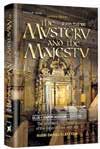

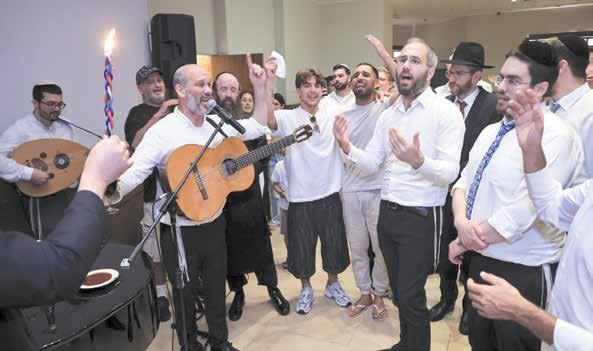

“Igrew up in a family of Slonimer Chassidim in Meah Shearim,” shares Tzili Shneider, founder of Kesher Yehudi, an organization whose aim is to unify all sectors of Israeli society. “My mother taught us that there’s no such thing as charedi, left, right, Mizrachi, chiloni. ‘There were only two options as far as Jews were concerned,’ she would tell us, ‘a Jew and a non-Jew.’” As Tzili grew up, however, she saw that Jews were not holding by that. She felt the large divide between charedi and chiloni jews was disastrous for both sides.
“The Jewish people have been a nation for 2,000 years, spread throughout different countries across the world. They spoke different languages, ate different foods, yet always knew a Jew was a Jew. Now that we’re miraculously back in our land, now we’re going to
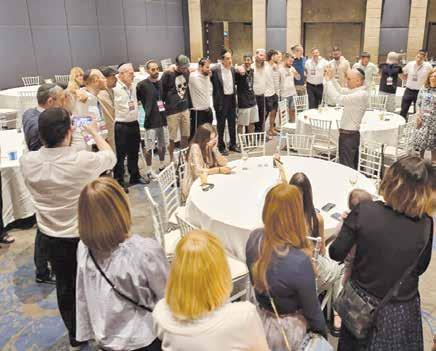
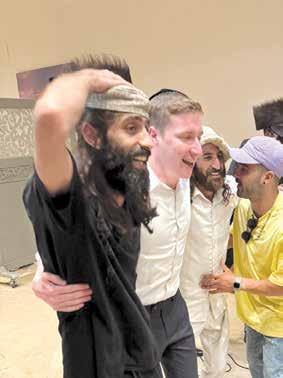
start dividing into different groups? We need to return to being one nation with one tradition. There’s no place for hate. We’re partners in our history, daughters and sons who all stood at Matan Torah, all descendants of our holy Imahos and holy Avos.”
Tzili recalls the Six Day War. “I remember dancing in the streets as a young child. One soldier took me on his shoulders and danced with me. No one thought about whether one was charedi and the other wasn’t, who was dati and who wasn’t. We were all together. We had the Kotel. We were so excited!”
As the years progressed, the chasm between the different groups was just widening. Something had to be done. However, Tzili felt strongly that any reconciliation was not going to come through the media, the government, the army, or Bagatz (the Israeli Supreme Court).
By Malkie SchulMan
“We needed a grassroots organization made up of regular people, people willing and able to sit with each other and talk face to face, people willing to respect each other no matter how different their opinions are.”
And as no one was stepping up to the plate, in stepped Tzili to see what she could do.
That was 13 years ago, and to date, Kesher Yehudi has 34,000 people involved in their chavrusa programs.
“The charedi community today,” shares Tzili, “is big. If 200,000 charedim would learn with 200,000 chilonim, the face of the country would change.” But Tzili stresses, “the goal of Kesher Yehudi is not to make



chilonim religious; it’s not to turn them into charedim. Our goal is to unify all Jews, to bring achdut back to Am Yisroel.”
The turning point came during Tzili’s daily bus ride to her teaching job in the Jewish Quarter from her home in Ramot.
“I rode the same bus every day, and every day, I’d see the same chiloni woman sitting on the bus, also going to her job, also getting off at the same stop. Yet we never spoke. I remember saying to myself, how could it be that we’ve been riding on the same bus for four years and we’ve never spoken to each other? She’s married with children like me. She drops her children off at kindergarten like I do. What difference does it make that I’m dati and she’s chiloni? We both decided to live in Yerushalayim for the same reason; what’s the difference how she dresses?”
With a strong feeling that there was something “lo b’seder ” going on, Tzili embarked on her mission.
“We don’t have to agree on whether our sons should go to the army,” she insists, “and of course, I don’t agree with chillul Shabbos, but I do agree that all Jews are my brothers and sisters b’lev v’nefesh, and when we come together to talk, the conflicts disappear. Solutions will never come from fighting with each other, only when we come together in friendship and respect. The truth is,” she continues, “we don’t have the luxury of hating each other. Our enemies want to kill us. They couldn’t care less what political party we belong to. The Nazis didn’t care in Auschwitz, and neither does Hamas, Hezbollah, Iran, or any of the rest of our many enemies.
“When we started 13 years ago, I thought we’d get together maybe 50 chavrusas. By the end of the first year, we had almost 1,000 learning partners!” shares Tzili.
She and her husband sought guidance from Rav Elyashiv, zt”l, who was very enthusiastic about their goals, stressing this is what Am Yisroel needs today more than anything. Many of the people waiting outside to speak to him were upset about having to wait so long, but Rav Elyashiv insisted that Kesher Yehudi was the call of the hour and he wanted to be part of it. Every question the Schneiders asked, whether very serious or seemingly trivial, Rav Elyashiv gave total attention to.
One of the first shailas they had was regarding what to learn with a chavrusa when someone comes and doesn’t know what they want to learn.
“Rav Elyashiv immediately responded, ‘Learn Shabbos.’”
“But Rebbe,” Tzili said, “Shabbos is the last thing these people should be learning. For them, Shabbat is just a day of ‘don’ts.’ Shabbat is their one vacation day of the week, the day they go out with their kids, cook shnitzilim, go on the computer. They’ll go crazy having nothing to do all day. I don’t think we can take that away from them. It’s too hard.”
Rav Elyashiv insisted. He said, “If it’s not too hard for me, it’s not too hard for them. They think it’s hard, but it’s harder not to keep Shabbos. A life with no Shabbos is hard. Shabbos is a gift.” He continued, “In the Torah, there is no chiloni/charedi/Ashkenazi/ Sephardi, but there is a mechallel Shabbos b’farhesya. You help him to be a Jew if he isn’t mechallel Shabbos.” “We strictly adhere to Rav Elyashiv’s advice,” maintains Tzili, “and I felt it was a sign when our last Shabbaton with the hostages’ families took place, unknown to us, on Rav Elyashiv’s yahrzeit.”
“Nevertheless, we are not about kiruv,” maintains Tzili. “We are about achdut. That’s why the Beit Hamikdash was destroyed, and that’s how we can rebuild it—with ahavat chinam.”
One of Kesher Yehudi’s most exciting innovations, what Tzili says is the heart of their organization, is a program they have with mechinat kdam tzevait, a pre-military academy in Eretz Yisroel. This one-year program prepares elite young men and women for army service and aims to develop the future leaders of the country. Kids today don’t have the burning idealism they had years ago, let alone Jewish knowledge. Consequently, there’s a need to train them for their future roles. Currently, there are 55 pre-military academies around the country where young adults learn subjects such as leadership, Jewish identity, Zionism, and Jewish history. Part of the curriculum is to recognize and understand Israel’s diverse populations, such as the Druzim, the Sephardim, the Ethiopians,
and the charedim.
“This was our entry point,” shares Tzili. “We explained to the academies that to learn about the charedim, their students need to experience our way of life.”
To do that, Kesher Yehudi brings a group of charedim that live near each school, and they set up chavrutot. Each month, a new topic that the chavrutot will discuss with each other is introduced from a Jewish perspective. A rabbi speaks about the topic, which may be anything from Creation to free will, to women’s rights in Judaism, to racism in Judaism. Then the group is split into chavrutot, and together, each pair learns the material. After 1½ hours, they leave but are encouraged to continue learning together the rest of the month. The following month, a new topic is introduced in the same way. Already they’ve had Shabbatonim with 31 academies. (They’ve had requests for Shabbatonim from nine more schools but unfortunately, had to turn them down due to lack of funding.)
Tzili stresses that the connections the partners make with each other are forever.
“We are not a ‘hit and run’ organization,” she quips. The pairs start off strangers, but after 20 minutes, they’re already close friends. Nevertheless, effort needs to be put in to maintain an ongoing connection. At the end of the year, there’s a big celebration.
“I always hear the same thing,” Tzili says, “just perhaps in different ways. The charedi partner will say, ‘I’m here because of my brave chavruta, Nir, an 18-year-old chiloni who is willing to be moser nefesh to defend me and keep our country safe. I can learn because he is prepared to fight.’ At the same time, Nir will say, ‘I’m here because of my shomer Shabbat chavruta, Yosi, because without him and people like him who are shomrei Shabbat and lomdei Torah, we wouldn’t be a Jewish nation. We would be a medinat goyim (a gentile nation). Because of him, I know why I am fighting. He needs to stay in yeshiva, because more than my own strength to fight the enemy, I need Hashem to help me.’
“On many levels, it’s an eye-opening experience. Not the least is that both sides get appreciation for the other. The charedi chavrusa gets an appreciation of how this young man or woman is willing to sacrifice




his life for his country, and the chiloni partner gets an appreciation of the Torah along with the understanding that there is no Jewish nation without our Torah and mitzvot. Long before the Tzahal came along, we survived as a people because we clung to our holy Torah.”
“The Torah was not given in Bnei Brak or Yerushalayim,” maintains Tzili. “It was given in the desert, so every Jew could access it.”
She shares one of Kesher Yehudi’s many success stories.
“Rimon, a chiloni chavruta, called me to ask how he could get in touch with David. He’d been trying all his numbers but couldn’t get through. I asked him what was so urgent. He said, ‘I’m in Aza but we were given a four-hour break to go out. I called my (chiloni!) parents, and we agreed that I should spend the time learning Torah with my chavruta.’ We located David and sent him in a taxi to Aza to learn in person with Rimon. When the other soldiers saw them learning, they said, ‘We also want to learn Torah.’”
Before the war, Kesher Yehudi had 4,000 chavrutot learning monthly, but since the war, they have 7,000 study partners (14,000 people!) learning monthly.
“Hamas taught us two things,” asserts Tzili. “One is that we’re all Jews, and two – we must stick together. Everyone is desperate for an end to the war, for the hostages to return home whole and healthy. I ask the families of the hostages why we are asking Bibi to bring them home. What can he do? What can Biden do? Nothing; it’s only Hashem. And what does Hashem want from us? He wants us to be unified. Let’s make a Shabbat together and observe it k’hilchata (according to the law).”
They all agreed, and so far, Kesher Yehudi has hosted two Shabbatonim for the hostages’ families together with charedim. The chilonim were adamant about keeping Shabbat completely.
The Shabbatonim for the hostages’ families were so successful that the next logical step was to make one for the Nova festival survivors. The Nova survivors understood they were saved for a reason, and they, too, were eager to come together to keep Shabbat, especial-
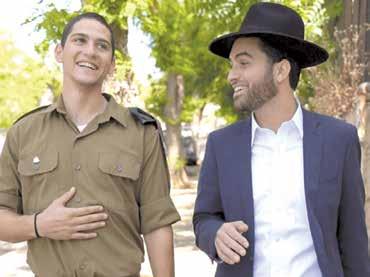
ly in the merit of the hostages’ return.
“There were 155 survivors who attended the first Shabbaton and 110 survivors at the second. Ninety percent of participants on both sides,” says Tzili, “pledged to keep up the connection. From these Shabbatonim, I saw that Am Yisrael chai, all Jews are special, all Jews are tzaddikim. Hashem chose all of us. He has good taste. Also, it was an eye-opener for the chilonim to see that charedim are warm and caring. Unfortunately, they just knew about charedim from the media’s perspective.”
were so strong in their desire to do something for the hostages that they held out the entire Shabbat and did not smoke, Tzili shares.
One Nova survivor, “Eitan,” was having suicidal thoughts. His friend tried to get him to come to a Kesher Yehudi Shabbaton, but he refused.
“When the friend arrived Friday afternoon without Eitan,” Tzili says, “I told him, ‘You’ve already been to our Shabbaton. The rule is you can only come again if you bring someone whose never been here before.’ At 6 p.m., he returned with Eitan.” Tzili tried to play for time. She told the desperate young man: “I understand your feelings. You can always go ahead with your plans if you want but maybe wait a day,” to which Eitan, thankfully, agreed.
“Here, there is so much holiness that it’s better to me than any drug-induced high.”
A released hostage, Aviva Segal (whose husband remains a hostage to date), joined a Kesher Yehudi Shabbaton. She related that she lived with her husband in Kfar Aza, and before October 7, she saw all people as equal. A Jew was no different from a non-Jew. She would always seek to help the Palestinians in her neighborhood. But she learned a big lesson in captivity. She learned that Jews are the most compassionate nation, and that is what makes them unique.
Although the chilonim were committed to keeping Shabbat on the Shabbaton, it wasn’t easy for some of them because they were addicted to smoking. Yet they
Shabbat was very moving for everyone, including Eitan. Rabbi Yisrael Goldwasser, a Gerrer chassid and well-known lecturer and historian, attended the Shabbaton. He brought with him a sefer Torah that had survived the death camps, known as the Sefer Torah of Block 12. Rabbi Goldwasser shared stories of inmates risking their lives to get an aliyah from the Torah. One day, the Germans discovered the Torah and executed the Jews found with it before taking it away to violate it. A non-religious inmate, anguished over the Torah’s desecration, crept out at night to steal it back. He wrapped the scroll around his body 80 times to keep it hidden. Although he was shot at and his blood spattered on the Torah, he was not critically injured. Miraculously, he managed to smuggle the Torah back to Block 12, where he hid it by removing a plank from the wooden bench upon which he slept and inserting the Torah inside. Every Simchat Torah until the war’s end, Jews would come to Block 12 and dance around the bench. Eventually, after the war, the Torah made its way to a shteibel in Bnei Brak.
Every year on Simchat Torah, Rabbi Goldwasser would take out the (now posul ) sefer Torah and dance with the remaining Holocaust survivors. This year, there were no survivors left, so Rabbi Goldwasser danced in the center of the room alone with the Torah. While he was still dancing, the news came that war had broken out. Rabbi Goldwasser quickly placed the scroll back in the aron as the congregation began to recite Tehillim.



“And now, nine months later,” said Rabbi Goldwasser to the assembled crowd, “we can finish my Simchat Torah dance. The Arabs took away Simchat Torah this year, but the sefer Torah has waited all year for people to come and dance with her. At the Nova festival on October 7, you were dancing a rikud shel chol (a nonJewish dance). Today, we will dance for Hashem, with His Torah.”
“At that point the room was silent,” says Tzili, “it felt like Matan Torah. Rabbi Goldwasser called the men in the room to gather around and dance with the sefer Torah. After that, the women came forth to dance with the sefer Torah. Everyone danced with the Torah, separately and in a group, the chilonim and charedim together. Everyone cried as together we sang, ‘Torat Hashem Temima’ to the heavens. We all knew then that we are nefesh echad (one soul), not because of our Israeli flag but because of our holy Torah.”
Then the troubled young man, “Eitan,” took his turn to dance. He said, “I want to see the blood on the Torah because I understand that inmate.”
Rabbi Goldwasser opened the Torah and on Parshat Matot-Masei, there were the bloodstains. Eitan asked for a tallit, and with the tears pouring out of his eyes, he read the entire Shema Yisrael out loud.
“I don’t believe anyone who was there,” says Tzili, “will ever forget that moment.”
Tzili tells the story about Micha, a Nova survivor who was addicted to drugs and vowed to put on tefillin daily and keep three Shabbatot in a row after he was miraculously saved from the terrorist attack on October 7. He was on the way to the festival with three friends when they were attacked. The driver was shot and killed, when the car came to a halt. All the doors flew open, as he and his friends toppled into a ditch. They were shot at from all sides, and one friend was killed but Micha and his friend remained alive. Micha lay in the ditch for many hours, trying not to breathe so the terrorists wouldn’t realize he was still alive. The street was filled with Arabs yelling, “Allahu Akbar” and shooting wildly, but for some reason, the bullets never hit him. As he lay there, Micha said to Hashem, “If You save me, I’ll keep three Shabbatot and put on tefillin every day.” When the army arrived, after 6½ hours, he and his friend were half-dead. The army

didn’t know if he was a terrorist or a Jew because he had dark skin and a long beard. They told him to say, “Alef beit,” but he couldn’t get it out. They were about to kill him when, as he tells it, his neshama cried out, “Shema Yisrael, Hashem Elokeinu, Hashem Echad.”
The officers put down their guns and rescued him.
Micha was in the hospital for a month, and when he left, he kept his vow to put on tefillin every day. However, keeping Shabbat was too hard because of his smoking and drug addiction.
Tzili continues, “When I asked him why he came
“We all knew then that we are nefesh echad (one soul), not because of our Israeli flag but because of our holy Torah.”
success in keeping Shabbat.
“I tried for nine months to keep Shabbat but couldn’t. Why? Because I smoked for a high, and at home, nothing but my drugs gave me a high. Here, there is so much holiness that it’s better to me than any drug-induced high. It wasn’t even hard for me.”
“I told the charedi chavrutot, you never had such an opportunity for mesirut nefesh for Shabbat. Even if it’s a boiling hot day in August, and you forgot to turn on the air conditioner, you would never think to turn it on. It was a great lesson for them to see their brothers and sisters holding fast to the challenge even though it was excruciatingly difficult. We’re not in the times of the Maccabees or the Holocaust. This is the mesirut nefesh of our generation,” Tzili maintains. “And on the charedi side, when the chiloni sees that an avrech with ten children is willing to live so simply for the sake of learning Torah that is their mesirut nefesh.”
Indeed, every participant at the Shabbaton was so inspired that after Shabbat when everyone was asked if they wanted to sign up to commit to continue learning with the chavruta they’d been paired with over Shabbat, every single individual signed up.
“We can all make a difference,” asserts Tzili. “Everyone can be part of this revolution. Those of us in Israel can befriend a chiloni Jew and learn Torah with them. All my children, my sons and sons-in-law in kollel and my daughters and daughters-in-law have multiple learning partners.”
to the Shabbaton, he said he’d promised Hashem he would keep Shabbat, but he realized he needed help. He felt that with other people’s support, he’d be able to keep it. Shabbat morning came and Micha said, ‘Tzili, I’m still keeping Shabbat.’ ‘Every moment you keep it is precious, ‘I told him. But he made it through the entire day and told his story to the group Motzei Shabbat. All the survivors clapped and chanted, “Micha Melech Yisroel, shomer Shabbat; Micha Hagibbur, Melech Yisroel, shomer Shabbat.”
Micha had tried for nine months to keep Shabbat every single week. Micha then shared the secret of his
Even for those in chutz l’aretz, though they can’t have a chavrusa with a chiloni, can support the cause through adopting an academy. Tzili’s greatest desire is to establish programs in all the 55 pre-military academies.
“We had 1,600 new soldiers graduating from the academies we’re involved with, 1,600 young men and women who now know how to talk to Hashem, who know why they’re fighting. They understand it’s Hashem Who will save them and not their ammunition. Before learning with their chavrutot, they didn’t know that they could even pray to Hashem.
“This is how we’ll bring the hostages home.”

By Bentzion Ettlinger
It is said that Rav Eliyahu of Vilna, the Vilna Gaon, displayed great simchah at the time of tekias shofar. The Gaon expressed that on Rosh Hashana, we should feel the great sensation of a nation that is coronating its king. The Vilna Gaon’s talmid, Rav Chaim Volozhiner, also displayed great simchah, and said one should have great simchah and chedvah like on the coronation day of a king. So too are we declaring the Ribbono shel Olam as King of the world.
The Maor VaShemesh relates the following about the Chozeh of Lublin: The rebbe Rav Yaakov Yitzchak HaLevi Horowitz, known as the Chozeh of Lublin, was a talmid of the Mezritcher Maggid, the Berditchever, Reb Shmelke of Nikolsburg, and the rebbe Reb Zusha. His main teacher was Rebbe Elimelech of Lizhensk.
The impact of the Chozeh on chassidus is indescribable. The vast majority of chassidim today are from streams that were talmidim of the Chozeh. Most Chassidic thoughts today are reflective of the Chozeh’s teachings, even more than of the Baal Shem Tov’s teachings. Considering this, it is no wonder that the Chiddushei HaRim said, “We refer to him as ‘the Rebbe of Lublin,’ because he is ‘the Rebbe’ until Mashiach’s days.” In Belz, too, the Chozeh was referred to as “the Rebbe of Lublin.” The Sar Shalom said, “The Lubliner was the rebbe of all Yidden, even of Yidden who know only of Torah She’bichsav [probably referring to the Maskilim], and even of those who are horse thieves.”
This widely circulated story occurred on Rosh Hashana 1815 (which was not long before his holy neshama left this world).

The chassidim of the Chozeh were shifting in their seats uneasily. Shacharis of that first day of Rosh Hashana had ended some time before, and they were now waiting for the blowing of the shofar to begin. However, it was impossible to start because the Chozeh had not yet come out of his room.
As was his custom every Rosh Hashana, he had gone into his study after Shacharis. In the quiet seclusion of his room, he was able to sense what the new year would bring for all of Klal Yisrael. If it had been decreed that the year would be one of peace and prosperity, he would only tarry a few minutes in his study. If, chas v’shalom , it was to be a year of harsh judgments against the Jewish People, the Chozeh would not budge from his room until he had found some way to soften the decree. Everyone in the packed shul knew what the long wait meant. They could almost sense the tension in the air as the Chozeh, behind closed doors, engaged in a mighty struggle to defend Klal Yisrael before the Heavenly court. But how and when the struggle would end, no one knew.
Rav Dovid of Lelov was one of the chassidim sitting in the shul. Each year, he would make his way from Lelov to Lublin to be with the Chozeh for Rosh Hashana. With him was a young orphan whom Rav Dovid was raising in his home. Rav Dovid tried to remain calm and focused on his own lofty thoughts, but even he was not immune to the mounting tension. Finally, Rav Dovid, one of the Chozeh’s closest talmidim, got up and approached the Chozeh’s study.
Rav Dovid entered the study with his young ward close in tow. Rav Dovid explained to the Chozeh the tension gripping those waiting to hear tekias shofar. The Chozeh, unperturbed by his talmid’s entry into
his study, said to Rav Dovid that the fear of those in the minyan was not unfounded. A terrible decree was hanging over Klal Yisrael.
Rav Dovid did not know what to say. The silence was gripping!
After a few minutes, the Chozeh noticed the young boy who had accompanied Rav Dovid. “Who is this boy?” asked the Chozeh. Rav Dovid explained the boy’s story and why he was with him. The Chozeh then asked the child what inyan he was learning in cheder. The boy quickly responded that he was learning the halachos of eidus. The Chozeh then asked the boy if he had any chiddushim on the topic. Rav Dovid was taken aback at the interest the Chozeh had taken in the child, especially at a time like this. It did not seem appropriate to ask the boy about what he was learning when the entire tzibbur was waiting and the fate of Klal Yisrael seemed to be hanging over them.
The child was very confident in his limud and was eager to share what he had learned. He didn’t hold back from telling the Chozeh that he was learning the halachos regarding saying testimony about a relative. The boy, who was himself an iluy, a child prodigy, and eventually became a rebbe (Rav Yitzchak of Vorki), said he had a problem understanding why it is that a relative is not permitted to testify for or against his family member.
“I can understand why he can’t testify on behalf of his relative,” the boy said, “as he may just want to have the charges against his relative dropped, and therefore might not say something that could be trusted. But why can he not testify against his relative?”
The Chozeh listened intensely as young Yitzchak was speaking. It seemed to Rav Dovid that the Chozeh himself had this question that had to be resolved right away.

The Chozeh asked the child if he had thought about a possible answer to the question.
“Yes,” came the response from the boy. “I have an answer I was satisfied with.”
“Please tell me your thought,” said the Chozeh.
The child answered, “We see the Torah refers to witnesses as anashim, people. From this we see that a witness must be someone whom we would be able to place in the category of ‘people.’ A person who would willingly offer testimony against a relative does not fall into the category of humanity. Therefore, he is invalid as a witness.”
Upon hearing this, the Chozeh clapped his hands and began to smile.
“Thank you, my child,” the Chozeh said warmly. “Your words have nullified all the accusations that threatened us in the Heavenly court.”
The Chozeh quickly stood up and prepared to return to the shul so that tekias shofar could begin.
Rav Dovid, however, could not let his rebbi leave the room without an understanding of what had just occurred. “Rav Dovid, this is a matter that even a child can understand. Are we not the sons of Hakadosh Baruch Hu? Is He not our Father? Since we are His relatives, how can any evidence be brought against us in the Heavenly court?”
Both the Mikdash Yisrael and the Leket Yosher discuss what happens if someone dozes off during tekias shofar. They both conclude that the dozer would not be yotzei for those kolos he missed. The Mikdash Yisrael adds that if a person becomes deeply “fartracht,” meaning oblivious to his surroundings, spaced out, and thinking of other things, thus not paying attention to the kolos, there is a fear that he also would not be yotzei. At a minimum, doing a mitzvah thoughtlessly has no taam, no taste.
This reminds us of a story often told by Rav Shimon Schwab.
In the early 1930s, when Rav Schwab was a talmid in Mir, he returned home to Frankfurt but did so taking a detour via Radin to spend a most memorable Shabbos there and see the Chafetz Chaim. Rav Schwab was there for forty-eight hours…forty-eight hours that lasted a lifetime! The visit provided him with a lifetime of experiences and learning that inspired him, his talmidim, and the attendees of major Agudath Israel gatherings with whom he shared these experiences.
On Friday night, the Chafetz Chaim spoke and discussed the mahn. The Chafetz Chaim mentioned that whatever one had in mind for a taste is what the mahn tasted like. This was so even if a person just had it in mind as a thought but didn’t express it. He just thought of it — “hat gebeben a tracht ” — and the mahn would assume the taste that person thought of.
The Chafetz Chaim then asked, “What occurred if a person did not have a thought at all? What kind of taste did the mahn have then?”
Rav Schwab said he remembers vividly how the
Chafetz Chaim asked the question and waited for someone to give the answer. He looked around, right and left across the room to see if someone had an answer. Inquisitively, he panned the room and asked, “Haaah?” He then repeated, “What kind of taam did the mahn have if someone didn’t think of anything?”
Since nobody gave an answer, the Chafetz Chaim said, “I will tell you. If one doesn’t think, it has no taste! In ruchniyus, if you don’t think, you have no taste!”
The Chafetz Chaim then threw in a word that was only caught by those who knew what he was talking about. He said that with regard to terumah, the Torah says “v’nechshav.” He said just that word. He did not elaborate, but he was referring to the fact that for a davar she’b’kedushah, one has to have a machshavah. Then he continued, “If a person learns a blatt Gemara and doesn’t think, it has no taste.”
If, chas v’shalom, it was to be a year of harsh judgments against the Jewish People, the Chozeh would not budge from his room until he had found some way to soften the decree.
ry: While in Moscow, the Russian czar issued terrible edicts banning Jews from Moscow and forcing them to settle in what was called the Pale of Settlement. He threw out all the Jews who were living there at the time. As the chief rabbi, Rav Berlin felt the imperative, as the captain of a sinking ship, to stay until everyone left. The czar allowed a few Jews who were needed by the government to remain for a time. Rav Berlin was also permitted to remain.
Needless to say, any davar she’b’kedushah was difficult to perform and had to be done with tremendous mesirus nefesh. When Elul came around, the remaining Jews in the city sought to be able to be mekayem the mitzvah of tekias shofar for Rosh Hashana. They searched and searched and were able to come up with just a single shofar. As Rav Zilberstein relates, the Satan was able to “mish” his hands in, and they found the shofar was cracked lengthwise from end to end, which unquestionably makes the shofar pasul. It appears that repairing it was not an option. This was the only shofar they were able to find in the entire city. What was this gaon and tzaddik to do?
A person whose heart and soul pines to do the will of Hakadosh Baruch Hu does not sit by idly. Rav Chaim Berlin reviewed and reviewed the halachos until Rosh Hashana night. Even that wasn’t enough, so he stayed up all night learning the halachos, trying to figure out what to do. But it was to no avail. Morning came, and he made his way from the beis midrash to the shul, quite in despair because they would not be able to be mekayem the mitzvah of tekias shofar in a l’chatchilah way. (With no other choice, they probably could have blown that shofar, but without a bracha.)
The Chafetz Chaim then kissed his fingertips and exclaimed, “It’s so sweet. But one has to think. Without thinking, it has no taste.”
Rav Chaim Berlin was born in 1832 in the Lithuanian city of Volozhin and was niftar in 1912 in Yerushalayim. He was the son of Rav Naftali Tzvi Yehudah Berlin, known as the Netziv. His memory stands tall, as the great bastion of Torah, Yeshivas Chaim Berlin in Brooklyn, NY, is named after him.
Rav Berlin became the chief rabbi of Moscow in 1865. In 1889, he moved to Volozhin, where he was the head of the rabbinical court. In 1892, he became the chief rabbi of Kobrin (1892–1897), and then of Elizavetgrad (1897–1906). As the son of the Netziv of Volozhin, Rav Chaim Berlin was a cherished friend of Rav Shmuel Salant (1816–1909), the chief rabbi of Yerushalayim, from early on in their lives, and they corresponded very frequently. Eventually, Rav Chaim Berlin left Russia, joined Rav Salant in 1906, and settled in Yerushalayim.
Rav Yitzchak Zilberstein relates the following sto -
As Rav Berlin made his way to shul in the early morning, down the street he noticed a non-Jewish junk hauler pulling his wagon. As he got closer, he noticed in the wagon the shape of something familiar. He approached the wagon and, lo and behold, in a load full of all kinds of junk, there was a shofar in that wagon!
He approached the non-Jewish wagon driver and asked him, “To whom does that shofar belong?”
In a split second, the wagon driver respectfully said, “Oh, I’m so sorry. Forgive me, I didn’t know the shofar belonged to the rav.”
Rav Berlin then tried to establish if the shofar was made by a Jew or by a non-Jew. (Rav Zilberstein correctly wonders about this part of the story, because it doesn’t matter if the shofar was made by a Jew or a non-Jew. That is not me’akev, and certainly not if there’s no other choice. We can perhaps assume he was concerned that it was a shofar of avodah zarah, which would make it assur to use.) After pressing the junk man, Rav Berlin was able to establish that the junk collector had gone into an abandoned shul and collected it from there. (My question here is whether the non-Jew had ne’emanus. One would have to say that the junk man’s explanation was what we call l’fi tumo.) The junk collector thought that Rav Berlin was the rav of the shul from where he had gotten the shofar, and hence was quick to give it to Rav Berlin without him even having to ask — and without him having to buy

it, as it was Rosh Hashana!
This shofar stayed with Rav Berlin when he emigrated to Eretz Yisrael and eventually ended up in the hands of the tzaddik of Yerushalayim, Rav Aryeh Levin, father-in-law of Rav Yosef Shalom Elyashiv.
Rav Zilberstein explains that the lesson from this story is that no matter what the situation, a person has to work on trying to be mekayem a mitzvah. And even if there is no eitzah, still try to be mekayem. And when Hakadosh Baruch Hu sees his matzav, He will help to bring about the ability to be mekayem the mitzvah.
Saved by the Sound
Rav Elazar (Margolis) Roke’ach, author of the Maaseh Roke’ach, was born in Krakow in the late 1600s. He became rav in Brody and then Amsterdam. Later in life, he decided to move to Eretz Yisrael.
In the mid-1740s, travel to Eretz Yisrael was by boat, of course, and his trek there found him still on the boat on Rosh Hashana. During the first night, hashgachah pratis brought them a huge storm, and the conditions were such that the ferocity of the sea punched a hole in the hull. Water began to enter the ship, and the potential of floundering at sea became a stark reality.
The passengers and crew reacted as one would expect, and in a desperate attempt to save themselves, they began to bail water from the ship. The two travelers who accompanied the rav noticed that he was not there with the other passengers trying to save the ship. Immediately, they ran to the rav’s room and found him deep in thought and mental preparation for tefillah for the morning of the great Yom Hadin, which was to commence shortly. They advised the rav as to what was going on, crying out in great distress that the ship and all the passengers on it were in grave danger.
“In a short time, the ship will sink!” they cried.
When Rav Roke’ach heard about the great peril, he exclaimed, “If this is the case, prepare yourselves to stand by me at the moment of alos ha’shachar to perform the mitzvah of the day, tekias shofar.”
This they did. The earliest time to perform the mitzvah arrived. The shofar was blown and, miraculously, chasdei Hashem prevailed. The wind died down, the waves subsided, and the boat was able to make it to port.

halt the storm. This was not the intent of Rav Elazar Roke’ach. When he heard about the grave danger and that there was no normal way to save the ship from sinking, he simply had a tremendous desire to be mekayem the great mitzvah of tekias shofar prior to leaving this world. And because of his greatness, the performance of that holy mitzvah saved their lives.”
A story very similar to the one above is said to have been told by Rav Simchah Bunim of Peshischa about the Admor of Mashpitveka.
It’s entirely possible that over the years, having been told often, a single story bifurcated into two tales. Such is the desire of a holy Yid to do as many mitzvos as he can in his lifetime, as “Hayom la’sosum u’l’machar l’kabel sachar, today to do them and tomorrow (in the World to Come) to reap the rewards.”
shofar in the Rizhiner beis midrash was extremely powerful, flawless and fear-inducing, as tekias shofar should be. Interestingly, the shofar used to perform the mitzvah that year had an unusual shape and it sounded quite frightful — a sound never before heard in the Rizhiner beis midrash. After Rosh Hashana, this shofar mysteriously disappeared.
This shofar was brought to Ruzhin by a chassid as a gift for the Rizhiner literally minutes before Rosh Hashana and, after the holiday, it disappeared completely.
Morning came, and he made his way from the beis midrash to the shul quite in despair because they would not be able to be mekayem the mitzvah of tekias shofar in a l’chatchilah way.
Rav Shlomo Kluger, also known as the Maharashk, was chief dayan and maggid of Brody, Galicia. A very prolific mechaber of sefarim, he wrote 160 sefarim in his lifetime. Many of them have never been published. He also served as rav in Brezany, Rava-Ruska (Galicia), and Józefów (Lublin). He actually left Brody at one point but then returned later.
Known for his straightforward approach, Rav Kluger once admonished a baal tokeia prior to tekias shofar and told him, “ Tekias shofar is a chochmah , not a melacha h,” meaning that it’s a cognitive skill — a knowledge, not work.
That being the case, the baal tokeia must realize what the primary cognitive skill is! What may that be? Of course, we say it first thing when we get up each morning: “Reishis chochmah yiras Hashem” ! The baal tokeia must recognize that the first of all cognitive skills is fear of G-d. Rav Shlomo Kluger meant that this is what the baal tokeia must know!
One Hundred Thousand Kolos
At the end of the life of Rav Yisrael of Ruzhin (the Rizhiner), his son, Rav Dovid Moshe of Chortkov, was not well. So that his son could benefit from the zechuyos engendered by his father, the son’s bed was moved into the room especially set aside for the Rizhiner to daven in. This was a small room, a private area built into the Rizhiner’s larger beis midrash.
When Rav Simchah Bunim of Peshischa heard about the incident, he said, “Don’t think that the blowing of the shofar was done to invoke a segulah to
Rav Dovid Moshe recovered from the illness, and many years later said that the tefillos of his father were not, as we would say today, “stam.” They weren’t just ordinary tefillos. He said his father’s tefillos were on a much higher plateau, way beyond the way someone would normally daven. Rav Dovid Moshe said his father’s tefillos rose high above that of a normal human being. It was especially the case since at the time the Rizhiner realized his own health was failing and his potential for longevity was compromised. Rav Dovid Moshe said, “After davening, my father mysteriously said, ‘Today during the blowing, I heard the shofar of the Mashiach.’” The reality that year was that tekias
The Kedushas Levi, Rav Levi Yitzchak Berditchever, had the custom to say the following right before tekias shofar : “Ribbono shel Olam! You have commanded us in our holy Torah through just four words: ‘Yom teruah yihiyeh lachem — A day of teruah it shall be for you.’ From these few words, Chazal expounded and learned tekiah, shevarim-teruah, tekiah. Because of doubts [or differing opinions] as to the exact meaning of the words, B’nei Yisrael have become accustomed to blowing one hundred kolos on both days of Rosh Hashana.
“We find, then, that two hundred kolos have been blown each year from tens of thousands of shofaros in tens of thousands of shuls over the course of thousands of years. The sum total is that countless kolos, myriads of thousands of kolos, have been blown. In exchange for that, we ask You to blow only one tekiah. Blow the great shofar to signal our freedom. This request comes from all of Klal Yisrael — each one of us in our tefillos, three times a day, for two thousand years since the Beis Hamikdash was destroyed. We ask You just to blow one tekiah. Why do You not fulfill our request?”



By Ra BBi a kiva Willig

On the night of Rosh Hashana, shouldn’t we make the bracha on the date first, and not on the apple, as the date is one of the shiv’as ha’minim and gets priority over the apple?
The Gemara in Berachos is clear that any one of the fruits of Eretz Yisrael has precedence over other fruits; the bracha of Al Ha’eitz should be said on the fruit from the shiv’as ha’minim when there are also other fruits in front of a person. However, the Gemara cites a debate regarding an instance in which the other fruit is more desirable (chaviv). If one wants to eat a date (one of the shiv’as ha’minim) and an orange (which he prefers), on which should he recite the bracha? The Rishonim debate this issue. The Shulchan Aruch first records the position of Tosafos that shiv’as ha’minim trumps chaviv. The bracha is thus said on the date. However, the Shulchan Aruch then cites the opinion of the Rambam that chaviv is the decisive factor, and the bracha is thus said on the orange. The Mishnah Berurah writes that the first opinion in the Shulchan Aruch should be followed. Based on this, if one plans on eating apples as well as dates or pomegranate, the bracha should be said on the shiv’as ha’minim fruit and not the apples.
Nevertheless, in the context of the laws of Rosh Hashana, there are other opinions. The Shulchan Aruch notes the custom to eat various foods to serve as good omens for the new year, among them a date. The Rama adds the custom to eat an apple with honey. Interest-
ingly, the Maharil (cited in the Darkei Moshe) writes that the bracha is said on the apple, and the Tur’s language indicates this as well. In fact, the Mishnah Berurah and the Chayei Adam both write that the bracha is said on the apple. The rationale seems to be that because the apple dipped in honey is specified and is deemed to be significant, it therefore takes precedence. While the Kaf Hachaim writes that the common custom is to say the bracha on the apple and eat it first, he also writes that the correct halachic practice is to recite the bracha on a date or pomegranate because they are of the shiv’as ha’minim.
To solve this problem, he suggests that the dates or pomegranates not be present on the table when the bracha is said on the apple, as the shiv’as ha’minim have precedence only if they are present when the bracha is said. Rav Shlomo Zalman Auerbach suggests this as well. If one recites the bracha on the apple when the pomegranate or date is not present, he should have in mind that the bracha “covers” those other fruits as well.
When blowing the minimum thirty kolos on Rosh Hashana for a woman or choleh, is the shevarim-teruah blown in one breath or two?
The Gemara notes that since the day of Rosh Hashana is referred to as “Yom Teruah,” we are to blow a teruah, a broken sound, with the shofar. The Gemara
further derives from the pasuk of “V’havarata shofar teruah” that a tekiah is sounded both before and after every teruah. The Gemara then learns from the fact that the word teruahis mentioned three times that we must hear the sequence of tekiah-teruah-tekiah three times, leading to a total of nine kolos. The notion of blowing thirty kolos is attributed to Rabbi Avahu. The Gemara explains that although it is clear that a teruah is the sound of a broken cry, it is not clear if it is “yaluli yalil,” a weeping sound (the nine short blasts of what we call a teruah) or “ganuchi ganach ,” sobbing (the three medium blasts of what we call shevarim), or perhaps sobbing leading into weeping (shevarim-teruah). Because it is unclear, all three of these possibilities must be blown on Rosh Hashana; it does not suffice to simply blow tekiah-shevarim-teruah-tekiah, because if this is not the correct way, there will be an interruption between the tekiah and the correct version of broken blast. The Gemara states that we blow at two different times, and it is based on this that we blow sixty kolos. The Rishonim debate the proper way to blow the shevarim-teruah. Should it all be blown in one breath (neshimah achas), or should there be a break between them (sh’tei neshimos), as the shevarim and teruah are separate sounds? The later Acharonim further debate if the latter view requires that a breath be taken between the sounds or if a pause between them suffices. The primary argument in favor of neshimah achas is

that because the two sounds are fulfilling the teruah mandated by the Torah, they are really one. The reason to argue for sh’tei neshimos is that these two sounds are not ordinarily cried in one breath.
The majority of the Rishonim, including Tosafos, the Ramban, and the Rosh, favor neshimah achas and maintain that the mitzvah is not fulfilled if one blows with sh’tei neshimos. Other Rishonim, although a minority, hold that one is yotzei even if the sounds were blown b’shtei neshimos. Conversely, most Rishonim who favor shtei neshimos concede that one is yotzei with neshimah achas. The notable exception is the Terumas Hadeshen, who maintains that one does not fulfill the mitzvah if performed b’neshimah achas, as it is not considered regular to blow in this way.
The Shulchan Aruch cites both opinions as to how to blow the shevarim-teruah adding that a yerei Shamayim should blow both: During the first thirty blasts (tekias d’myushav), the shevarim-teruah is blown b’neshimah achas, and during the second set of thirty blasts (tekias d’myumad ), they are blown b’shtei neshimos. However, the Rama writes that the custom is to blow all the blasts b’shtei neshimos. The Mishnah Berurah notes that blowing b’neshimah achas is the safer option, as almost everyone agrees that one is yotzei that way, and for this reason, many poskim seem to disregard the view of the Rama.
The Mishnah Berurah further notes that the instructions of the Shulchan Aruch do not apply when blowing the full set of nine kolos for each of Malchuyos, Zichronos, and Shofaros during the tekias d’myumad, as is in fact our custom. Thus, neshimah achas is more appropriate for all the blasts. Rav Hershel Schachter writes that the custom of Rav Soloveitchik, in the tradition of Rav Chaim Brisker, was to blow exclusively b’neshimah achas for all sixty kolos, because this is acceptable to virtually all the Rishonim. Nevertheless, when blowing the additional forty blasts at the conclusion of davening, in accordance with the custom to blow one hundred blasts, the shevarim-teruah should be blown b’shtei neshimos, in deference to the other view. Based on this approach, if one is blowing only thirty kolos, all the shevarim-teruah blasts should be blown in one breath.
Is there any source for the “minhag” to throw breadcrumbs to the fish during Tashlich, and are there any halachic issues with this practice?
The Rama records the custom to go to a river on Rosh Hashana and recite the pasuk, “V’tashlich b’mtzulos yam kol chatoseinu.” In the Darkei Moshe, the Rama cites the original source of this custom as the Maharil, who bases it on a Midrash that describes how on his way to Akeidas Yitzchak, Avraham Avinu passed through raging waters that reached his neck, and when he called out to Hashem for help, he was saved.
The Rama adds that one should see live fish in the water as a siman that we should multiply like fish, and because fish are not affected by ayin hara. Numerous other explanations are suggested for the minhag of Tashlich, but the idea is that by visiting a body of water, we invoke the merit of Avraham Avinu and the
Akeidah, which has a prominent place on Rosh Hashana. Additionally, perhaps we wish to “recreate” his experience and demonstrate our absolute devotion to Hashem in all circumstances. This may be the reasoning of the Magen Avraham, who writes that the body of water should ideally be outside the city, just as Avraham traveled to Har Hamoriah.
In addition, as the new year begins, we hope for a year of proliferation and freedom from the ayin hara, as represented by the fish. The Levush writes that we should view ourselves as fish, which can be caught in a net at any moment; similarly, at every moment we are entirely dependent upon Hashem. This realization should move us to do teshuvah.
By visiting a body of water, we invoke the merit of Avraham Avinu and the Akeidah, which has a prominent place on Rosh Hashana.
The Mateh Ephraim mentions the custom of shaking out one’s pockets as part of the Tashlich ceremony. He explains that this symbolizes casting away our sins; we cleanse our garments with the hope that we have only begadim levanim in the future. It is possible that the “custom” of throwing bread into the water was rooted in this idea of casting away sins.
The Maharil himself implies that people would feed the fish at Tashlich as a way of entertaining the children, but he voices his opposition to this practice. He cites the Mishnah that prohibits one from feeding animals that are not dependent on him (i.e., house pets or domesticated animals) on Shabbos and Yom Tov. Rashi there explains that feeding these animals constitutes an unnecessary tircha. The Shulchan Aruch codifies the prohibition to feed fish on Shabbos and Yom Tov, and the Machatzis Hashekel thus reiterates the Maharil’s opposition to doing so during Tashlich. The Maharil adds that carrying food for fish is prohibited because one
is carrying unnecessarily on Yom Tov (if there is no eiruv). Although one is generally permitted to carry outdoors on Yom Tov (unlike on Shabbos), if there is no real purpose, it is prohibited to do so.
Based on the above, one should not feed the fish when reciting Tashlich on Rosh Hashana. However, those who say Tashlich during the weekdays of Aseres Yemei Teshuvah may certainly throw bread to the fish.
Is it permitted to insert personal bakashos at the end of Elokai Netzor on Rosh Hashana?
This question relates to two distinct issues, one related to Shabbos/Yom Tov in general and the other specific to Rosh Hashana. The Yerushalmi states that a person should not ask for his personal needs on Shabbos, and the Korban Ha’eidah explains that doing so may cause him to become sad or even cry when contemplating his problems. Nevertheless, we do say many standardized tefillos on Shabbos even though they contain some personal requests, such as Birkas Hachodesh and Yekum Purkan. The assumption is that because these tefillos are part of the standard text, one will not be overcome with anguish or grief when reciting them.
Based on the Yerushalmi, the Shulchan Aruch writes that we do not daven for the sick on Shabbos. The Shulchan Aruch adds, however, that if there is a life-threatening situation, one may daven for personal needs. Rav Shlomo Zalman Auerbach assumes that spiritual needs were never included in this prohibition at all. Thus, in general, one should not add personal tefillos to the Shabbos Amidah, but pressing and spiritual matters can be mentioned, and one could certainly argue that one’s personal requests are deemed pressing on Rosh Hashana. Nevertheless, the Rama writes that when Rosh Hashana falls on Shabbos, Avinu Malkeinu is omitted. The Magen Avraham explains that this is because personal requests are forbidden on Shabbos.
Although it seems that one should be permitted to make personal requests on Rosh Hashana, the Netziv limits this heter somewhat. The Zohar and other sources teach that Rosh Hashana is a day focused on Hashem’s majesty and what we can do to further His Presence in the world, and it is therefore inappropriate to make personal requests on Rosh Hashana. Nevertheless, it has become customary for individuals to ask for their personal needs on Rosh Hashana. While the text of the tefillah does not include such petitions, behind all personal requests is the understanding that only the Al-mighty King is capable of granting them.

Rav Shlomo Zalman Auerbach rules that when Rosh Hashana falls on Shabbos, one may insert personal tefillos in Elokai Netzor, and all the more so when Yom Tov is not on Shabbos.
This article has been excerpted with permission from the publisher from Rabbi’s Responsa – Moadim by Rabbi Akiva Willig, published by Mosaica Press.

By Danielle Renov

This is what I want for dinner most nights. After a long day of cooking breakfast, lunch, and dinner, testing recipes, and just general mom-ing, I’m tired and hungry. I don’t want something heavy because my body is too exhausted to handle anything like that. I want something light and crunchy, but it must have a chewy, hot and cold element to it. That’s what this is. The ground chicken crumble, which sounds crazy but I guarantee is quite genius, is so delicious and satisfying and together with the cold properly cut cucumber (although if you don’t properly cut your cukes, I won’t tell anyone), and the umami packed, punchy vinaigrette hits just the spot!
Ingredients
Chicken Crumble
» 1 lb. ground white or dark chicken
» 1 tsp freshly grated ginger
» 2 cloves garlic, grated
» 2 Tbsp soy sauce
» 1 Tbsp seasoned rice vinegar
» 1 tsp sesame oil
» 1 tsp sriracha
Asian dressing
» 3 Tbsp soy sauce
» 2 tsp sesame oil
» 1 tsp miso paste
» 2 tsp rice vinegar
» 1 clove garlic, grated
» ¼ cup water
Salad
» 2 baby bok choy, chopped
» 4 cucumbers halved, seeded, chopped
» 6 radishes, sliced
» 1 Thai chili, thinly sliced
» 4 scallions, chopped
» 1 tsp black sesame seeds
Chicken Crumble
Combine all chicken crumble ingredients in a medium bowl.
Heat a nonstick pan over medium high heat.
Add chicken mixture; cook, stirring often to break up mixture and create crumbles. This should take 6-7 minutes.
Once chicken is cooked through, turn off heat and set aside.
Asian Dressing
Add all dressing ingredients to a bowl or a jar with a tightly fitting lid. Whisk or shake to combine.
Store in an airtight container in the refrigerator for up to 2 weeks.
Salad
Add all the vegetables to a large bowl, along with chicken crumble. Drizzle dressing over the top, starting with 3 tablespoons and adding 1 tablespoon more at a time till it is dressed how you like it.
Garnish with black sesame seeds.
Variation: If you’re not a ground chicken lover (I’m looking, fine, talking, errrr, writing to you, Eli) you can absolutely swap out the same amount of ground chicken for turkey or beef.


Wait!!! Stop! Don’t turn the page yet!
I know. I know, it sounds scary, but really Hawajj is just a Yemenite spice blend, which you buy already mixed (woohoo for time savers!) And it is absolutely delicious. I already went through this with my kids and after literally bribing them to taste the soup (yes, I’m not above that!), they now request it on a regular basis. I love it because it’s not the typical meat soup flavor. The hint of sourness makes the soup completely irresistible, spoon after spoon!
» 2½ lb (1.13 kg) stew meat (1 inch cubes chuck)
» ½ cup flour
» 2 tsp kosher salt, divided
» 2 tsp coarsely ground black pepper, divided
» 1 Tbsp canola oil
» 1 large yellow onion, diced
» 3 carrots, peeled, cut into ¾ inch rounds
» 6 stalks celery, peeled, cut into ¾ inch pieces
» 7 red potatoes, peeled, cut into 1 inch cubes
» 4 cloves garlic, peeled, halved
» 3 Tbsp Hawaij for soup
» 2 Tbsp tomato paste
» 1 cup cilantro leaves + extra for garnish
» 10 cups water
» Rice, for serving
» Schug, for serving
In a large bowl, combine meat, flour, 1 teaspoon salt, and 1 teaspoon pepper.
Place a large Dutch oven or heavy bottomed pot over medium high heat. Add oil and meat.
Brown meat on all sides (about 8 minutes total).
Add onion, carrots, celery, potatoes, and remaining 1 teaspoon each salt and pepper.
Stir to incorporate vegetables with meat; allow to cook for 3-4 minutes.
Add garlic, Hawaij, and tomato paste. Stir to combine. Cook for 3-4 minutes, stirring often. Add water.
Bring mixture to a boil; reduce heat to low. Cover; simmer over low heat for 2-3 hours, mixing every once in a while.
Serve hot over rice with a dollop of schug, and enjoy!
Variation: Crockpot method: Turn crockpot to high. Add oil and meat mixture. Cover crockpot; cook for about 30 minutes, mixing meat every 10 minutes or so. (If lots of liquid accumulates at any point, just remove the cover until it evaporates). Add remaining ingredients except water. Stir to distribute spices and tomato paste evenly. Leave crockpot uncovered for 10 minutes, stirring every 2-3 minutes. Add water; cover the pot. Cook on high for 5-6 hours. If putting in the crockpot for Shabbos day, cook on high for 2 hours and then turn the crockpot to low.


When I was first married, my mother gave me a recipe from her close friend, Naomi, to make for Shabbos. It was a version of this chicken that I tweaked and tweaked over the years to create this easy but flavorful chicken. What I really love about this dish is that it’s a cooked chicken that you can reheat or serve at room temperature for Shabbos lunch because it is not saucy!
» 12 chicken cutlets
» 1 cup flour (I use spelt)
» 2 tsp kosher salt, divided
» 2 tsp coarsely ground black pepper, divided
» 3 Tbsp oil, divided
» 4 bell peppers (1 red, 1 yellow, 1 orange, 1 green), cut into ½ inch dice
» 1 onion, diced
» 4 cloves garlic, minced
» ½ cup sherry or white wine
» 1¼ cups chicken stock
Heat oven to 350°F/180°C. Coat a baking dish with nonstick cooking spray.
In a large bowl, combine flour, 1 teaspoon salt, and 1 teaspoon pepper. Dip each cutlet into flour, shaking off excess.
Heat a large pan over medium heat. Add 2 teaspoons oil; working in batches, brown chicken on both sides for 1 minute. Don’t cook through. Add oil as needed for each batch. Transfer chicken to prepared baking dish. Set aside.
Once all the chicken has browned, add remaining oil to the pan along with peppers, onion, remaining teaspoon salt, and remaining teaspoon pepper. Cook, stirring, for about 10 minutes, until pepper and onions have softened and released their juices.
Add garlic; stir for 1 more minute.
Add wine; simmer for 4 minutes. Stir in chicken stock.
Pour all the vegetables and pan juices over the chicken in the baking dish.
Bake about 35 minutes until the edges of the peppers slightly char.
Serve hot and enjoy.


An ode to the sushi restaurant in the Five Towns that came and went too quickly but served the best avocado egg rolls ever.
» 2 Tbsp chopped sundried tomatoes
» 4 avocados, cubed (2½ cups cubed)
» 2 Tbsp chopped cilantro
» ½ jalapeño pepper, minced
» 1 tsp kosher salt
» ¼ tsp coarsely ground black pepper
» 1 lime, halved
» 1 (9 oz) package egg roll wrappers (each cut in half diagonally to create 2 triangles) OR square wonton wrappers
» Oil, for frying (I like avocado oil)
Add tomatoes, avocados, cilantro, jalapeño, salt, and pepper to a bowl. Squeeze the juice of ½ lime over the avocados so they don’t brown. Gently mix to combine. Don’t overmix or the avocado will turn into guacamole and we’re not looking for that!
Place 1 heaping tablespoon of avocado mixture near the corner of an egg roll wrapper triangle, then brush the edges with a little water. Roll over once, then fold the sides of the triangle over and continue to roll till closed. Do the same thing (if using) the square wonton wrappers. Repeat with remaining avocado mixture and wrappers.
Heat 3-4 inches oil over medium high heat. Once oil gets to 350°F / 180C° (the handle of a wooden spoon inserted into the oil will have bubbles form around it), fry 5-6 at a time for about 3 minutes.
Transfer to a cooling rack to drain.
Serve with chipotle mayo, spicy green sauce, or any dip you like!
To reheat, place in a foil pan in a single layer and reheat uncovered!
Enjoy!
Note: I would not freeze these. Something about defrosted avocado just doesn’t do it for me. These recipes are reprinted with permission from Peas, Love and Carrots by Danielle Renov, published by ArtScroll/Mesorah.





